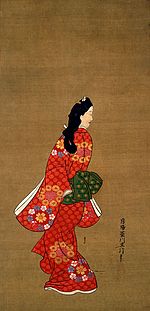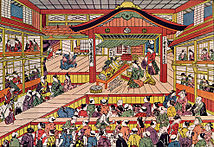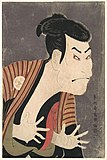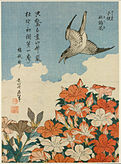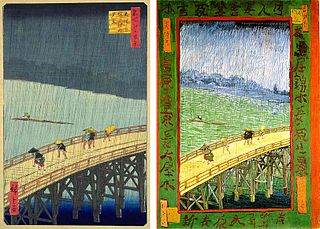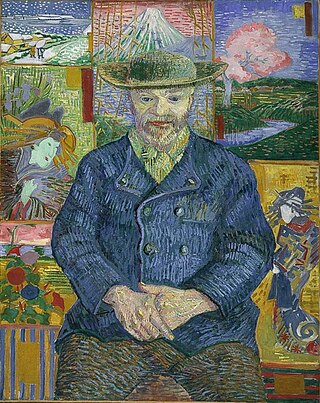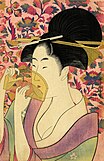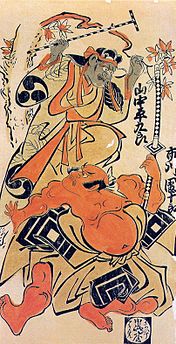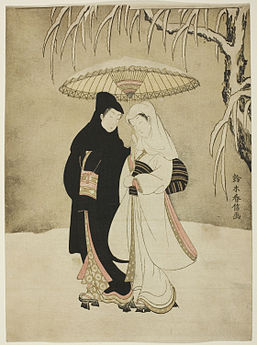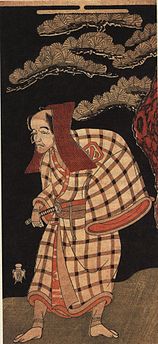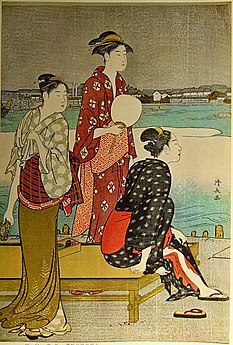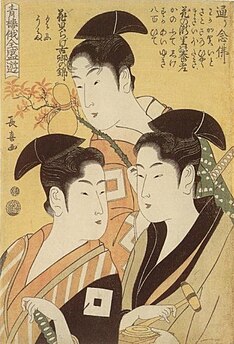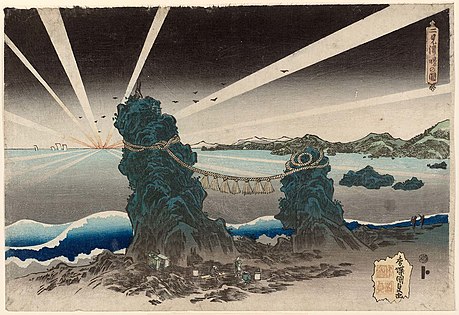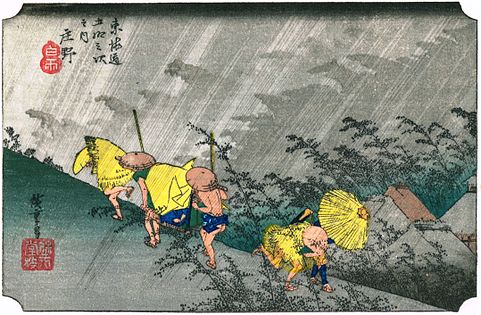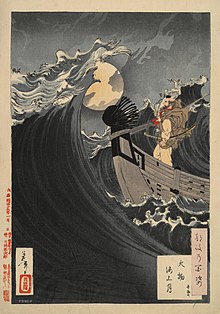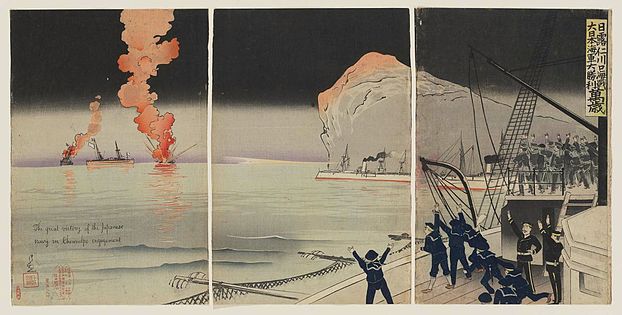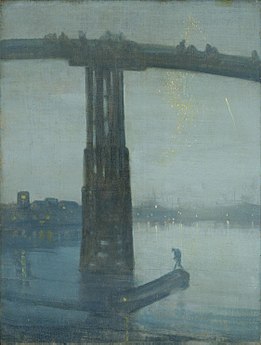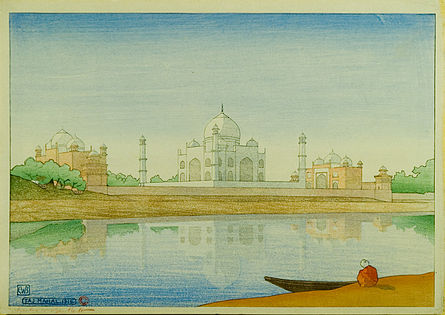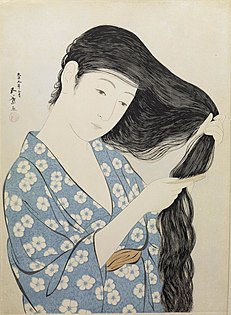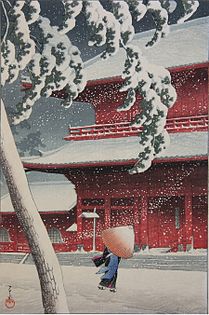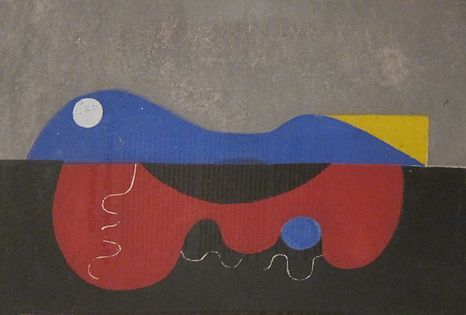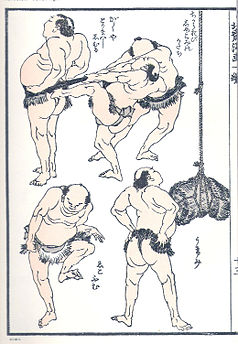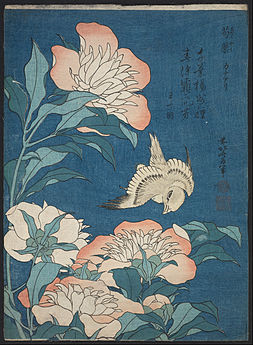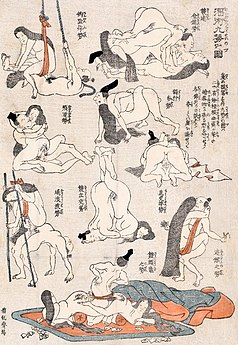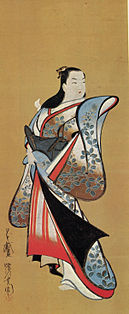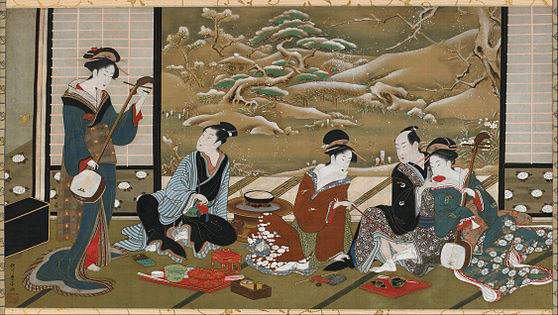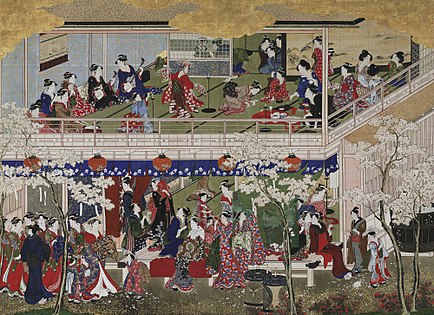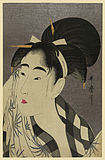| ||||||||||||
| 从左上到右下: | ||||||||||||
浮世绘(日语:浮世絵/うきよえ Ukiyoe */?)是17至19世纪兴盛于日本的一种艺术表现手法。创作者制作了各种题材之木雕版印刷画和手绘作品(肉笔浮世绘),主要题材有女性美人、歌舞伎演员、相扑选手、历史场景、民间故事、旅行场景、风景、植物、动物、情色描绘等。
1603年,江户成为日本政治权力中心之德川幕府的根据地。处于社会秩序底层的町人阶级(商人、手工业者和工人)从城市的高速经济增长中获益最多,开始沉迷和光顾歌舞伎、艺伎、花魁等所在之娱乐活动地区(游廓);浮世绘(“浮动的世界”)一词用来描述这种享乐主义的生活方式。印刷或绘画的浮世绘作品在町人阶级中很受欢迎,他们已经变得足够富有,可以用之来装饰自己的住家。
最早的浮世绘作品出现于1670年代,有菱川师宣的画作和以美丽女性为题材的单色版画。彩色印刷品而后逐渐出现,起初仅限于特殊委托。到1740年代,奥村政信等艺术家开始使用多个木版以印刷颜色区块。在1760年代,铃木春信的“锦绘”取得成功,全彩色制作开始成为标准,每幅版画使用 10 个或更多色块制作。 一些浮世绘艺术家专门制作绘画,但大多数作品都是版画。 艺术家很少雕刻自己的木版进行印刷; 相反,生产由设计版画的艺术家、切割木版的雕刻师、将木版上墨并压在手工纸上的印刷商,以及资助、推广和发行作品的出版商分别进行。由于印刷是手工完成的,印刷商能够实现机器无法实现的效果,例如印版上颜色的混合或渐变。
18世纪末之鸟居清长、喜多川歌麿和东洲斋写乐等代表性创作者的女性和演员题材之肖像画备受重视。19世纪也见证了浮世绘之杰出创作之延续,葛饰北斋创作了日本最著名的艺术作品之一《神奈川冲浪里》,还有歌川广重的《东海道五十三次》。在这两位代表性创作者过世不久后,在1868年明治维新之后的技术发展和社会现代化进程中,浮世绘的产量急剧下降。 然而,在20世纪日本版画再度兴起:“新版画”流派针对西方社会对日本传统场景版画的兴趣进行商业创作,“创作版画”运动促进了个人主义作品的出现,该类创作由一位艺术家独力设计、雕刻和印刷。自20 世纪末以来,版画一直延续著个人主义风格,通常采用从西方引进的技术制作。
浮世绘是19世纪后期形成西方对日本艺术看法的核心,尤其是葛饰北斋和歌川广重的风景画。1870年代起,日本主义成为一股显著的潮流,对埃德加·德加、爱德华·马奈、克劳德·莫奈等早期印象派画家,以及文森特·梵高等后印象派画家和亨利·德·图卢兹-罗特列克等新艺术运动艺术家产生了深远的影响。
历史
[编辑]“浮世绘”这一名词最早出现于1681年(天和元年)日本发行的俳谐书《各种各样的草》[1]。“浮世”一词是日本中世以来的佛教概念中相对于净土的充满忧虑的现世。它所指称在尘俗人间的漂浮不定,衍伸为一种享乐的人生态度,可以尽显于浮世绘里欢乐荣景的华丽刻划。
浮世绘画师以狩野派、土佐派出身者居多,这是因为当时这些画派非常显赫,而被这些画派所驱逐、排斥的画师很多都转向浮世绘发展所致。
初期
[编辑]明历大火(1657年3月2日)至宝历年间(1751年~1763年)。此时期的浮世绘以手绘及墨色单色木版画印刷(称为墨折绘)为主。
17世纪后半,后世尊为“浮世绘之祖”的菱川师宣将画面从册装图书的形式中彻底独立出来,创造了单幅版画“一枚拓”,成为浮世绘的基本样式。
到了鸟居清信时代,使用墨色以外的颜色创作的作品开始出现,主要是以红色为主。使用丹色(红褐色)的称丹绘,使用红色的称红绘,也有在红色以外又增加二、三种颜色的作品,称为红折绘。[2]
中期
[编辑]明和2年(1765年)至文化3年(1806年)。锦绘在此时期诞生。
因为画历(絵暦)在俳句诗人及爱好者间十分受欢迎,明和2年开始有了画历交换会的社交活动。为因应这种大量需求,铃木春信等人以多色印刷法发明了东锦绘,浮世绘文化正式迈入鼎盛期。
由于多色印刷法需反复上色,因此开发出印刷时如何标记“见当(记号之意)”的技巧和方法,并且开始采用能够承受多次印刷的高品质纸张,例如以楮为原料的越前奉书纸、伊予柾纸、西野内纸等。另外在产能及成本的考量下,原画师(版下绘师)、雕版师(雕师)、刷版师(刷师,或写做折师)的专业分工体制也在此时期确立。
此时期的人物绘画风格也发生变化,由原本虚幻的人偶风格转趋写实。
安永年间(1772年—1780年),北尾重政写实风格的美人画大受好评。胜川春章则将写实风带入称为“役者绘”的歌舞伎肖像画中。之后著名的喜多川歌麿更以纤细高雅的笔触绘制了许多以头部为主的美人画。
宽政2年(1790年),幕府施行了称为“改印制度”的印刷品审查制度,开始管制印刷品的内容。宽政7年(1795年),因触犯禁令而被没收家产的出版家茑屋重三郎为了东山再起,与画师东洲斋写乐合作,出版了许多风格独特、笔法夸张的役者绘。虽然一时间造成话题,但毕竟风格过于特异,并未得到广泛回响。同时期最受欢迎的风格是歌川丰国所绘的《役者舞台之姿绘》的歌舞伎全身图系列。而歌川的弟子们也一跃形成浮世绘的最大画派—“歌川派”。
后期
[编辑]喜多川歌麿死后,美人画的主流转变为溪斋英泉的情色风格。而胜川春章的门生葛饰北斋则在旅行话题盛行的带动下,绘制了著名的《冨岳三十六景》。受到葛饰北斋启发,歌川广重也创作了名作《东海道五十三次》、《名所江户百景》。此二人确立了浮世绘中称为“名所绘”的风景画风格。
在役者绘方面,歌川国贞师承歌川丰国,以更具力道的笔法绘制。另外,伴随着草双纸(类似现代的漫画书)所引发的传奇小说热潮,歌川国芳等人开始创作描绘武士姿态的“武者绘”。歌川国芳的水浒传系列非常受欢迎,在当时的日本引爆了水浒传风潮。
在嘉永6年(1853年)所刊行的《江户寿那古细见记》中有一句“豐國にがほ(似顔繪)、國芳むしや(武者繪)、廣重めいしよ(名所繪)”,简单而直接地为此时期的风格做了总结。
终期
[编辑]安政6年(1859年)至明治45年(1912年)。
此时期因为受到美国东印度舰队司令佩里(或译:培里)率领舰队强行打开锁国政策(此事件日本称为“黑船来航”)的冲击,许多人开始对西洋文化产生兴趣,因此发轫于当时开港通商之一的横滨的“横滨绘”开始流行起来。
另一方面,因为幕末至明治维新初期社会动荡的影响,也出现了称为“无残绘(或写做无惨绘)”的血腥怪诞风格。这种浮世绘中常有腥风血雨的场面,例如歌川国芳的门徒月冈芳年和落合芳几所创作的《英名二十八众句》。
河锅晓斋等正统狩野派画师也开始创作浮世绘。而后师承河锅晓斋的小林清亲更引入西画式的无轮廓线笔法绘制风景画,此画风被称为光线画。
歌川派的歌川芳藤则开始为儿童创作称为玩具绘的浮世绘,颇受好评,因而被称为“おもちゃ芳藤(おもちゃ为玩具之意)”。
但是由于西学东渐,照相技术传入,浮世绘受到严苛的挑战。虽然很多画师以更精细的笔法绘制浮世绘,但大势所趋,终究无法力抗历史的潮流。
其中,月冈芳年以非常细腻的笔法和西洋画风绘制了许多画报(锦绘新闻)、历史画、风俗画,有“最後の浮世絵師”之称。月冈本人也鼓励门徒多多学习各式画风,因而产生了许多像镝木清方等集插画、传统画大成的画师,浮世绘的技法和风格也得以以不同形式在各类艺术中继续传承下去。
题材与种类
[编辑]- 是浮世绘最主要的题材,以年轻美丽的女子为题材。主要是描绘游女(妓女)和茶屋的人气看板娘(招牌女郎),后来也有街头美女的题材。
- 以著名的歌舞伎演员为题材。肖像画与广告传单的形式都有。
- 以滑稽有趣的事物为题材,常见拟人化的手法,也可包括下文的鸟羽绘。另外有时也有讽刺画的性质,但还是以娱乐性为主。
- 即绘画教学手册,有各式各样的题材,定义和现代的漫画不同。
- 春画、あぶな繪
- 春画是以性爱场面及相关事物为题材,亦可见将性器拟人化的手法。这类画作在实用上也有做为情趣用品目录及嫁妆之用。在当时的乡村地区提到锦绘的话,多半就是指春画。あぶな絵则是较为含蓄的情色画,因1722年德川吉宗禁止了春画而出现,在宝历年间达到巅峰。有美人出浴、罗衫轻解等题材。
- 描绘以东京地区为中心急速发展的西洋事物,如建筑物、西装和娱乐方式等。因其使用有毒矿物颜料苯胺红,又被称为“红绘”。
- 除了满足当时无迁徙和旅行自由的民众对名山秀水的憧憬之外,也有做为旅行手册的应用。
- 花鸟绘
- 以花、鸟、虫、鱼、兽为题材。
- 以历史上著名的事件为题材。明治维新后,为了更加巩固天皇家的正统性,也有以历代天皇为主题的创作。
- 取材自既有的历史故事,但以当时的人地事物仿套。
- 以相扑为题材,也有相扑力士的肖像画。
- 一张纸上区分成数个大小不一的区块,各区块中皆有独立的主题。张交绘常常是多位画师共同完成的作品,因此同一张画上可以看到多位画师的画风。
- 名人去世时的追悼肖像画。
- 以小孩子游玩时的情景为题材。
- 疱疮绘、麻疹绘
- 绘在团扇上的装饰图。
制作方法
[编辑]浮世绘是版画的一种,由原画师、雕版师、刷版师三者分工协力完成。原画师将原图完成后,由雕版师在木板上雕刻出图形,再由刷版师在版上上色,将图案转印到纸上。要上多少色就必须刻多少版,因此颜色越多,制程就越繁杂。虽然是协力完成的作品,但一开始只有原画师才能落款,后来也有刻版师的落款。另外由于幕府实行的审查制度,准许刊行的浮世绘上也会有幕府审查标章及刊行者的印记。
浮世绘的制作过程可分为5个步骤。
- 一、绘制原图
由原画师构思设计,然后以黑色描绘轮廓。古时此步骤完成后即需送交幕府审查内容。审查通过的话,幕府就会盖上合格印记。
- 二、雕刻墨板
审查过的原图交给雕版师后,雕版师会将原图反过来贴在山樱木制的木板上并浮雕出图案,此板即称为墨板。为应付将来反复印刷、多次上色的制程需要,日本人发明了标示“見當(记号之意)”的方法。该方法的起源有2说:
- 1744年出版物批发商上村吉右卫门所发明。
- 1765年一名叫做金六的刷版师所发明。
- 三、选定色彩
墨板交给刷版师后,刷版师会用薄美浓纸印出做为雕刻色板的底图之用的校合折数张,张数则依原画师计划使用的颜色数目而决定。原画师会在校合折上以红笔指定心中所构思的色彩。
- 四、雕刻色板
校合折交给雕版师后,雕版师会以同样的方法雕出所需的色板。
- 五、刷版
墨板和色板都到齐后,刷版师便开始一色一色反复印刷上色。依画面所用的颜色多寡,印刷次数也不同,一般约需刷10到20多次。色彩重叠的部分以由淡而浓、由小(面积)而大的原则处理。
画作价格
[编辑]浮世绘过往是日本平民能负担起的艺术欣赏,价格往往与“一碗荞麦面”相同。价格依时代会有所不同,但从当时的史料、日记、游记中,可以看出大致价位。在19世纪初,大幅面锦绘的浮世绘价格约为20文钱,到了19世纪中叶,也是在20文范围内。据记载,德川幕府末期的荞麦面大约是 16 文钱,与当年浮世绘作品大约等价位。[4]
例如,经常被各种书籍所引用的“荏土自慢名产杖”浮世绘,是以歌舞伎为题材的绘图小版本,在1805年所印制的。一般认为当时的红绘只有几种颜色,而且纸质略逊一筹,所以价格便宜, 2张只卖16文钱。依据文书记载,在1795 年锦绘出售价格约在20 文,新作只能卖16-18文钱。在天保年间的改革下,浮世绘的着色次数被限制在 7 或 8 次,价格限制在每张 16 文钱或更少,以致绘者无利可图。1843年“藤冈屋日记”的文字记载,使用大量深红色的神田祭的锦绘,只以16文钱卖出。当时的日记中写道:卖的越多,赔的越多。 到了幕府末年及明治初年,浮世绘价格已经拉高,一般平民不会轻易购买。[5]
到了明治时代,政府修订出版条例,强制标价,浮世绘的价格就清晰可查。一般来说,浮世绘作品定价2钱;如果是需要花费时间和精力的作品,则需另加1钱出售[6]。
影响
[编辑]19世纪中期开始,欧洲由日本进口茶叶,因日本茶叶的包装纸印有浮世绘版画图案,其风格也开始影响了当时的印象派画家。
1865年法国画家布拉克蒙(Felix Bracquemond)将陶器外包装上绘的《北斋漫画》介绍给印象派的友人,引起了许多回响。
梵高可能是著名画家中受浮世绘影响最深的人。1885年梵高到安特卫普时开始接触浮世绘,1886年到巴黎时与印象派画家有往来,其中马奈、罗特列克也都对浮世绘情有独钟,例如马奈的名作《吹笛少年》即运用了浮世绘的技法。同样地,梵高也临摹过多幅浮世绘,并将浮世绘的元素融入他之后的作品中,例如名作《星夜》中的涡卷图案即被认为参考了葛饰北斋的《神奈川冲浪里》。
法国印象派画家莫内对葛饰北斋名作神奈川冲浪里推崇备至,这幅作品至今仍收藏于他在吉维尼的故居。
无独有偶,在音乐方面,古典音乐的印象派作曲家克劳德·德布西亦受到《神奈川冲浪里》的启发,创作了交响诗《海》(La Mer)。
浮世绘的艺术风格让当时的欧洲社会刮起了和风热潮(日本主义),浮世绘的风格对19世纪末兴起的新艺术运动也多有启迪。
及后,亦演变出各类分支,2019年,来自现代浮世绘派系的4位日本艺术家Horihiro Mitomo、Ukiyoemon Mitomoya、Horitatsu及Bang Ganji,于香港K11 Art Space举办以“现代浮世绘”为主题的作品展[7]。
代表画师
[编辑]注释
[编辑]参考文献
[编辑]- ^ 日本浮世絵協会編『原色浮世絵大百科事典』第六巻. 大修馆. 1982: 10.
- ^ 代代相傳的浮世繪技術——訪Adachi版畫研究所. nippon.com. [2017-01-10]. (原始内容存档于2021-03-23).
- ^ 浮世繪——江戶世風民情的寫照. nippon.com. [2017-01-10]. (原始内容存档于2019-05-03).
- ^ 安村敏信监修‘浮世絵図鉴 江戸文化の万华镜’平凡社〈别册太阳〉、2014年1月11日。ISBN 978-4-582-92214-1。 p. 180.
- ^ 根本进、永田生慈対谈“近代漫画のルーツは北斎”‘北斎美术馆4 名所絵’、1990年。 p. 146.
- ^ 岩切信一郎“明治期木版画の盛衰”‘近代日本版画の诸相’青木茂监修、町田市立国际版画美术馆编、1998年12月。 pp. 89–118.
- ^ 《K11 ART MATSURI 藝術祭》浮世繪展 限定鮪魚搪膠一日售罄. [2019-11-29]. (原始内容存档于2021-03-23).
学术期刊
[编辑]- Fitzhugh, Elisabeth West. A Pigment Census of Ukiyo-E Paintings in the Freer Gallery of Art. Ars Orientalis (Freer Gallery of Art, The Smithsonian Institution and Department of the History of Art, University of Michigan). 1979, 11: 27–38. JSTOR 4629295.
- Fleming, Stuart. Ukiyo-e Painting: An Art Tradition under Stress. Archaeology (Archaeological Institute of America). 1985-11 / 1985-12, 38 (6): 60–61, 75. JSTOR 41730275.
- Hickman, Money L. Views of the Floating World. MFA Bulletin (Museum of Fine Arts, Boston). 1978, 76: 4–33. JSTOR 4171617.
- Meech-Pekarik, Julia. Early Collectors of Japanese Prints and the Metropolitan Museum of Art. Metropolitan Museum Journal (University of Chicago Press). 1982, 17: 93–118. JSTOR 1512790.
- Kita, Sandy. An Illustration of the Ise Monogatari: Matabei and the Two Worlds of Ukiyo. The Bulletin of the Cleveland Museum of Art (Cleveland Museum of Art). 1984-09, 71 (7): 252–267. JSTOR 25159874.
- Singer, Robert T. Japanese Painting of the Edo Period. Archaeology (Archaeological Institute of America). 1986-03 / 1986-04, 39 (2): 64–67. JSTOR 41731745.
- Tanaka, Hidemichi. Sharaku Is Hokusai: On Warrior Prints and Shunrô's (Hokusai's) Actor Prints. Artibus et Historiae (IRSA s.c.). 1999, 20 (39): 157–190. JSTOR 1483579.
- Toishi, Kenzō. The Scroll Painting. Ars Orientalis (Freer Gallery of Art, The Smithsonian Institution and Department of the History of Art, University of Michigan). 1979, 11: 15–25. JSTOR 4629294.
- Watanabe, Toshio. The Western Image of Japanese Art in the Late Edo Period. Modern Asian Studies (Cambridge University Press). 1984, 18 (4): 667–684. JSTOR 312343. doi:10.1017/s0026749x00016371.
- Weisberg, Gabriel P. Aspects of Japonisme. The Bulletin of the Cleveland Museum of Art (Cleveland Museum of Art). 1975-04, 62 (4): 120–130. JSTOR 25152585.
- Weisberg, Gabriel P.; Rakusin, Muriel; Rakusin, Stanley. On Understanding Artistic Japan. The Journal of Decorative and Propaganda Arts (Florida International University Board of Trustees on behalf of The Wolfsonian-FIU). 1986 Spring, 1: 6–19. JSTOR 1503900.
书籍
[编辑]- Addiss, Stephen; Groemer, Gerald; Rimer, J. Thomas. Traditional Japanese Arts And Culture: An Illustrated Sourcebook. University of Hawaii Press. 2006 [2014-08-04]. ISBN 978-0-8248-2018-3. (原始内容存档于2021-04-17).
- Bell, David. Ukiyo-e Explained. Global Oriental. 2004. ISBN 978-1-901903-41-6.
- Belloli, Andrea P. A. Exploring World Art. Getty Publications. 1999 [2014-08-04]. ISBN 978-0-89236-510-4. (原始内容存档于2021-04-17).
- Benfey, Christopher. The Great Wave: Gilded Age Misfits, Japanese Eccentrics, and the Opening of Old Japan. Random House. 2007 [2014-08-04]. ISBN 978-0-307-43227-8. (原始内容存档于2021-04-17).
- Brown, Kendall H. Impressions of Japan: Print Interactions East and West. Javid, Christine (编). Color Woodcut International: Japan, Britain, and America in the Early Twentieth Century. Chazen Museum of Art. 2006: 13–29 [2014-08-04]. ISBN 978-0-932900-64-7. (原始内容存档于2021-04-17).
- Buser, Thomas. Experiencing Art Around Us. Cengage Learning. 2006 [2014-08-04]. ISBN 978-0-534-64114-6. (原始内容存档于2021-04-17).
- Checkland, Olive. Japan and Britain After 1859: Creating Cultural Bridges. Routledge. 2004 [2014-08-04]. ISBN 978-0-203-22183-9. (原始内容存档于2021-04-17).
- Faulkner, Rupert; Robinson, Basil William. Masterpieces of Japanese Prints: Ukiyo-e from the Victoria and Albert Museum. Kodansha International. 1999 [2014-08-04]. ISBN 978-4-7700-2387-2. (原始内容存档于2021-04-17).
- Frédéric, Louis. Japan Encyclopedia. Harvard University Press. 2002 [2014-08-04]. ISBN 978-0-674-01753-5. (原始内容存档于2011-12-13).
- Garson, Alfred. Suzuki Twinkles: An Intimate Portrait. Alfred Music. 2001 [2014-08-04]. ISBN 978-1-4574-0504-4. (原始内容存档于2021-04-17).
- Harris, Frederick. Ukiyo-e: The Art of the Japanese Print. Tuttle Publishing. 2011 [2014-08-04]. ISBN 978-4-8053-1098-4. (原始内容存档于2021-04-17).
- Hibbett, Howard. The Floating World in Japanese Fiction. Tuttle Publishing. 2001 [2014-08-04]. ISBN 978-0-8048-3464-3. (原始内容存档于2021-04-17).
- Hillier, Jack Ronald. Japanese Masters of the Colour Print: A Great Heritage of Oriental Art. Phaidon Press. 1954 [2014-08-04]. OCLC 1439680. (原始内容存档于2020-09-20) –通过Questia.

- Hockley, Allen. The Prints of Isoda Koryūsai: Floating World Culture and Its Consumers in Eighteenth-century Japan. University of Washington Press. 2003 [2014-08-04]. ISBN 978-0-295-98301-1. (原始内容存档于2021-04-17).
- Honour, Hugh; Fleming, John. A World History of Art. Laurence King Publishing. 2005 [2014-08-04]. ISBN 978-1-85669-451-3. (原始内容存档于2020-08-19).
- Hughes, Glenn. Imagism & the Imagists: A Study in Modern Poetry. Biblo & Tannen Publishers. 1960 [2014-08-04]. ISBN 978-0-8196-0282-4. (原始内容存档于2021-04-17).
- Ishizawa, Masao; Tanaka, Ichimatsu. The Heritage of Japanese art. Kodansha International. 1986 [2014-08-04]. ISBN 978-0-87011-787-9. (原始内容存档于2021-04-17).
- Ives, Colta Feller. The Great Wave: The Influence of Japanese Woodcuts on French Prints (PDF). Metropolitan Museum of Art. 1974 [2014-08-04]. OCLC 1009573. (原始内容存档 (PDF)于2021-02-24).
- Jobling, Paul; Crowley, David. Graphic Design: Reproduction and Representation Since 1800. Manchester University Press. 1996 [2014-08-04]. ISBN 978-0-7190-4467-0. (原始内容存档于2021-04-17).
- Kikuchi, Sadao; Kenny, Don. A Treasury of Japanese Wood Block Prints (Ukiyo-e). Crown Publishers. 1969. OCLC 21250.
- King, James. Beyond the Great Wave: The Japanese Landscape Print, 1727–1960. Peter Lang. 2010 [2014-08-04]. ISBN 978-3-0343-0317-0. (原始内容存档于2015-03-20).
- Kita, Sandy. The Last Tosa: Iwasa Katsumochi Matabei, Bridge to Ukiyo-e. University of Hawaii Press. 1999 [2014-08-04]. ISBN 978-0-8248-1826-5. (原始内容存档于2021-04-17).
- Kita, Sandy. Japanese Prints. Nietupski, Paul Kocot; O'Mara, Joan (编). Reading Asian Art and Artifacts: Windows to Asia on American College Campuses. Rowman & Littlefield. 2011: 149–162 [2014-08-04]. ISBN 978-1-61146-070-4. (原始内容存档于2021-04-17).
- Kobayashi, Tadashi; Ōkubo, Jun'ichi. 浮世絵の鑑賞基礎知識. Shibundō. 1994. ISBN 978-4784301508.
- Kobayashi, Tadashi. Ukiyo-e: An Introduction to Japanese Woodblock Prints. Kodansha International. 1997 [2014-08-04]. ISBN 978-4-7700-2182-3. (原始内容存档于2021-04-17).
- Lane, Richard. Masters of the Japanese Print: Their World and Their Work. Doubleday. 1962 [2014-08-04]. OCLC 185540172. (原始内容存档于2020-12-10) –通过Questia.

- Lewis, Richard; Lewis, Susan I. The Power of Art. Cengage Learning. 2008 [2014-08-04]. ISBN 978-0-534-64103-0. (原始内容存档于2021-04-17).
- Link, Howard A.; Takahashi, Seiichirō. Utamaro and Hiroshige: In a Survey of Japanese Prints from the James A. Michener Collection of the Honolulu Academy of Arts. Ōtsuka Kōgeisha. 1977 [2014-08-04]. OCLC 423972712. (原始内容存档于2021-04-17).
- Mansfield, Stephen. Tokyo A Cultural History. Oxford University Press. 2009 [2014-08-04]. ISBN 978-0-19-972965-4. (原始内容存档于2021-04-17).
- Marks, Andreas. Japanese Woodblock Prints: Artists, Publishers and Masterworks: 1680–1900. Tuttle Publishing. 2012 [2014-08-04]. ISBN 978-1-4629-0599-7. (原始内容存档于2021-04-17).
- Meech-Pekarik, Julia. The World of the Meiji Print: Impressions of a New Civilization. Weatherhill. 1986 [2014-08-04]. ISBN 978-0-8348-0209-4. (原始内容存档于2021-04-17).
- Merritt, Helen. Modern Japanese Woodblock Prints: The Early Years. University of Hawaii Press. 1990 [2014-08-04]. ISBN 978-0-8248-1200-3. (原始内容存档于2021-04-17).
- Michener, James Albert. The Floating World. University of Hawaii Press. 1954 [2014-08-04]. ISBN 978-0-8248-0873-0. (原始内容存档于2021-04-17).
- Michener, James A. Japanese Print: From the Early Masters to the Modern. Charles E. Tuttle Company. 1959. OCLC 187406340.
- Munsterberg, Hugo. The Arts of Japan: An Illustrated History. Charles E. Tuttle Company. 1957 [2014-08-04]. ISBN 9780804800426. (原始内容存档于2021-04-17).
- Neuer, Roni; Libertson, Herbert; Yoshida, Susugu. Ukiyo-e: 250 Years of Japanese Art. Studio Editions. 1990 [2014-08-04]. ISBN 978-1-85170-620-4. (原始内容存档于2021-04-17).
- Noma, Seiroku. The Arts of Japan: Late Medieval to Modern. Kodansha International. 1966 [2014-08-04]. ISBN 978-4-7700-2978-2. (原始内容存档于2021-04-17).
- Ōkubo, Jun'ichi. カラー版 浮世絵. Iwanami Shoten. 2008. ISBN 978-4-00-431163-8.
- Ōkubo, Jun'ichi. 浮世絵出版論. Fujiwara Printing. 2013. ISBN 978-4-642-07915-0.
- Penkoff, Ronald. Roots of the Ukiyo-e; Early Woodcuts of the Floating World (PDF). Ball State Teachers College. 1964 [2014-08-04]. OCLC 681751700. (原始内容存档 (PDF)于2017-09-02).
- Salter, Rebecca. Japanese Woodblock Printing. University of Hawaii Press. 2001 [2014-08-04]. ISBN 978-0-8248-2553-9. (原始内容存档于2021-04-17).
- Salter, Rebecca. Japanese Popular Prints: From Votive Slips to Playing Cards. University of Hawaii Press. 2006 [2014-08-04]. ISBN 978-0-8248-3083-0. (原始内容存档于2021-04-17).
- Screech, Timon. Sex and the Floating World: Erotic Images in Japan, 1700–1820. Reaktion Books. 1999 [2014-08-04]. ISBN 978-1-86189-030-6. (原始内容存档于2021-04-17).
- Seton, Alistair. Collecting Japanese Antiques. Tuttle Publishing. 2010 [2014-08-04]. ISBN 978-4-8053-1122-6. (原始内容存档于2021-04-17).
- Sims, Richard. French Policy Towards the Bakufu and Meiji Japan 1854–95. Psychology Press. 1998 [2014-08-04]. ISBN 978-1-873410-61-5. (原始内容存档于2021-04-17).
- Statler, Oliver. Modern Japanese Prints: An Art Reborn. Charles E. Tuttle Company. 1959. ISBN 978-1-4629-0955-1.
- Sullivan, Michael. The Meeting of Eastern and Western Art. University of California Press. 1989 [2014-08-04]. ISBN 978-0-520-05902-3. (原始内容存档于2019-12-12).
- Suwa, Haruo. 日本人と遠近法. Chikuma Shobō. 1998. ISBN 978-4-480-05768-6.
- Takeuchi, Melinda. The Artist as Professional in Japan. Stanford University Press. 2004 [2014-08-04]. ISBN 978-0-8047-4355-6. (原始内容存档于2021-04-17).
- Winegrad, Dilys Pegler. Dramatic Impressions: Japanese Theatre Prints from the Gilbert Luber Collection. University of Pennsylvania Press. 2007 [2014-08-04]. ISBN 978-0-8122-1985-2. (原始内容存档于2020-08-19).
- Yashiro, Yukio. 2000 Years of Japanese Art. H. N. Abrams. 1958 [2014-08-04]. OCLC 1303930. (原始内容存档于2021-04-17).
- Yoshimoto, Mitsuhiro. Reexamining the East and the West: Tanizaki Jun'ichiro, 'Orientalism', and Popular Culture. Lau, Jenny Kwok Wah (编). Multiple Modernities: Cinemas and Popular Media in Transcultural East Asia. Temple University Press. 2003: 53–75 [2014-08-04]. ISBN 978-1-56639-986-9. (原始内容存档于2021-04-17).
网页
[编辑]- AFP staff. Print by Japan's Toshusai Sharaku sold for record price. AFP. 2009-10-16 [2013-12-07]. (原始内容存档于2014-03-03).
- Fiorillo, John. Kindai Hanga. Viewing Japanese Prints. [2013-12-07]. (原始内容存档于2013-12-08).
- Fiorillo, John. FAQ: Care and Repair of Japanese Prints. Viewing Japanese Prints. [2013-12-17]. (原始内容存档于2014-11-04).
- Fiorillo, John. FAQ: "Original" Prints. Viewing Japanese Prints. [2013-12-17]. (原始内容存档于2013-06-24).
- Fiorillo, John. FAQ: How do you grade quality and condition?. Viewing Japanese Prints. [2013-12-17]. (原始内容存档于2012-11-03).
- Fiorillo, John. Deceptive Copies (Takamizawa Enji). Viewing Japanese Prints. [2013-12-17]. (原始内容存档于2013-12-07).
扩展阅读
[编辑]- Calza, Gian Carlo. Ukiyo-E. Phaidon Press. 2007. ISBN 978-0-7148-4794-8.
- Kanada, Margaret Miller. Color Woodblock Printmaking: The Traditional Method of Ukiyo-e. Shufunomoto. 1989 [2014-08-04]. ISBN 978-4-07-975316-6. (原始内容存档于2017-03-24).
- Lane, Richard. Images from the Floating World, The Japanese Print. Oxford University Press. 1978. ISBN 978-0-19-211447-1.
- Newland, Amy Reigle. Hotei Encyclopedia of Japanese Woodblock Prints. Hotei. 2005. ISBN 978-90-74822-65-7.
- Stewart, Basil. A Guide to Japanese Prints and Their Subject Matter. Courier Dover Publications. 1922 [2014-08-04]. ISBN 978-0-48-623809-8. (原始内容存档于2021-04-17).
外部链接
[编辑]
- Beauty Looking Back, Moronobu, late 17th century
- Shibai Uki-e, Masanobu, c. 1741–1744
- Otani Oniji III, Sharaku, 1794
- Comb, Utamaro, 1798
- Hara, 13th station of The Fifty-three Stations of the Tōkaidō, Hiroshige, 1833–34
- Cuckoo and Azaleas, Hokusai, 1828
- Takiyasha the Witch and the Skeleton Spectre, Kuniyoshi, c. 1844
Ukiyo-e[a] is a genre of Japanese art that flourished from the 17th through 19th centuries. Its artists produced woodblock prints and paintings of such subjects as female beauties; kabuki actors and sumo wrestlers; scenes from history and folk tales; travel scenes and landscapes; flora and fauna; and erotica. The term ukiyo-e (浮世絵) translates as 'picture[s] of the floating world'.
In 1603, the city of Edo (Tokyo) became the seat of the ruling Tokugawa shogunate. The chōnin class (merchants, craftsmen and workers), positioned at the bottom of the social order, benefited the most from the city's rapid economic growth. They began to indulge in and patronize the entertainment of kabuki theatre, geisha, and courtesans of the pleasure districts. The term ukiyo ('floating world') came to describe this hedonistic lifestyle. Printed or painted ukiyo-e works were popular with the chōnin class, who had become wealthy enough to afford to decorate their homes with them.
The earliest ukiyo-e works emerged in the 1670s, with Hishikawa Moronobu's paintings and monochromatic prints of beautiful women. Colour prints were introduced gradually, and at first were only used for special commissions. By the 1740s, artists such as Okumura Masanobu used multiple woodblocks to print areas of colour. In the 1760s, the success of Suzuki Harunobu's "brocade prints" led to full-colour production becoming standard, with ten or more blocks used to create each print. Some ukiyo-e artists specialized in making paintings, but most works were prints. Artists rarely carved their own woodblocks for printing; rather, production was divided between the artist, who designed the prints; the carver, who cut the woodblocks; the printer, who inked and pressed the woodblocks onto handmade paper; and the publisher, who financed, promoted, and distributed the works. As printing was done by hand, printers were able to achieve effects impractical with machines, such as the blending or gradation of colours on the printing block.
Specialists have prized the portraits of beauties and actors by masters such as Torii Kiyonaga, Utamaro, and Sharaku that were created in the late 18th century. The 19th century also saw the continuation of masters of the ukiyo-e tradition, with the creation of Hokusai's The Great Wave off Kanagawa, one of the most well-known works of Japanese art, and Hiroshige's The Fifty-three Stations of the Tōkaidō. Following the deaths of these two masters, and against the technological and social modernization that followed the Meiji Restoration of 1868, ukiyo-e production went into steep decline.
However, in the 20th century there was a revival in Japanese printmaking: the shin-hanga ('new prints') genre capitalized on Western interest in prints of traditional Japanese scenes, and the sōsaku-hanga ('creative prints') movement promoted individualist works designed, carved, and printed by a single artist. Prints since the late 20th century have continued in an individualist vein, often made with techniques imported from the West.
Ukiyo-e was central to forming the West's perception of Japanese art in the late 19th century, particularly the landscapes of Hokusai and Hiroshige. From the 1870s onward, Japonisme became a prominent trend and had a strong influence on the early French Impressionists such as Edgar Degas, Édouard Manet and Claude Monet, as well as influencing Post-Impressionists such as Vincent van Gogh, and Art Nouveau artists such as Henri de Toulouse-Lautrec.
History
[edit]Pre-history
[edit]Japanese art since the Heian period (794–1185) had followed two principal paths: the nativist Yamato-e tradition, focusing on Japanese themes, best known by the works of the Tosa school; and Chinese-inspired kara-e in a variety of styles, such as the monochromatic ink wash paintings of Sesshū Tōyō and his disciples. The Kanō school of painting incorporated features of both.[1]
Since antiquity, Japanese art had found patrons in the aristocracy, military governments, and religious authorities.[2] Until the 16th century, the lives of the common people had not been a main subject of painting, and even when they were included, the works were luxury items made for the ruling samurai and rich merchant classes.[3] Later works appeared by and for townspeople, including inexpensive monochromatic paintings of female beauties and scenes of the theatre and pleasure districts. The hand-produced nature of these shikomi-e (仕込絵) limited the scale of their production, a limit that was soon overcome by genres that turned to mass-produced woodblock printing.[4]
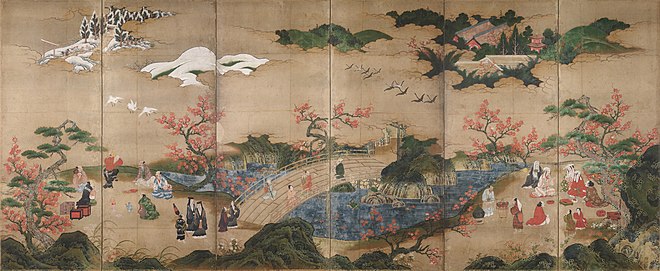
During a prolonged period of civil war in the 16th century, a class of politically powerful merchants developed. These machishū, the predecessors of the Edo period's chōnin, allied themselves with the court and had power over local communities; their patronage of the arts encouraged a revival in the classical arts in the late 16th and early 17th centuries.[5] In the early 17th century, Tokugawa Ieyasu (1543–1616) unified the country and was appointed shōgun with supreme power over Japan. He consolidated his government in the village of Edo (modern Tokyo),[6] and required the territorial lords to assemble there in alternate years with their entourages. The demands of the growing capital drew many male labourers from the country, so that males came to make up nearly seventy percent of the population.[7] The village grew during the Edo period (1603–1867) from a population of 1800 to over a million in the 19th century.[6]
The centralized shogunate put an end to the power of the machishū and divided the population into four social classes, with the ruling samurai class at the top and the merchant class at the bottom. While deprived of their political influence,[5] those of the merchant class most benefited from the rapidly expanding economy of the Edo period,[8] and their improved lot allowed for leisure that many sought in the pleasure districts—in particular Yoshiwara in Edo[6]—and collecting artworks to decorate their homes, which in earlier times had been well beyond their financial means.[9] The experience of the pleasure quarters was open to those of sufficient wealth, manners, and education.[10]
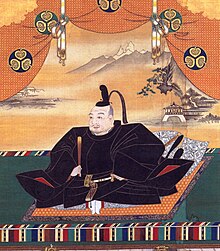
Woodblock printing in Japan traces back to the Hyakumantō Darani in 770 CE. Until the 17th century, such printing was reserved for Buddhist seals and images.[11] Movable type appeared around 1600, but as the Japanese writing system required about 100,000 type pieces,[b] hand-carving text onto woodblocks was more efficient. In Saga, Kyoto, calligrapher Hon'ami Kōetsu and publisher Suminokura Soan combined printed text and images in an adaptation of The Tales of Ise (1608) and other works of literature.[12] During the Kan'ei era (1624–1643) illustrated books of folk tales called tanrokubon ('orange-green books') were the first books mass-produced using woodblock printing.[11] Woodblock imagery continued to evolve as illustrations to the kanazōshi genre of tales of hedonistic urban life in the new capital.[13] The rebuilding of Edo following the Great Fire of Meireki in 1657 occasioned a modernization of the city, and the publication of illustrated printed books flourished in the rapidly urbanizing environment.[14]
The term ukiyo (浮世), which can be translated as 'floating world', was homophonous with the ancient Buddhist term ukiyo (憂き世), meaning 'this world of sorrow and grief'. The newer term at times was used to mean 'erotic' or 'stylish', among other meanings, and came to describe the hedonistic spirit of the time for the lower classes. Asai Ryōi celebrated this spirit in the novel Ukiyo Monogatari (Tales of the Floating World, c. 1661):[15]
[L]iving only for the moment, savouring the moon, the snow, the cherry blossoms, and the maple leaves, singing songs, drinking sake, and diverting oneself just in floating, unconcerned by the prospect of imminent poverty, buoyant and carefree, like a gourd carried along with the river current: this is what we call ukiyo.
Emergence of ukiyo-e (late 17th – early 18th centuries)
[edit]The earliest ukiyo-e artists came from the world of Japanese painting.[16] Yamato-e painting of the 17th century had developed a style of outlined forms which allowed inks to be dripped on a wet surface and spread out towards the outlines—this outlining of forms was to become the dominant style of ukiyo-e.[17]
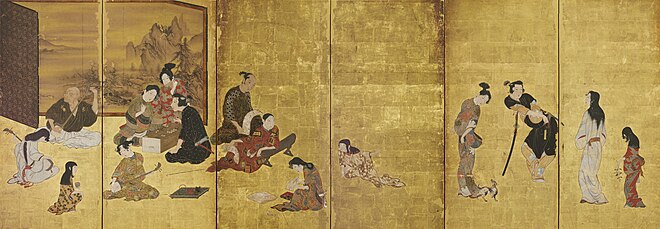
Around 1661, painted hanging scrolls known as Portraits of Kanbun Beauties gained popularity. The paintings of the Kanbun era (1661–1673), most of which are anonymous, marked the beginnings of ukiyo-e as an independent school.[16] The paintings of Iwasa Matabei (1578–1650) have a great affinity with ukiyo-e paintings. Scholars disagree whether Matabei's work itself is ukiyo-e;[18] assertions that he was the genre's founder are especially common amongst Japanese researchers.[19] At times Matabei has been credited as the artist of the unsigned Hikone screen,[20] a byōbu folding screen that may be one of the earliest surviving ukiyo-e works. The screen is in a refined Kanō style and depicts contemporary life, rather than the prescribed subjects of the painterly schools.[21]

In response to the increasing demand for ukiyo-e works, Hishikawa Moronobu (1618–1694) produced the first ukiyo-e woodblock prints.[16] By 1672, Moronobu's success was such that he began to sign his work—the first of the book illustrators to do so. He was a prolific illustrator who worked in a wide variety of genres, and developed an influential style of portraying female beauties. Most significantly, he began to produce illustrations, not just for books, but as single-sheet images, which could stand alone or be used as part of a series. The Hishikawa school attracted a large number of followers,[22] as well as imitators such as Sugimura Jihei,[23] and signalled the beginning of the popularization of a new artform.[24]
Torii Kiyonobu I and Kaigetsudō Ando became prominent emulators of Moronobu's style following the master's death, though neither was a member of the Hishikawa school. Both discarded background detail in favour of focus on the human figure—kabuki actors in the yakusha-e of Kiyonobu and the Torii school that followed him,[25] and courtesans in the bijin-ga of Ando and his Kaigetsudō school. Ando and his followers produced a stereotyped female image whose design and pose lent itself to effective mass production,[26] and its popularity created a demand for paintings that other artists and schools took advantage of.[27] The Kaigetsudō school and its popular "Kaigetsudō beauty" ended after Ando's exile over his role in the Ejima-Ikushima scandal of 1714.[28]
Kyoto native Nishikawa Sukenobu (1671–1750) painted technically refined pictures of courtesans.[29] Considered a master of erotic portraits, he was the subject of a government ban in 1722, though it is believed he continued to create works that circulated under different names.[30] Sukenobu spent most of his career in Edo, and his influence was considerable in both the Kantō and Kansai regions.[29] The paintings of Miyagawa Chōshun (1683–1752) portrayed early 18th-century life in delicate colours. Chōshun made no prints.[31] The Miyagawa school he founded in the early-18th century specialized in romantic paintings in a style more refined in line and colour than the Kaigetsudō school. Chōshun allowed greater expressive freedom in his adherents, a group that later included Hokusai.[27]
- Early ukiyo-e masters
-
Standing portrait of a courtesanInk and colour painting on silk, Kaigetsudō Ando, c. 1705–10
-
Portrait of actorsHand-coloured printKiyonobu, 1714
-
Printed page from Asakayama E-honSukenobu, 1739
-
Ryukyuan Dancer and MusiciansInk and color painting on silk, Chōshun, c. 1718
Colour prints (mid-18th century)
[edit]Even in the earliest monochromatic prints and books, colour was added by hand for special commissions. Demand for colour in the early-18th century was met with tan-e[c] prints hand-tinted with orange and sometimes green or yellow.[33] These were followed in the 1720s with a vogue for pink-tinted beni-e[d] and later the lacquer-like ink of the urushi-e. In 1744, the benizuri-e were the first successes in colour printing, using multiple woodblocks—one for each colour, the earliest beni pink and vegetable green.[34]
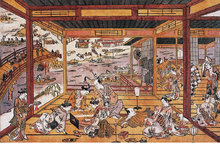
A great self-promoter, Okumura Masanobu (1686–1764) played a major role during the period of rapid technical development in printing from the late 17th to mid-18th centuries.[34] He established a shop in 1707[35] and combined elements of the leading contemporary schools in a wide array of genres, though Masanobu himself belonged to no school. Amongst the innovations in his romantic, lyrical images were the introduction of geometrical perspective in the uki-e genre[e] in the 1740s;[39] the long, narrow hashira-e prints; and the combination of graphics and literature in prints that included self-penned haiku poetry.[40]
Ukiyo-e reached a peak in the late 18th century with the advent of full-colour prints, developed after Edo returned to prosperity under Tanuma Okitsugu following a long depression.[41] These popular colour prints came to be called nishiki-e, or 'brocade pictures', as their brilliant colours seemed to bear resemblance to imported Chinese Shuchiang brocades, known in Japanese as Shokkō nishiki.[42] The first to emerge were expensive calendar prints, printed with multiple blocks on very fine (or finer than standard) paper with heavy, opaque inks. These prints had the number of days for each month hidden in the design, and were sent at the New Year[f] as personalized greetings, bearing the name of the patron rather than the artist. The blocks for these prints were later re-used for commercial production, obliterating the patron's name and replacing it with that of the artist.[43]
The delicate, romantic prints of Suzuki Harunobu (1725–1770) were amongst the first to realize expressive and complex colour designs,[44] printed with up to a dozen separate blocks to handle the different colours[45] and half-tones.[46] His restrained, graceful prints invoked the classicism of waka poetry and Yamato-e painting. The prolific Harunobu was the dominant ukiyo-e artist of his time.[47] The success of Harunobu's colourful nishiki-e from 1765 on led to a steep decline in demand for the limited palettes of benizuri-e and urushi-e, as well as hand-coloured prints.[45]
A trend against the idealism of the prints of Harunobu and the Torii school grew following Harunobu's death in 1770. Katsukawa Shunshō (1726–1793) and his school produced portraits of kabuki actors with greater fidelity to the actors' actual features than had been the trend.[48] Sometime-collaborators Koryūsai (1735 – c. 1790) and Kitao Shigemasa (1739–1820) were prominent depicters of women who also moved ukiyo-e away from the dominance of Harunobu's idealism by focusing on contemporary urban fashions and celebrated real-world courtesans and geisha.[49] Koryūsai was perhaps the most prolific ukiyo-e artist of the 18th century, and produced a larger number of paintings and print series than any predecessor.[50] The Kitao school that Shigemasa founded was one of the dominant schools of the closing decades of the 18th century.[51]
In the 1770s, Utagawa Toyoharu produced a number of uki-e perspective prints[52] that demonstrated a mastery of Western perspective techniques that had eluded his predecessors in the genre.[36] Toyoharu's works helped pioneer the landscape as an ukiyo-e subject, rather than merely a background for human figures.[53] In the 19th century, Western-style perspective techniques were absorbed into Japanese artistic culture, and deployed in the refined landscapes of such artists as Hokusai and Hiroshige,[54] the latter a member of the Utagawa school that Toyoharu founded. This school was to become one of the most influential,[55] and produced works in a far greater variety of genres than any other school.[56]
- Early colour ukiyo-e
-
Two Lovers Beneath an Umbrella in the SnowHarunobu, c. 1767
-
Arashi Otohachi as Ippon SaemonShunshō, 1768
-
Hinazuru of the ChōjiyaKoryūsai, c. 1778–80
-
Geisha and a servant carrying her shamisen boxShigemasa, 1777
Peak period (late 18th century)
[edit]
While the late 18th century saw hard economic times,[57] ukiyo-e saw a peak in quantity and quality of works, particularly during the Kansei era (1789–1791).[58] The ukiyo-e of the period of the Kansei Reforms brought about a focus on beauty and harmony[51] that collapsed into decadence and disharmony in the next century as the reforms broke down and tensions rose, culminating in the Meiji Restoration of 1868.[58]
Especially in the 1780s, Torii Kiyonaga (1752–1815)[51] of the Torii school[58] depicted traditional ukiyo-e subjects like beauties and urban scenes, which he printed on large sheets of paper, often as multiprint horizontal diptychs or triptychs. His works dispensed with the poetic dreamscapes made by Harunobu, opting instead for realistic depictions of idealized female forms dressed in the latest fashions and posed in scenic locations.[59] He also produced portraits of kabuki actors in a realistic style that included accompanying musicians and chorus.[60]
A law went into effect in 1790 requiring prints to bear a censor's seal of approval to be sold. Censorship increased in strictness over the following decades, and violators could receive harsh punishments. From 1799 even preliminary drafts required approval.[61] A group of Utagawa-school offenders including Toyokuni had their works repressed in 1801, and Utamaro was imprisoned in 1804 for making prints of 16th-century political and military leader Toyotomi Hideyoshi.[62]
Utamaro (c. 1753–1806) made his name in the 1790s with his bijin ōkubi-e ('large-headed pictures of beautiful women') portraits, focusing on the head and upper torso, a style others had previously employed in portraits of kabuki actors.[63] Utamaro experimented with line, colour, and printing techniques to bring out subtle differences in the features, expressions, and backdrops of subjects from a wide variety of class and background. Utamaro's individuated beauties were in sharp contrast to the stereotyped, idealized images that had been the norm.[64] By the end of the decade, especially following the death of his patron Tsutaya Jūzaburō in 1797, Utamaro's prodigious output declined in quality,[65] and he died in 1806.[66]
Appearing suddenly in 1794 and disappearing just as suddenly ten months later, the prints of the enigmatic Sharaku are amongst ukiyo-e's best known. Sharaku produced striking portraits of kabuki actors, introducing a greater level of realism into his prints that emphasized the differences between the actor and the portrayed character.[67] The expressive, contorted faces he depicted contrasted sharply with the serene, mask-like faces more common to artists such as Harunobu or Utamaro.[46] Published by Tsutaya,[66] Sharaku's work found resistance, and in 1795 his output ceased as mysteriously as it had appeared; his real identity is still unknown.[68] Utagawa Toyokuni (1769–1825) produced kabuki portraits in a style Edo townsfolk found more accessible, emphasizing dramatic postures and avoiding Sharaku's realism.[67]
A consistent high level of quality marks ukiyo-e of the late 18th-century, but the works of Utamaro and Sharaku often overshadow those other masters of the era.[66] One of Kiyonaga's followers,[58] Eishi (1756–1829), abandoned his position as painter for shōgun Tokugawa Ieharu to take up ukiyo-e design. He brought a refined sense to his portraits of graceful, slender courtesans, and left behind a number of noted students.[66] With a fine line, Eishōsai Chōki (fl. 1786–1808) designed portraits of delicate courtesans. The Utagawa school came to dominate ukiyo-e output in the late Edo period.[69]
Edo was the primary centre of ukiyo-e production throughout the Edo period. Another major centre developed in the Kamigata region of areas in and around Kyoto and Osaka. In contrast to the range of subjects in the Edo prints, those of Kamigata tended to be portraits of kabuki actors. The style of the Kamigata prints was little distinguished from those of Edo until the late 18th century, partly because artists often moved back and forth between the two areas.[70] Colours tend to be softer and pigments thicker in Kamigata prints than in those of Edo.[71] In the 19th century, many of the prints were designed by kabuki fans and other amateurs.[72]
- Masters of the peak period
-
Cooling on RiversideKiyonaga, c. 1785
-
Ichikawa Ebizo as Takemura SadanoshinSharaku, 1794
-
Onoe Eisaburo IToyokuni, c. 1800
-
Niwaka Festival in the Licensed QuartersChōki, c. 1800
Late flowering: flora, fauna, and landscapes (19th century)
[edit]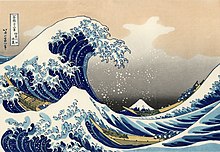
The Tenpō Reforms of 1841–1843 sought to suppress outward displays of luxury, including the depiction of courtesans and actors. As a result, many ukiyo-e artists designed travel scenes and pictures of nature, especially birds and flowers.[73] Landscapes had been given limited attention since Moronobu, and they formed an important element in the works of Kiyonaga and Shunchō. It was not until late in the Edo period that landscape came into its own as a genre, especially via the works of Hokusai and Hiroshige The landscape genre has come to dominate Western perceptions of ukiyo-e, though ukiyo-e had a long history preceding these late-era masters.[74] The Japanese landscape differed from the Western tradition in that it relied more heavily on imagination, composition, and atmosphere than on strict observance of nature.[75]
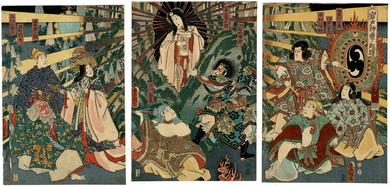
The self-proclaimed "mad painter" Hokusai (1760–1849) enjoyed a long, varied career. His work is marked by a lack of the sentimentality common to ukiyo-e, and a focus on formalism influenced by Western art. Among his accomplishments are his illustrations of Takizawa Bakin's novel Crescent Moon, his series of sketchbooks, the Hokusai Manga, and his popularization of the landscape genre with Thirty-six Views of Mount Fuji,[76] which includes his best-known print, The Great Wave off Kanagawa,[77] one of the most famous works of Japanese art.[78] In contrast to the work of the older masters, Hokusai's colours were bold, flat, and abstract, and his subject was not the pleasure districts but the lives and environment of the common people at work.[79] Established masters Eisen, Kuniyoshi, and Kunisada also followed Hokusai's steps into landscape prints in the 1830s, producing prints with bold compositions and striking effects.[80]
Though not often given the attention of their better-known forebears, the Utagawa school produced a few masters in this declining period. The prolific Kunisada (1786–1865) had few rivals in the tradition of making portrait prints of courtesans and actors.[81] One of those rivals was Eisen (1790–1848), who was also adept at landscapes.[82] Perhaps the last significant member of this late period, Kuniyoshi (1797–1861) tried his hand at a variety of themes and styles, much as Hokusai had. His historical scenes of warriors in violent combat were popular,[83] especially his series of heroes from the Suikoden (1827–1830) and Chūshingura (1847).[84] He was adept at landscapes and satirical scenes—the latter an area rarely explored in the dictatorial atmosphere of the Edo period; that Kuniyoshia could dare tackle such subjects was a sign of the weakening of the shogunate at the time.[83]
Hiroshige (1797–1858) is considered Hokusai's greatest rival in stature. He specialized in pictures of birds and flowers, and serene landscapes, and is best known for his travel series, such as The Fifty-three Stations of the Tōkaidō and The Sixty-nine Stations of the Kisokaidō,[85] the latter a cooperative effort with Eisen.[82] His work was more realistic, subtly coloured, and atmospheric than Hokusai's; nature and the seasons were key elements: mist, rain, snow, and moonlight were prominent parts of his compositions.[86] Hiroshige's followers, including adopted son Hiroshige II and son-in-law Hiroshige III, carried on their master's style of landscapes into the Meiji era.[87]
- Masters of the late period
-
Dawn at Futami-ga-uraKunisada, c. 1832
-
Two mandarin ducksHiroshige, 1838
Decline (late 19th century)
[edit]Following the deaths of Hokusai and Hiroshige[88] and the Meiji Restoration of 1868, ukiyo-e suffered a sharp decline in quantity and quality.[89] The rapid Westernization of the Meiji period that followed saw woodblock printing turn its services to journalism, and face competition from photography. Practitioners of pure ukiyo-e became more rare, and tastes turned away from a genre seen as a remnant of an obsolescent era.[88] Artists continued to produce occasional notable works, but by the 1890s the tradition was moribund.[90]
Synthetic pigments imported from Germany began to replace traditional organic ones in the mid-19th century. Many prints from this era made extensive use of a bright red, and were called aka-e ('red pictures').[91] Artists such as Yoshitoshi (1839–1892) led a trend in the 1860s of gruesome scenes of murders and ghosts,[92] monsters and supernatural beings, and legendary Japanese and Chinese heroes. His One Hundred Aspects of the Moon (1885–1892) depicts a variety of fantastic and mundane themes with a moon motif.[93] Kiyochika (1847–1915) is known for his prints documenting the rapid modernization of Tokyo, such as the introduction of railways, and his depictions of Japan's wars with China and with Russia.[92] Earlier a painter of the Kanō school, in the 1870s Chikanobu (1838–1912) turned to prints, particularly of the imperial family and scenes of Western influence on Japanese life in the Meiji period.[94]
- Meiji-era ukiyo-e
-
Mirror of the Japanese NobilityChikanobu, 1887
-
From One Hundred Aspects of the MoonYoshitoshi, 1891
-
Russo-Japanese Naval Battle at the Entrance of Incheon: The Great Victory of the Japanese Navy—Banzai!Kiyochika, 1904
Introduction to the West
[edit]Aside from Dutch traders, who had had trading relations dating to the beginning of the Edo period,[95] Westerners paid little notice to Japanese art before the mid-19th century, and when they did they rarely distinguished it from other art from the East.[95] Swedish naturalist Carl Peter Thunberg spent a year in the Dutch trading settlement Dejima, near Nagasaki, and was one of the earliest Westerners to collect Japanese prints. The export of ukiyo-e thereafter slowly grew, and at the beginning of the 19th century Dutch merchant-trader Isaac Titsingh's collection drew the attention of connoisseurs of art in Paris.[96]
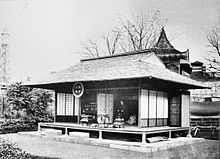
The arrival in Edo of American Commodore Matthew Perry in 1853 led to the Convention of Kanagawa in 1854, which opened Japan to the outside world after over two centuries of seclusion. Ukiyo-e prints were amongst the items he brought back to the United States.[97] Such prints had appeared in Paris from at least the 1830s, and by the 1850s were numerous;[98] reception was mixed, and even when praised ukiyo-e was generally thought inferior to Western works which emphasized mastery of naturalistic perspective and anatomy.[99] Japanese art drew notice at the International Exhibition of 1867 in Paris,[95] and became fashionable in France and England in the 1870s and 1880s.[95] The prints of Hokusai and Hiroshige played a prominent role in shaping Western perceptions of Japanese art.[100] At the time of their introduction to the West, woodblock printing was the most common mass medium in Japan, and the Japanese considered it of little lasting value.[101]
Early Europeans promoters and scholars of ukiyo-e and Japanese art included writer Edmond de Goncourt and art critic Philippe Burty,[102] who coined the term Japonism.[103][g] Stores selling Japanese goods opened, including those of Édouard Desoye in 1862 and art dealer Siegfried Bing in 1875.[104] From 1888 to 1891 Bing published the magazine Artistic Japan[105] in English, French, and German editions,[106] and curated an ukiyo-e exhibition at the École des Beaux-Arts in 1890 attended by artists such as Mary Cassatt.[107]
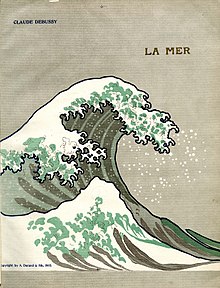
American Ernest Fenollosa was the earliest Western devotee of Japanese culture, and did much to promote Japanese art—Hokusai's works featured prominently at his inaugural exhibition as first curator of Japanese art Museum of Fine Arts in Boston, and in Tokyo in 1898 he curated the first ukiyo-e exhibition in Japan.[108] By the end of the 19th century, the popularity of ukiyo-e in the West drove prices beyond the means of most collectors—some, such as Degas, traded their own paintings for such prints. Tadamasa Hayashi was a prominent Paris-based dealer of respected tastes whose Tokyo office was responsible for evaluating and exporting large quantities of ukiyo-e prints to the West in such quantities that Japanese critics later accused him of siphoning Japan of its national treasure.[109] The drain first went unnoticed in Japan, as Japanese artists were immersing themselves in the classical painting techniques of the West.[110]
Japanese art, and particularly ukiyo-e prints, came to influence Western art from the time of the early Impressionists.[111] Early painter-collectors incorporated Japanese themes and compositional techniques into their works as early as the 1860s:[98] the patterned wallpapers and rugs in Manet's paintings were inspired by the patterned kimono found in ukiyo-e pictures, and Whistler focused his attention on ephemeral elements of nature as in ukiyo-e landscapes.[112] Van Gogh was an avid collector, and painted copies in oil of prints by Hiroshige and Eisen.[113] Degas and Cassatt depicted fleeting, everyday moments in Japanese-influenced compositions and perspectives.[114] ukiyo-e's flat perspective and unmodulated colours were a particular influence on graphic designers and poster makers.[115] Toulouse-Lautrec's lithographs displayed his interest not only in ukiyo-e's flat colours and outlined forms, but also in their subject matter: performers and prostitutes.[116] He signed much of this work with his initials in a circle, imitating the seals on Japanese prints.[116] Other artists of the time who drew influence from ukiyo-e include Monet,[111] La Farge,[117] Gauguin,[118] and Les Nabis members such as Bonnard[119] and Vuillard.[120] French composer Claude Debussy drew inspiration for his music from the prints of Hokusai and Hiroshige, most prominently in La mer (1905).[121] Imagist poets such as Amy Lowell and Ezra Pound found inspiration in ukiyo-e prints; Lowell published a book of poetry called Pictures of the Floating World (1919) on oriental themes or in an oriental style.[122]
- Ukiyo-e influence on Western art
-
Bamboo Yards, Kyōbashi BridgeHiroshige, c. 1857–58
-
Sudden Shower over Shin-Ōhashi bridge and AtakeHiroshige, 1857
-
Mary Cassatt at the Louvre: The Paintings GalleryDegas, c. 1879–80
-
Woman BathingCassatt, c. 1890–91
Descendant traditions (20th century)
[edit]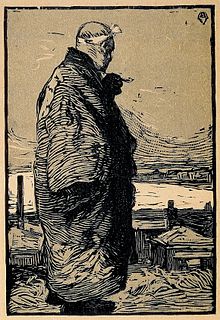
The travel sketchbook became a popular genre beginning about 1905, as the Meiji government promoted travel within Japan to have citizens better know their country.[123] In 1915, publisher Shōzaburō Watanabe introduced the term shin-hanga ("new prints") to describe a style of prints he published that featured traditional Japanese subject matter and were aimed at foreign and upscale Japanese audiences.[124] Prominent artists included Goyō Hashiguchi, called the "Utamaro of the Taishō period" for his manner of depicting women; Shinsui Itō, who brought more modern sensibilities to images of women;[125] and Hasui Kawase, who made modern landscapes.[126] Watanabe also published works by non-Japanese artists, an early success of which was a set of Indian- and Japanese-themed prints in 1916 by the English Charles W. Bartlett (1860–1940). Other publishers followed Watanabe's success, and some shin-hanga artists such as Goyō and Hiroshi Yoshida set up studios to publish their own work.[127]
Artists of the sōsaku-hanga ('creative prints') movement took control of every aspect of the printmaking process—design, carving, and printing were by the same pair of hands.[124] Kanae Yamamoto (1882–1946), then a student at the Tokyo School of Fine Arts, is credited with the birth of this approach. In 1904, he produced Fisherman using woodblock printing, a technique until then frowned upon by the Japanese art establishment as old-fashioned and for its association with commercial mass production.[128] The foundation of the Japanese Woodcut Artists' Association in 1918 marks the beginning of this approach as a movement.[129] The movement favoured individuality in its artists, and as such has no dominant themes or styles.[130] Works ranged from the entirely abstract ones of Kōshirō Onchi (1891–1955) to the traditional figurative depictions of Japanese scenes of Un'ichi Hiratsuka (1895–1997).[129] These artists produced prints not because they hoped to reach a mass audience, but as a creative end in itself, and did not restrict their print media to the woodblock of traditional ukiyo-e.[131]
Prints from the late-20th and 21st centuries have evolved from the concerns of earlier movements, especially the sōsaku-hanga movement's emphasis on individual expression. Screen printing, etching, mezzotint, mixed media, and other Western methods have joined traditional woodcutting amongst printmakers' techniques.[132]
- Descendants of ukiyo-e
-
Taj Mahal, Charles W. Bartlett, 1916
-
Combing the HairGoyō Hashiguchi, 1920
-
Shiba Zōjōji, Hasui Kawase, 1925
-
Glittering Sea, by Hiroshi Yoshida, 1926
-
Lyric No. 23Kōshirō Onchi, 1952
Style
[edit]

Early ukiyo-e artists brought with them a sophisticated knowledge of and training in the composition principles of classical Chinese painting; gradually these artists shed the overt Chinese influence to develop a native Japanese idiom. The early ukiyo-e artists have been called "Primitives" in the sense that the print medium was a new challenge to which they adapted these centuries-old techniques—their image designs are not considered "primitive".[133] Many ukiyo-e artists received training from teachers of the Kanō and other painterly schools.[134]
A defining feature of most ukiyo-e prints is a well-defined, bold, flat line.[135] The earliest prints were monochromatic, and these lines were the only printed element; even with the advent of colour this characteristic line continued to dominate.[136] In ukiyo-e composition forms are arranged in flat spaces[137] with figures typically in a single plane of depth. Attention was drawn to vertical and horizontal relationships, as well as details such as lines, shapes, and patterns such as those on clothing.[138] Compositions were often asymmetrical, and the viewpoint was often from unusual angles, such as from above. Elements of images were often cropped, giving the composition a spontaneous feel.[139] In colour prints, contours of most colour areas are sharply defined, usually by the linework.[140] The aesthetic of flat areas of colour contrasts with the modulated colours expected in Western traditions[137] and with other prominent contemporary traditions in Japanese art patronized by the upper class, such as in the subtle monochrome ink brushstrokes of zenga brush painting or tonal colours of the Kanō school of painting.[140]

The colourful, ostentatious, and complex patterns, concern with changing fashions, and tense, dynamic poses and compositions in ukiyo-e are in striking contrast with many concepts in traditional Japanese aesthetics. Prominent amongst these, wabi-sabi favours simplicity, asymmetry, and imperfection, with evidence of the passage of time;[141] and shibui values subtlety, humility, and restraint.[142] Ukiyo-e can be less at odds with aesthetic concepts such as the racy, urbane stylishness of iki.[143]
Ukiyo-e displays an unusual approach to graphical perspective, one that can appear underdeveloped when compared to European paintings of the same period. Western-style geometrical perspective was known in Japan—practised most prominently by the Akita ranga painters of the 1770s—as were Chinese methods to create a sense of depth using a homogeny of parallel lines. The techniques sometimes appeared together in ukiyo-e works, geometrical perspective providing an illusion of depth in the background and the more expressive Chinese perspective in the fore.[144] The techniques were most likely learned at first through Chinese Western-style paintings rather than directly from Western works.[145] Long after becoming familiar with these techniques, artists continued to harmonize them with traditional methods according to their compositional and expressive needs.[146] Other ways of indicating depth included the Chinese tripartite composition method used in Buddhist pictures, where a large form is placed in the foreground, a smaller in the midground, and yet a smaller in the background; this can be seen in Hokusai's Great Wave, with a large boat in the foreground, a smaller behind it, and a small Mt Fuji behind them.[147]
There was a tendency since early ukiyo-e to pose beauties in what art historian Midori Wakakura called a "serpentine posture",[h] which involves the subjects' bodies twisting unnaturally while facing behind themselves. Art historian Motoaki Kōno posited that this had its roots in traditional buyō dance; Haruo Suwa countered that the poses were artistic licence taken by ukiyo-e artists, causing a seemingly relaxed pose to reach unnatural or impossible physical extremes. This remained the case even when realistic perspective techniques were applied to other sections of the composition.[148]
Themes and genres
[edit]Typical subjects were female beauties ("bijin-ga"), kabuki actors ("yakusha-e"), and landscapes. The women depicted were most often courtesans and geisha at leisure, and promoted the entertainments to be found in the pleasure districts.[149] The detail with which artists depicted courtesans' fashions and hairstyles allows the prints to be dated with some reliability. Less attention was given to accuracy of the women's physical features, which followed the day's pictorial fashions—the faces stereotyped, the bodies tall and lanky in one generation and petite in another.[150] Portraits of celebrities were much in demand, in particular those from the kabuki and sumo worlds, two of the most popular entertainments of the era.[151] While the landscape has come to define ukiyo-e for many Westerners, landscapes flourished relatively late in the ukiyo-e's history.[74]

Ukiyo-e prints grew out of book illustration—many of Moronobu's earliest single-page prints were originally pages from books he had illustrated.[12] E-hon books of illustrations were popular[152] and continued be an important outlet for ukiyo-e artists. In the late period, Hokusai produced the three-volume One Hundred Views of Mount Fuji and the 15-volume Hokusai Manga, the latter a compendium of over 4000 sketches of a wide variety of realistic and fantastic subjects.[153]
Traditional Japanese religions do not consider sex or pornography a moral corruption in the sense of most Abrahamic faiths,[154] and until the changing morals of the Meiji era led to its suppression, shunga erotic prints were a major genre.[155] While the Tokugawa regime subjected Japan to strict censorship laws, pornography was not considered an important offence and generally met with the censors' approval.[62] Many of these prints displayed a high level a draughtsmanship, and often humour, in their explicit depictions of bedroom scenes, voyeurs, and oversized anatomy.[156] As with depictions of courtesans, these images were closely tied to entertainments of the pleasure quarters.[157] Nearly every ukiyo-e master produced shunga at some point.[158] Records of societal acceptance of shunga are absent, though Timon Screech posits that there were almost certainly some concerns over the matter, and that its level of acceptability has been exaggerated by later collectors, especially in the West.[157]
Scenes from nature have been an important part of Asian art throughout history. Artists have closely studied the correct forms and anatomy of plants and animals, even though depictions of human anatomy remained more fanciful until modern times. Ukiyo-e nature prints are called kachō-e, which translates as "flower-and-bird pictures", though the genre was open to more than just flowers or birds, and the flowers and birds did not necessarily appear together.[73] Hokusai's detailed, precise nature prints are credited with establishing kachō-e as a genre.[159]
The Tenpō Reforms of the 1840s suppressed the depiction of actors and courtesans. Aside from landscapes and kachō-e, artists turned to depictions of historical scenes, such as of ancient warriors or of scenes from legend, literature, and religion. The 11th century Tale of Genji[160] and the 13th-century Tale of the Heike[161] have been sources of artistic inspiration throughout Japanese history,[160] including in ukiyo-e.[160] Well-known warriors and swordsmen such as Miyamoto Musashi (1584–1645) were frequent subjects, as were depictions of monsters, the supernatural, and heroes of Japanese and Chinese mythology.[162]
From the 17th to 19th centuries, Japan isolated itself from the rest of the world. Trade, primarily with the Dutch and Chinese, was restricted to the island of Dejima near Nagasaki. Outlandish pictures called Nagasaki-e were sold to tourists of the foreigners and their wares.[97] In the mid-19th century, Yokohama became the primary foreign settlement after 1859, from which Western knowledge proliferated in Japan.[163] Especially from 1858 to 1862, Yokohama-e prints documented, with various levels of fact and fancy, the growing community of world denizens with whom the Japanese were now coming in contact;[164] triptychs of scenes of Westerners and their technology were particularly popular.[165]
Specialized prints included surimono, deluxe, limited-edition prints aimed at connoisseurs, of which a five-line kyōka poem was usually part of the design;[166] and uchiwa-e printed hand fans, which often suffer from having been handled.[12]
- Ukiyo-e genres
-
English CoupleYokohama-e by Utagawa Yoshitora, 1860
Production
[edit]Paintings
[edit]Ukiyo-e artists often made both prints and paintings; some specialized in one or the other.[167] In contrast with previous traditions, ukiyo-e painters favoured bright, sharp colours,[168] and often delineated contours with sumi ink, an effect similar to the linework in prints.[169] Unrestricted by the technical limitations of printing, a wider range of techniques, pigments, and surfaces were available to the painter.[170] Artists painted with pigments made from mineral or organic substances, such as safflower, ground shells, lead, and cinnabar,[171] and later synthetic dyes imported from the West such as Paris green and Prussian blue.[172] Silk or paper kakemono hanging scrolls, makimono handscrolls, or byōbu folding screens were the most common surfaces.[167]
- Ukiyo-e paintings
-
Bijin-gaKaigetsudō Ando, 18th century
-
A Winter PartyUtagawa Toyoharu, mid-18th – late 19th century
-
Yoshiwara no HanaUtamaro, c. 1788–91
-
Feminine WaveHokusai, mid-19th century
Print production
[edit]
Ukiyo-e prints were the works of teams of artisans in several workshops;[173] it was rare for designers to cut their own woodblocks.[174] Labour was divided into four groups: the publisher, who commissioned, promoted, and distributed the prints; the artists, who provided the design image; the woodcarvers, who prepared the woodblocks for printing; and the printers, who made impressions of the woodblocks on paper.[175] Normally only the names of the artist and publisher were credited on the finished print.[176]
Ukiyo-e prints were impressed on hand-made paper[177] manually, rather than by mechanical press as in the West.[178] The artist provided an ink drawing on thin paper, which was pasted[179] to a block of cherry wood[i] and rubbed with oil until the upper layers of paper could be pulled away, leaving a translucent layer of paper that the block-cutter could use as a guide. The block-cutter cut away the non-black areas of the image, leaving raised areas that were inked to leave an impression.[173] The original drawing was destroyed in the process.[179]
Prints were made with blocks face up so the printer could vary pressure for different effects, and watch as paper absorbed the water-based sumi ink,[178] applied quickly in even horizontal strokes.[182] Amongst the printer's tricks were embossing of the image, achieved by pressing an uninked woodblock on the paper to achieve effects, such as the textures of clothing patterns or fishing net.[183] Other effects included burnishing[184] rubbing the paper with agate to brighten colours;[185] varnishing; overprinting; dusting with metal or mica; and sprays to imitate falling snow.[184]
The ukiyo-e print was a commercial art form, and the publisher played an important role.[186] Publishing was highly competitive; over a thousand publishers are known from throughout the period. The number peaked at around 250 in the 1840s and 1850s[187]—200 in Edo alone[188]—and slowly shrank following the opening of Japan until about 40 remained at the opening of the 20th century. The publishers owned the woodblocks and copyrights, and from the late 18th century enforced copyrights[187] through the Picture Book and Print Publishers Guild.[j][189][189] Prints that went through several pressings were particularly profitable, as the publisher could reuse the woodblocks without further payment to the artist or woodblock cutter. The woodblocks were also traded or sold to other publishers or pawnshops.[190] Publishers were usually also vendors, and commonly sold each other's wares in their shops.[189] In addition to the artist's seal, publishers marked the prints with their own seals—some a simple logo, others quite elaborate, incorporating an address or other information.[191]
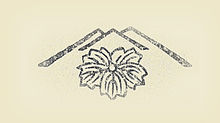
Print designers went through apprenticeship before being granted the right to produce prints of their own that they could sign with their own names.[192] Young designers could be expected to cover part or all of the costs of cutting the woodblocks. As the artists gained fame, publishers usually covered these costs, and artists could demand higher fees.[193]
In pre-modern Japan, people could go by numerous names throughout their lives, their childhood yōmyō personal name different from their zokumyō name as an adult. An artist's name consisted of a gasei—an artist surname—followed by an azana personal art name. The gasei was most frequently taken from the school the artist belonged to, such as Utagawa or Torii,[194] and the azana normally took a Chinese character from the master's art name—for example, many students of Toyokuni (豊国) took the "kuni" (国) from his name, including Kunisada (国貞) and Kuniyoshi (国芳).[192] The names artists signed to their works can be a source of confusion as they sometimes changed names through their careers;[195] Hokusai was an extreme case, using over a hundred names throughout his 70-year career.[196]
The prints were mass-marketed,[186] and by the mid-19th century, the total circulation of a print could run into the thousands.[197] Retailers and travelling sellers promoted them at prices affordable to prosperous townspeople.[198] In some cases, the prints advertised kimono designs by the print artist.[186] From the second half of the 17th century, prints were frequently marketed as part of a series,[191] each print stamped with the series name and the print's number in that series.[199] This proved a successful marketing technique, as collectors bought each new print in the series to keep their collections complete.[191] By the 19th century, series such as Hiroshige's Fifty-three Stations of the Tōkaidō ran to dozens of prints.[199]
- Making ukiyo-e prints
-
Making Prints, Hosoki Toshikazu, 1879
-
The woodblock printing process, Kunisada, 1857. A fantasy version, wholly staffed by well-dressed "beauties". In fact, few women worked in printmaking;[200] Hokusai's daughter Katsushika Ōi was one.
Colour print production
[edit]While colour printing in Japan dates to the 1640s, early ukiyo-e prints used only black ink. Colour was sometimes added by hand, using a red lead ink in tan-e prints, or later in a pink safflower ink in beni-e prints. Colour printing arrived in books in the 1720s and in single-sheet prints in the 1740s, with a different block and printing for each colour. Early colours were limited to pink and green; techniques expanded over the following two decades to allow up to five colours.[173] The mid-1760s brought full-colour nishiki-e prints[173] made from ten or more woodblocks.[201] To keep the blocks for each colour aligned correctly, registration marks called kentō were placed on one corner and an adjacent side.[173]

Printers first used natural colour dyes made from mineral or vegetable sources. The dyes had a translucent quality that allowed a variety of colours to be mixed from primary red, blue, and yellow pigments.[202] In the 18th century, Prussian blue became popular, and was particularly prominent in the landscapes of Hokusai and Hiroshige,[202] as was bokashi, where the printer produced gradations of colour or blended one colour into another.[203] Cheaper and more consistent synthetic aniline dyes arrived from the West in 1864. The colours were harsher and brighter than traditional pigments. The Meiji government promoted their use as part of broader policies of Westernization.[204]
Criticism and historiography
[edit]Contemporary records of ukiyo-e artists are rare. The most significant is the Ukiyo-e Ruikō ("Various Thoughts on ukiyo-e"), a collection of commentaries and artist biographies. Ōta Nanpo compiled the first, no-longer-extant version around 1790. The work did not see print during the Edo era, but circulated in hand-copied editions that were subject to numerous additions and alterations;[205] over 120 variants of the Ukiyo-e Ruikō are known.[206]
Before World War II, the predominant view of ukiyo-e stressed the centrality of prints; this viewpoint ascribes ukiyo-e's founding to Moronobu. Following the war, thinking turned to the importance of ukiyo-e painting and making direct connections with 17th century Yamato-e paintings; this viewpoint sees Matabei as the genre's originator, and is especially favoured in Japan. This view had become widespread among Japanese researchers by the 1930s, but the militaristic government of the time suppressed it, wanting to emphasize a division between the Yamato-e scroll paintings associated with the court, and the prints associated with the sometimes anti-authoritarian merchant class.[19]

The earliest comprehensive historical and critical works on ukiyo-e came from the West. Ernest Fenollosa was Professor of Philosophy at the Imperial University in Tokyo from 1878, and was Commissioner of Fine Arts to the Japanese government from 1886. His Masters of Ukioye of 1896 was the first comprehensive overview and set the stage for most later works with an approach to the history in terms of epochs: beginning with Matabei in a primitive age, it evolved towards a late-18th century golden age that began to decline with the advent of Utamaro, and had a brief revival with Hokusai and Hiroshige's landscapes in the 1830s.[207] Laurence Binyon, the Keeper of Oriental Prints and Drawings at the British Museum, wrote an account in Painting in the Far East in 1908 that was similar to Fenollosa's, but placed Utamaro and Sharaku amongst the masters. Arthur Davison Ficke built on the works of Fenollosa and Binyon with a more comprehensive Chats on Japanese Prints in 1915.[208] James A. Michener's The Floating World in 1954 broadly followed the chronologies of the earlier works, while dropping classifications into periods and recognizing the earlier artists not as primitives but as accomplished masters emerging from earlier painting traditions.[209] For Michener and his sometime collaborator Richard Lane, ukiyo-e began with Moronobu rather than Matabei.[210] Lane's Masters of the Japanese Print of 1962 maintained the approach of period divisions while placing ukiyo-e firmly within the genealogy of Japanese art. The book acknowledges artists such as Yoshitoshi and Kiyochika as late masters.[211]
Seiichirō Takahashi's Traditional Woodblock Prints of Japan of 1964 placed ukiyo-e artists in three periods: the first was a primitive period that included Harunobu, followed by a golden age of Kiyonaga, Utamaro, and Sharaku, and then a closing period of decline following the declaration beginning in the 1790s of strict sumptuary laws that dictated what could be depicted in artworks. The book nevertheless recognizes a larger number of masters from throughout this last period than earlier works had,[212] and viewed ukiyo-e painting as a revival of Yamato-e painting.[17] Tadashi Kobayashi further refined Takahashi's analysis by identifying the decline as coinciding with the desperate attempts of the shogunate to hold on to power through the passing of draconian laws as its hold on the country continued to break down, culminating in the Meiji Restoration in 1868.[213]
Ukiyo-e scholarship has tended to focus on the cataloguing of artists, an approach that lacks the rigour and originality that has come to be applied to art analysis in other areas. Such catalogues are numerous, but tend overwhelmingly to concentrate on a group of recognized geniuses. Little original research has been added to the early, foundational evaluations of ukiyo-e and its artists, especially with regard to relatively minor artists.[214] While the commercial nature of ukiyo-e has always been acknowledged, evaluation of artists and their works has rested on the aesthetic preferences of connoisseurs and paid little heed to contemporary commercial success.[215]
Standards for inclusion in the ukiyo-e canon rapidly evolved in the early literature. Utamaro was particularly contentious, seen by Fenollosa and others as a degenerate symbol of ukiyo-e's decline; Utamaro has since gained general acceptance as one of the form's greatest masters. Artists of the 19th century such as Yoshitoshi were ignored or marginalized, attracting scholarly attention only towards the end of the 20th century.[216] Works on late-era Utagawa artists such as Kunisada and Kuniyoshi have revived some of the contemporary esteem these artists enjoyed. Many late works examine the social or other conditions behind the art, and are unconcerned with valuations that would place it in a period of decline.[217]
Novelist Jun'ichirō Tanizaki was critical of the superior attitude of Westerners who claimed a higher aestheticism in purporting to have discovered ukiyo-e. He maintained that ukiyo-e was merely the easiest form of Japanese art to understand from the perspective of Westerners' values, and that Japanese of all social strata enjoyed ukiyo-e, but that Confucian morals of the time kept them from freely discussing it, social mores that were violated by the West's flaunting of the discovery.[218]

Since the dawn of the 20th century historians of manga—Japanese comics and cartooning—have developed narratives connecting the art form to pre-20th century Japanese art. Particular emphasis falls on the Hokusai Manga as a precursor, though Hokusai's book is not narrative, nor does the term "manga" originate with Hokusai.[219] In English and other languages, the word "manga" is used in the restrictive sense of "Japanese comics" or "Japanese-style comics",[220] while in Japanese it indicates all forms of comics, cartooning,[221] and caricature.[222]
Collection and preservation
[edit]The ruling classes strictly limited the space permitted for the homes of the lower social classes; the relatively small size of ukiyo-e works was ideal for hanging in these homes.[223] Little record of the patrons of ukiyo-e paintings has survived. They sold for considerably higher prices than prints—up to many thousands of times more, and thus must have been purchased by the wealthy, likely merchants and perhaps some from the samurai class.[10] Late-era prints are the most numerous extant examples, as they were produced in the greatest quantities in the 19th century, and the older a print is the less chance it had of surviving.[224] Ukiyo-e was largely associated with Edo, and visitors to Edo often bought what they called azuma-e[l] as souvenirs. Shops that sold them might specialize in products such as hand-held fans, or offer a diverse selection.[189]
The ukiyo-e print market was highly diversified as it sold to a heterogeneous public, from dayworkers to wealthy merchants.[225] Little concrete information is known about production and consumption habits. Detailed records in Edo were kept of a wide variety of courtesans, actors, and sumo wrestlers, but no such records pertaining to ukiyo-e remain—or perhaps ever existed. Determining what is understood about the demographics of ukiyo-e consumption has required indirect means.[226]
Determining at what prices prints sold is a challenge for experts, as records of hard figures are scanty and there was great variety in the production quality, size,[227] supply and demand,[228] and methods, which went through changes such as the introduction of full-colour printing.[229] How expensive prices can be considered is also difficult to determine as social and economic conditions were in flux throughout the period.[230] In the 19th century, records survive of prints selling from as low as 16 mon[231] to 100 mon for deluxe editions.[232] Jun'ichi Ōkubo suggests that prices in the 1920s and 1930s of mon were likely common for standard prints.[233] As a loose comparison, a bowl of soba noodles in the early 19th century typically sold for 16 mon.[234]

The dyes in ukiyo-e prints are susceptible to fading when exposed even to low levels of light; this makes long-term display undesirable. The paper they are printed on deteriorates when it comes in contact with acidic materials, so storage boxes, folders, and mounts must be of neutral pH or alkaline. Prints should be regularly inspected for problems needing treatment, and stored at a relative humidity of 70% or less to prevent fungal discolourations.[235]
The paper and pigments in ukiyo-e paintings are sensitive to light and seasonal changes in humidity. Mounts must be flexible, as the sheets can tear under sharp changes in humidity. In the Edo era, the sheets were mounted on long-fibred paper and preserved scrolled up in plain paulownia wood boxes placed in another lacquer wooden box.[236] In museum settings, display times are heavily limited to prevent deterioration from exposure to light and environmental pollution, and care is taken in the unrolling and rerolling of scrolls, with scrolling causing concavities in the paper, and the unrolling and rerolling of the scrolls causing creasing.[237] The humidity levels that scrolls are kept in are generally between 50 percent and 60 percent, as scrolls kept in too dry an atmosphere become brittle.[238]
Because ukiyo-e prints were mass-produced, collecting them presents considerations different from the collecting of paintings. There is wide variation in the condition, rarity, cost, and quality of extant prints. Prints may have stains, foxing, wormholes, tears, creases, or dogmarks, the colours may have faded, or they may have been retouched. Carvers may have altered the colours or composition of prints that went through multiple editions. When cut after printing, the paper may have been trimmed within the margin.[239] Values of prints depend on a variety of factors, including the artist's reputation, print condition, rarity, and whether it is an original pressing—even high-quality later printings will fetch a fraction of the valuation of an original.[240]
Ukiyo-e prints often went through multiple editions, sometimes with changes made to the blocks in later editions. Editions made from recut woodblocks also circulate, such as legitimate later reproductions, as well as pirate editions and other fakes.[241] Takamizawa Enji (1870–1927), a producer of ukiyo-e reproductions, developed a method of recutting woodblocks to print fresh colour on faded originals, over which he used tobacco ash to make the fresh ink seem aged. These refreshed prints he resold as original printings.[242] Amongst the defrauded collectors was American architect Frank Lloyd Wright, who brought 1500 Takamizawa prints with him from Japan to the US, some of which he had sold before the truth was discovered.[243]
Ukiyo-e artists are referred to in the Japanese style, the surname preceding the personal name, and well-known artists such as Utamaro and Hokusai by personal name alone.[244] Dealers normally refer to ukiyo-e prints by the names of the standard sizes, most commonly the 34.5-by-22.5-centimetre (13.6 in × 8.9 in) aiban, the 22.5-by-19-centimetre (8.9 in × 7.5 in) chūban, and the 38-by-23-centimetre (15.0 in × 9.1 in) ōban[203]—precise sizes vary, and paper was often trimmed after printing.[245]

Many of the largest high-quality collections of ukiyo-e lie outside Japan.[246] Examples entered the collection of the National Library of France in the first half of the 19th century. The British Museum began a collection in 1860[247] that by the late 20th century numbered 70000 items.[248] The largest, surpassing 100000 items, resides in the Museum of Fine Arts, Boston,[246] begun when Ernest Fenollosa donated his collection in 1912.[249] The first exhibition in Japan of ukiyo-e prints was likely one presented by Kōjirō Matsukata in 1925, who amassed his collection in Paris during World War I and later donated it to the National Museum of Modern Art, Tokyo.[250] The largest collection of ukiyo-e in Japan is the 100000 pieces in the Japan Ukiyo-e Museum in the city of Matsumoto.[251]
See also
[edit]- List of ukiyo-e terms
- Schools of ukiyo-e artists
- Some Japanese woodblock print books on Internet Archive
- Ukiyo-e Ōta Memorial Museum of Art
- Ukiyo-e Society of America
Notes
[edit]- ^ The obsolete transliteration "ukiyo-ye" appears in older texts.
- ^ Many of these type pieces were repeat characters; as certain characters were used multiple times on the same page, multiples of these characters needed to be available to the printer.
- ^ tan (丹): a pigment made from red lead mixed with sulphur and saltpetre[32]
- ^ beni (紅): a pigment produced from safflower petals.[34]
- ^ Torii Kiyotada is said to have made the first uki-e;[36] Masanobu advertised himself as its innovator.[37]A Layman's Explanation of the Rules of Drawing with a Compass and Ruler introduced Western-style geometrical perspective drawing to Japan in the 1734, based on a Dutch text of 1644 (see Rangaku, "Dutch learning" during the Edo period); Chinese texts on the subject also appeared during the decade.[36]Okumura likely learned about geometrical perspective from Chinese sources, some of which bear a striking resemblance to Okumura's works.[38]
- ^ Until 1873 the Japanese calendar was lunisolar, and each year the Japanese New Year fell on different days of the Gregorian calendar's January or February.
- ^ Burty coined the term le Japonisme in French in 1872.[103]
- ^ jatai shisei (蛇体姿勢, "serpentine posture")
- ^ Traditional Japanese woodblocks were cut along the grain, as opposed to the blocks of Western wood engraving, which were cut across the grain. In both methods, the dimensions of the woodblock was limited by the girth of the tree.[180] In the 20th century, plywood became the material of choice for Japanese woodcarvers, as it is cheaper, easier to carve, and less limited in size.[181]
- ^ Jihon Toiya (地本問屋, "Picture Book and Print Publishers Guild")[189]
- ^ Tagosaku to Mokube no Tokyo Kenbutsu (田吾作と杢兵衛の東京見物, Tagosaku and Mokube Sightseeing in Tokyo)
- ^ azuma-e (東絵, "pictures of the Eastern capital")
References
[edit]- ^ Lane 1962, pp. 8–9.
- ^ a b Kobayashi 1997, p. 66.
- ^ Kobayashi 1997, pp. 66–67.
- ^ Kobayashi 1997, pp. 67–68.
- ^ a b Kita 1984, pp. 252–253.
- ^ a b c Penkoff 1964, pp. 4–5.
- ^ Marks 2012, p. 17.
- ^ Singer 1986, p. 66.
- ^ Penkoff 1964, p. 6.
- ^ a b Bell 2004, p. 137.
- ^ a b Kobayashi 1997, p. 68.
- ^ a b c Harris 2011, p. 37.
- ^ Kobayashi 1997, p. 69.
- ^ Kobayashi 1997, pp. 69–70.
- ^ Hickman 1978, pp. 5–6.
- ^ a b c Kikuchi & Kenny 1969, p. 31.
- ^ a b Kita 2011, p. 155.
- ^ Kita 1999, p. 39.
- ^ a b Kita 2011, pp. 149, 154–155.
- ^ Kita 1999, pp. 44–45.
- ^ Yashiro 1958, pp. 216, 218.
- ^ Kobayashi 1997, pp. 70–71.
- ^ Kobayashi 1997, pp. 71–72.
- ^ Kobayashi 1997, p. 71.
- ^ Kobayashi 1997, pp. 72–73.
- ^ Kobayashi 1997, pp. 72–74.
- ^ a b Kobayashi 1997, pp. 75–76.
- ^ Kobayashi 1997, pp. 74–75.
- ^ a b Noma 1966, p. 188.
- ^ Hibbett 2001, p. 69.
- ^ Munsterberg 1957, p. 154.
- ^ Kobayashi 1997, p. 76.
- ^ Kobayashi 1997, pp. 76–77.
- ^ a b c Kobayashi 1997, p. 77.
- ^ Penkoff 1964, p. 16.
- ^ a b c King 2010, p. 47.
- ^ Kobayashi 1997, p. 78.
- ^ Suwa 1998, pp. 64–68.
- ^ Suwa 1998, p. 64.
- ^ Kobayashi 1997, pp. 77–79.
- ^ Kobayashi 1997, pp. 80–81.
- ^ Kobayashi 1997, p. 82.
- ^ Lane 1962, pp. 150, 152.
- ^ Kobayashi 1997, p. 81.
- ^ a b Michener 1959, p. 89.
- ^ a b Munsterberg 1957, p. 155.
- ^ Kobayashi 1997, pp. 82–83.
- ^ Kobayashi 1997, p. 83.
- ^ Kobayashi 1997, pp. 84–85.
- ^ Hockley 2003, p. 3.
- ^ a b c Kobayashi 1997, p. 85.
- ^ Marks 2012, p. 68.
- ^ Stewart 1922, p. 224; Neuer, Libertson & Yoshida 1990, p. 259.
- ^ Thompson 1986, p. 44.
- ^ Salter 2006, p. 204.
- ^ Bell 2004, p. 105.
- ^ Neuer, Libertson & Yoshida 1990, p. 145.
- ^ a b c d Kobayashi 1997, p. 91.
- ^ Kobayashi 1997, pp. 85–86.
- ^ Kobayashi 1997, p. 87.
- ^ Michener 1954, p. 231.
- ^ a b Lane 1962, p. 224.
- ^ Kobayashi 1997, pp. 87–88.
- ^ Kobayashi 1997, p. 88.
- ^ Kobayashi 1997, pp. 88–89.
- ^ a b c d Neuer, Libertson & Yoshida 1990, p. 40.
- ^ a b Kobayashi 1997, pp. 91–92.
- ^ Kobayashi 1997, pp. 89–91.
- ^ Neuer, Libertson & Yoshida 1990, pp. 40–41.
- ^ Harris 2011, p. 38.
- ^ Salter 2001, pp. 12–13.
- ^ Winegrad 2007, pp. 18–19.
- ^ a b Harris 2011, p. 132.
- ^ a b Michener 1959, p. 175.
- ^ Michener 1959, pp. 176–177.
- ^ Kobayashi 1997, pp. 92–93.
- ^ Lewis & Lewis 2008, p. 385; Honour & Fleming 2005, p. 709; Benfey 2007, p. 17; Addiss, Groemer & Rimer 2006, p. 146; Buser 2006, p. 168.
- ^ Lewis & Lewis 2008, p. 385; Belloli 1999, p. 98.
- ^ Munsterberg 1957, p. 158.
- ^ King 2010, pp. 84–85.
- ^ Lane 1962, pp. 284–285.
- ^ a b Lane 1962, p. 290.
- ^ a b Lane 1962, p. 285.
- ^ Harris 2011, pp. 153–154.
- ^ Kobayashi 1997, pp. 94–95.
- ^ Munsterberg 1957, pp. 158–159.
- ^ King 2010, p. 116.
- ^ a b Michener 1959, p. 200.
- ^ Michener 1959, p. 200; Kobayashi 1997, p. 95.
- ^ Kobayashi 1997, p. 95; Faulkner & Robinson 1999, pp. 22–23; Kobayashi 1997, p. 95; Michener 1959, p. 200.
- ^ Seton 2010, p. 71.
- ^ a b Seton 2010, p. 69.
- ^ Harris 2011, p. 153.
- ^ Meech-Pekarik 1986, pp. 125–126.
- ^ a b c d Watanabe 1984, p. 667.
- ^ Neuer, Libertson & Yoshida 1990, p. 48.
- ^ a b Harris 2011, p. 163.
- ^ a b Meech-Pekarik 1982, p. 93.
- ^ Watanabe 1984, pp. 680–681.
- ^ Watanabe 1984, p. 675.
- ^ Salter 2001, p. 12.
- ^ Weisberg, Rakusin & Rakusin 1986, p. 7.
- ^ a b Weisberg 1975, p. 120.
- ^ Jobling & Crowley 1996, p. 89.
- ^ Meech-Pekarik 1982, p. 96.
- ^ Weisberg, Rakusin & Rakusin 1986, p. 6.
- ^ Jobling & Crowley 1996, p. 90.
- ^ Meech-Pekarik 1982, pp. 101–103.
- ^ Meech-Pekarik 1982, pp. 96–97.
- ^ Merritt 1990, p. 15.
- ^ a b Mansfield 2009, p. 134.
- ^ Ives 1974, p. 17.
- ^ Sullivan 1989, p. 230.
- ^ Ives 1974, p. 37–39, 45.
- ^ Jobling & Crowley 1996, pp. 90–91.
- ^ a b Ives 1974, p. 80.
- ^ Meech-Pekarik 1982, p. 99.
- ^ Ives 1974, p. 96.
- ^ Ives 1974, p. 56.
- ^ Ives 1974, p. 67.
- ^ Gerstle & Milner 1995, p. 70.
- ^ Hughes 1960, p. 213.
- ^ King 2010, pp. 119, 121.
- ^ a b Seton 2010, p. 81.
- ^ Brown 2006, p. 22; Seton 2010, p. 81.
- ^ Brown 2006, p. 23; Seton 2010, p. 81.
- ^ Brown 2006, p. 21.
- ^ Merritt 1990, p. 109.
- ^ a b Munsterberg 1957, p. 181.
- ^ Statler 1959, p. 39.
- ^ Statler 1959, pp. 35–38.
- ^ Fiorillo 1999.
- ^ Penkoff 1964, pp. 9–11.
- ^ Lane 1962, p. 9.
- ^ Bell 2004, p. xiv; Michener 1959, p. 11.
- ^ Michener 1959, pp. 11–12.
- ^ a b Michener 1959, p. 90.
- ^ Bell 2004, p. xvi.
- ^ Sims 1998, p. 298.
- ^ a b Bell 2004, p. 34.
- ^ Bell 2004, pp. 50–52.
- ^ Bell 2004, pp. 53–54.
- ^ Bell 2004, p. 66.
- ^ Suwa 1998, pp. 57–60.
- ^ Suwa 1998, pp. 62–63.
- ^ Suwa 1998, pp. 106–107.
- ^ Suwa 1998, pp. 108–109.
- ^ Suwa 1998, pp. 101–106.
- ^ Harris 2011, p. 60.
- ^ Hillier 1954, p. 20.
- ^ Harris 2011, pp. 95, 98.
- ^ Harris 2011, p. 41.
- ^ Harris 2011, pp. 38, 41.
- ^ Harris 2011, pp. 124.
- ^ Seton 2010, p. 64; Harris 2011.
- ^ Seton 2010, p. 64.
- ^ a b Screech 1999, p. 15.
- ^ Harris 2011, pp. 128.
- ^ Harris 2011, p. 134.
- ^ a b c Harris 2011, p. 146.
- ^ Harris 2011, pp. 155–156.
- ^ Harris 2011, pp. 148, 153.
- ^ Harris 2011, p. 163–164.
- ^ Harris 2011, p. 166–167.
- ^ Harris 2011, p. 170.
- ^ King 2010, p. 111.
- ^ a b Fitzhugh 1979, p. 27.
- ^ Bell 2004, p. xii.
- ^ Bell 2004, p. 236.
- ^ Bell 2004, p. 235–236.
- ^ Fitzhugh 1979, pp. 29, 34.
- ^ Fitzhugh 1979, pp. 35–36.
- ^ a b c d e Faulkner & Robinson 1999, p. 27.
- ^ Penkoff 1964, p. 21.
- ^ Salter 2001, p. 11.
- ^ Salter 2001, p. 61.
- ^ Michener 1959, p. 11.
- ^ a b Penkoff 1964, p. 1.
- ^ a b Salter 2001, p. 64.
- ^ Statler 1959, pp. 34–35.
- ^ Statler 1959, p. 64; Salter 2001.
- ^ Bell 2004, p. 225.
- ^ Bell 2004, p. 246.
- ^ a b Bell 2004, p. 247.
- ^ Frédéric 2002, p. 884.
- ^ a b c Harris 2011, p. 62.
- ^ a b Marks 2012, p. 180.
- ^ Salter 2006, p. 19.
- ^ a b c d e Marks 2012, p. 10.
- ^ Marks 2012, p. 18.
- ^ a b c Marks 2012, p. 21.
- ^ a b Marks 2012, p. 13.
- ^ Marks 2012, pp. 13–14.
- ^ Marks 2012, p. 22.
- ^ Merritt 1990, pp. ix–x.
- ^ Link & Takahashi 1977, p. 32.
- ^ Ōkubo 2008, pp. 153–154.
- ^ Harris 2011, p. 62; Meech-Pekarik 1982, p. 93.
- ^ a b King 2010, pp. 48–49.
- ^ "'Japanesque" sheds light on two worlds", The Mercury New, by Jennifer Modenessi, 14 October 2010
- ^ Ishizawa & Tanaka 1986, p. 38; Merritt 1990, p. 18.
- ^ a b Harris 2011, p. 26.
- ^ a b Harris 2011, p. 31.
- ^ Bell 2004, p. 234.
- ^ Takeuchi 2004, pp. 118, 120.
- ^ Tanaka 1999, p. 190.
- ^ Bell 2004, pp. 3–5.
- ^ Bell 2004, pp. 8–10.
- ^ Bell 2004, p. 12.
- ^ Bell 2004, p. 20.
- ^ Bell 2004, pp. 13–14.
- ^ Bell 2004, pp. 14–15.
- ^ Bell 2004, pp. 15–16.
- ^ Hockley 2003, pp. 13–14.
- ^ Hockley 2003, pp. 5–6.
- ^ Bell 2004, pp. 17–18.
- ^ Bell 2004, pp. 19–20.
- ^ Yoshimoto 2003, p. 65–66.
- ^ Stewart 2014, pp. 28–29.
- ^ Stewart 2014, p. 30.
- ^ Johnson-Woods 2010, p. 336.
- ^ Morita 2010, p. 33.
- ^ Bell 2004, pp. 140, 175.
- ^ Kita 2011, p. 149.
- ^ Bell 2004, p. 140.
- ^ Hockley 2003, pp. 7–8.
- ^ Kobayashi & Ōkubo 1994, p. 216.
- ^ Ōkubo 2013, p. 31.
- ^ Ōkubo 2013, p. 32.
- ^ Kobayashi & Ōkubo 1994, pp. 216–217.
- ^ Ōkubo 2008, pp. 151–153.
- ^ Kobayashi & Ōkubo 1994, p. 217.
- ^ Ōkubo 2013, p. 43.
- ^ Kobayashi & Ōkubo 1994, p. 217; Bell 2004, p. 174.
- ^ Fiorillo 1999–2001.
- ^ Fleming 1985, p. 61.
- ^ Fleming 1985, p. 75.
- ^ Toishi 1979, p. 25.
- ^ Harris 2011, p. 180, 183–184.
- ^ Fiorillo 2001–2002a.
- ^ Fiorillo 1999–2005.
- ^ Merritt 1990, p. 36.
- ^ Fiorillo 2001–2002b.
- ^ Lane 1962, p. 313.
- ^ Faulkner & Robinson 1999, p. 40.
- ^ a b Merritt 1990, p. 13.
- ^ Bell 2004, p. 38.
- ^ Merritt 1990, pp. 13–14.
- ^ Bell 2004, p. 39.
- ^ Checkland 2004, p. 107.
- ^ Garson 2001, p. 14.
Bibliography
[edit]Academic journals
[edit]- Fitzhugh, Elisabeth West (1979). "A Pigment Census of Ukiyo-E Paintings in the Freer Gallery of Art". Ars Orientalis. 11. Freer Gallery of Art, The Smithsonian Institution and Department of the History of Art, University of Michigan: 27–38. JSTOR 4629295.
- Fleming, Stuart (November–December 1985). "Ukiyo-e Painting: An Art Tradition under Stress". Archaeology. 38 (6). Archaeological Institute of America: 60–61, 75. JSTOR 41730275.
- Hickman, Money L. (1978). "Views of the Floating World". MFA Bulletin. 76. Museum of Fine Arts, Boston: 4–33. JSTOR 4171617.
- Meech-Pekarik, Julia (1982). "Early Collectors of Japanese Prints and the Metropolitan Museum of Art". Metropolitan Museum Journal. 17. University of Chicago Press: 93–118. doi:10.2307/1512790. JSTOR 1512790. S2CID 193121981.
- Kita, Sandy (September 1984). "An Illustration of the Ise Monogatari: Matabei and the Two Worlds of Ukiyo". The Bulletin of the Cleveland Museum of Art. 71 (7). Cleveland Museum of Art: 252–267. JSTOR 25159874.
- Singer, Robert T. (March–April 1986). "Japanese Painting of the Edo Period". Archaeology. 39 (2). Archaeological Institute of America: 64–67. JSTOR 41731745.
- Tanaka, Hidemichi (1999). "Sharaku Is Hokusai: On Warrior Prints and Shunrô's (Hokusai's) Actor Prints". Artibus et Historiae. 20 (39). IRSA s.c.: 157–190. doi:10.2307/1483579. JSTOR 1483579.
- Thompson, Sarah (Winter–Spring 1986). "The World of Japanese Prints". Philadelphia Museum of Art Bulletin. 82 (349/350, The World of Japanese Prints). Philadelphia Museum of Art: 1, 3–47. JSTOR 3795440.
- Toishi, Kenzō (1979). "The Scroll Painting". Ars Orientalis. 11. Freer Gallery of Art, The Smithsonian Institution and Department of the History of Art, University of Michigan: 15–25. JSTOR 4629294.
- Watanabe, Toshio (1984). "The Western Image of Japanese Art in the Late Edo Period". Modern Asian Studies. 18 (4). Cambridge University Press: 667–684. doi:10.1017/s0026749x00016371. JSTOR 312343. S2CID 145105044.
- Weisberg, Gabriel P. (April 1975). "Aspects of Japonisme". The Bulletin of the Cleveland Museum of Art. 62 (4). Cleveland Museum of Art: 120–130. JSTOR 25152585.
- Weisberg, Gabriel P.; Rakusin, Muriel; Rakusin, Stanley (Spring 1986). "On Understanding Artistic Japan". The Journal of Decorative and Propaganda Arts. 1. Florida International University Board of Trustees on behalf of The Wolfsonian-FIU: 6–19. doi:10.2307/1503900. JSTOR 1503900.
Books
[edit]- Addiss, Stephen; Groemer, Gerald; Rimer, J. Thomas (2006). Traditional Japanese Arts And Culture: An Illustrated Sourcebook. University of Hawaii Press. ISBN 978-0-8248-2018-3.
- Bell, David (2004). Ukiyo-e Explained. Global Oriental. ISBN 978-1-901903-41-6.
- Belloli, Andrea P. A. (1999). Exploring World Art. Getty Publications. ISBN 978-0-89236-510-4.
- Benfey, Christopher (2007). The Great Wave: Gilded Age Misfits, Japanese Eccentrics, and the Opening of Old Japan. Random House. ISBN 978-0-307-43227-8.
- Brown, Kendall H. (2006). "Impressions of Japan: Print Interactions East and West". In Javid, Christine (ed.). Color Woodcut International: Japan, Britain, and America in the Early Twentieth Century. Chazen Museum of Art. pp. 13–29. ISBN 978-0-932900-64-7.
- Buser, Thomas (2006). Experiencing Art Around Us. Cengage Learning. ISBN 978-0-534-64114-6.
- Checkland, Olive (2004). Japan and Britain After 1859: Creating Cultural Bridges. Routledge. ISBN 978-0-203-22183-9.
- Faulkner, Rupert; Robinson, Basil William (1999). Masterpieces of Japanese Prints: Ukiyo-e from the Victoria and Albert Museum. Kodansha International. ISBN 978-4-7700-2387-2.
- Frédéric, Louis (2002). Japan Encyclopedia. Harvard University Press. ISBN 978-0-674-01753-5.
- Garson, Alfred (2001). Suzuki Twinkles: An Intimate Portrait. Alfred Music. ISBN 978-1-4574-0504-4.
- Gerstle, C. Andrew; Milner, Anthony Crothers (1995). Recovering the Orient: Artists, Scholars, Appropriations. Psychology Press. ISBN 978-3-7186-5687-5.
- Harris, Frederick (2011). Ukiyo-e: The Art of the Japanese Print. Tuttle Publishing. ISBN 978-4-8053-1098-4.
- Hibbett, Howard (2001). The Floating World in Japanese Fiction. Tuttle Publishing. ISBN 978-0-8048-3464-3.
- Hillier, Jack Ronald (1954). Japanese Masters of the Colour Print: A Great Heritage of Oriental Art. Phaidon Press. OCLC 1439680.[ISBN missing]
- Hockley, Allen (2003). The Prints of Isoda Koryūsai: Floating World Culture and Its Consumers in Eighteenth-century Japan. University of Washington Press. ISBN 978-0-295-98301-1.
- Honour, Hugh; Fleming, John (2005). A World History of Art. Laurence King Publishing. ISBN 978-1-85669-451-3.
- Hughes, Glenn (1960). Imagism & the Imagists: A Study in Modern Poetry. Biblo & Tannen Publishers. ISBN 978-0-8196-0282-4.
- Ishizawa, Masao; Tanaka, Ichimatsu (1986). The Heritage of Japanese art. Kodansha International. ISBN 978-0-87011-787-9.
- Ives, Colta Feller (1974). The Great Wave: The Influence of Japanese Woodcuts on French Prints (PDF). Metropolitan Museum of Art. OCLC 1009573.
- Johnson-Woods, Toni (2010). Manga: An Anthology of Global and Cultural Perspectives. Continuum International Publishing Group. ISBN 978-0-8264-2938-4.
- Jobling, Paul; Crowley, David (1996). Graphic Design: Reproduction and Representation Since 1800. Manchester University Press. ISBN 978-0-7190-4467-0.
- Kikuchi, Sadao; Kenny, Don (1969). A Treasury of Japanese Wood Block Prints (Ukiyo-e). Crown Publishers. OCLC 21250.
- King, James (2010). Beyond the Great Wave: The Japanese Landscape Print, 1727–1960. Peter Lang. ISBN 978-3-0343-0317-0.
- Kita, Sandy (1999). The Last Tosa: Iwasa Katsumochi Matabei, Bridge to Ukiyo-e. University of Hawaii Press. ISBN 978-0-8248-1826-5.
- Kita, Sandy (2011). "Japanese Prints". In Nietupski, Paul Kocot; O'Mara, Joan (eds.). Reading Asian Art and Artifacts: Windows to Asia on American College Campuses. Rowman & Littlefield. pp. 149–162. ISBN 978-1-61146-070-4.
- Kobayashi, Tadashi; Ōkubo, Jun'ichi (1994). 浮世絵の鑑賞基礎知識 [Fundamentals of Ukiyo-e Appreciation] (in Japanese). Shibundō. ISBN 978-4-7843-0150-8.
- Kobayashi, Tadashi (1997). Ukiyo-e: An Introduction to Japanese Woodblock Prints. Kodansha International. ISBN 978-4-7700-2182-3.
- Lane, Richard (1962). Masters of the Japanese Print: Their World and Their Work. Doubleday. OCLC 185540172.[ISBN missing]
- Lewis, Richard; Lewis, Susan I. (2008). The Power of Art. Cengage Learning. ISBN 978-0-534-64103-0.
- Link, Howard A.; Takahashi, Seiichirō (1977). Utamaro and Hiroshige: In a Survey of Japanese Prints from the James A. Michener Collection of the Honolulu Academy of Arts. Ōtsuka Kōgeisha. OCLC 423972712.
- Mansfield, Stephen (2009). Tokyo A Cultural History. Oxford University Press. ISBN 978-0-19-972965-4.
- Marks, Andreas (2012). Japanese Woodblock Prints: Artists, Publishers and Masterworks: 1680–1900. Tuttle Publishing. ISBN 978-1-4629-0599-7.
- Meech-Pekarik, Julia (1986). The World of the Meiji Print: Impressions of a New Civilization. Weatherhill. ISBN 978-0-8348-0209-4.
- Merritt, Helen (1990). Modern Japanese Woodblock Prints: The Early Years. University of Hawaii Press. ISBN 978-0-8248-1200-3.
- Michener, James Albert (1954). The Floating World. University of Hawaii Press. ISBN 978-0-8248-0873-0.
- Michener, James A. (1959). Japanese Print: From the Early Masters to the Modern. Charles E. Tuttle Company. OCLC 187406340.
- Morita, Naoko (2010). "Cultural Recognition of Comics and Comics Studies: Comments on Thierry Groensteen's Keynote Lecture". In Berndt, Jaqueline (ed.). Comics worlds & the world of comics : towards scholarship on a global scale. Global Manga Studies. Vol. 1. International Manga Research Center, Kyoto Seika University. pp. 31–39. ISBN 978-4-905187-03-5.
- Munsterberg, Hugo (1957). The Arts of Japan: An Illustrated History. Charles E. Tuttle Company. ISBN 9780804800426.
- Naito, Masato (2017). うき世と浮世絵 [Images of the Floating World] (in Japanese). University of Tokyo Press. ISBN 978-4-13-083071-3.
- Neuer, Roni; Libertson, Herbert; Yoshida, Susugu (1990). Ukiyo-e: 250 Years of Japanese Art. Studio Editions. ISBN 978-1-85170-620-4.
- Noma, Seiroku (1966). The Arts of Japan: Late Medieval to Modern. Kodansha International. ISBN 978-4-7700-2978-2.
- Ōkubo, Jun'ichi (2008). カラー版 浮世絵 [Ukiyo-e: Colour Edition] (in Japanese). Iwanami Shoten. ISBN 978-4-00-431163-8.
- Ōkubo, Jun'ichi (2013). 浮世絵出版論 [On Ukiyo-e Publishing] (in Japanese). Fujiwara Printing. ISBN 978-4-642-07915-0.
- Penkoff, Ronald (1964). Roots of the Ukiyo-e; Early Woodcuts of the Floating World (PDF). Ball State Teachers College. OCLC 681751700.
- Rikardson, Anders (1978). Japanese Woodblock Prints. Antik & Auktion.
- Salter, Rebecca (2001). Japanese Woodblock Printing. University of Hawaii Press. ISBN 978-0-8248-2553-9.
- Salter, Rebecca (2006). Japanese Popular Prints: From Votive Slips to Playing Cards. University of Hawaii Press. ISBN 978-0-8248-3083-0.
- Screech, Timon (1999). Sex and the Floating World: Erotic Images in Japan, 1700–1820. Reaktion Books. ISBN 978-1-86189-030-6.
- Seton, Alistair (2010). Collecting Japanese Antiques. Tuttle Publishing. ISBN 978-4-8053-1122-6.
- Sims, Richard (1998). French Policy Towards the Bakufu and Meiji Japan 1854–95. Psychology Press. ISBN 978-1-873410-61-5.
- Statler, Oliver (1959). Modern Japanese Prints: An Art Reborn. Charles E. Tuttle Company.
- Stewart, Basil (1922). A Guide to Japanese Prints and Their Subject Matter. Courier Corporation. ISBN 978-0-486-23809-8.
- Stewart, Ronald (2014). "Manga as Schism: Kitazawa Rakuten's Resistance to "Old-Fashioned" Japan". In Berndt, Jaqueline; Kümmerling-Meibauer, Bettina (eds.). Manga's Cultural Crossroads. Routledge. pp. 27–49. ISBN 978-1-134-10283-9.
- Sullivan, Michael (1989). The Meeting of Eastern and Western Art. University of California Press. ISBN 978-0-520-05902-3.
- Suwa, Haruo (1998). 日本人と遠近法 [The Japanese and Graphical Perspective] (in Japanese). Chikuma Shobō. ISBN 978-4-480-05768-6.
- Takeuchi, Melinda (2004). The Artist as Professional in Japan. Stanford University Press. ISBN 978-0-8047-4355-6.
- Webber, Pauline (2005). "The care of Japanese prints". In Newland, Amy Reigle (ed.). The Hotei encyclopedia of Japanese woodblock prints. Hotei Publishing. pp. 351–370. ISBN 90-74822-65-7.
- Winegrad, Dilys Pegler (2007). Dramatic Impressions: Japanese Theatre Prints from the Gilbert Luber Collection. University of Pennsylvania Press. ISBN 978-0-8122-1985-2.
- Yashiro, Yukio (1958). 2000 Years of Japanese Art. H. N. Abrams. OCLC 1303930.
- Yoshimoto, Mitsuhiro (2003). "Reexamining the East and the West: Tanizaki Jun'ichiro, 'Orientalism', and Popular Culture". In Lau, Jenny Kwok Wah (ed.). Multiple Modernities: Cinemas and Popular Media in Transcultural East Asia. Temple University Press. pp. 53–75. ISBN 978-1-56639-986-9.
Web
[edit]- AFP–Jiji staff (23 June 2016). "Utamaro woodblock print fetches world-record €745,000 in Paris". AFP–Jiji Press. Archived from the original on 24 June 2016. Retrieved 6 December 2016.
- Fiorillo, John. "Kindai Hanga". Viewing Japanese Prints. Retrieved 7 December 2013.
- Fiorillo, John. "FAQ: Care and Repair of Japanese Prints". Viewing Japanese Prints. Retrieved 17 December 2013.
- Fiorillo, John. "FAQ: "Original" Prints". Viewing Japanese Prints. Retrieved 17 December 2013.
- Fiorillo, John. "FAQ: How do you grade quality and condition?". Viewing Japanese Prints. Retrieved 17 December 2013.
- Fiorillo, John. "Deceptive Copies (Takamizawa Enji)". Viewing Japanese Prints. Retrieved 17 December 2013.
Further reading
[edit]- Calza, Gian Carlo (2007). Ukiyo-E. Phaidon Press. ISBN 978-0-7148-4794-8.
- Kanada, Margaret Miller (1989). Color Woodblock Printmaking: The Traditional Method of Ukiyo-e. Shufunomoto. ISBN 978-4-07-975316-6.
- Lane, Richard (1978). Images from the Floating World, The Japanese Print. Oxford University Press. ISBN 978-0-19-211447-1.
- Newland, Amy Reigle (2005). Hotei Encyclopedia of Japanese Woodblock Prints. Hotei. ISBN 978-90-74822-65-7.
External links
[edit]- A Guide to the Ukiyo-e Sites of the Internet Archived 14 September 2007 at the Wayback Machine
- ukiyo-e.org, Japanese Woodblock Print Search – Ukiyo-e Search, extensive collection of digitized ukiyo-e images
- Japanese Woodblock collection at the Library of Congress
- Ukiyo-e Collection at SOAS University of London
| |||||||||
| 左上から: | |||||||||
概要
[編集]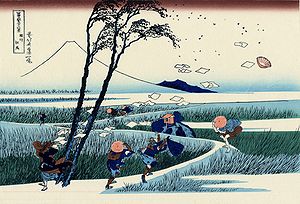

江戸時代までの絵画は公家、大名などの庇護による土佐派や狩野派が主であった。その中で風俗画も描かれていたが承応年間頃(1654年)には衰退し、庶民階級による風俗画が描かれるようになった[1]。
これは、土佐派や狩野派から転身した者や庶民階級から出現した絵師が浮世絵の源流を形作ることになったことによる。明暦の大火により江戸の町が焼き尽くされた後、町人の経済力は強くなり風俗画はその階級の気風の要求に応えるものに変化していった[2]。岩佐又兵衛の工房による風俗画はそれまでの風俗画と浮世絵を繋ぐものであり[注釈 1]、菱川師宣に至り風俗画を1枚の独立した絵画作品としたことで浮世絵の始祖と呼ばれている[4][5][6]。
浮世絵の作品形態は、肉筆画[注釈 2](筆で直に描いたもの)と木版画(印刷物)に分かれ[7]、後者は一枚摺と版本(書籍)に分かれるが、庶民に広まった背景として、大量生産とそれによる低価格化が可能な版画形式があげられる[8]。商業資本たる版元の企画の下での、絵師(作画)、彫師(原版彫)、摺師(印刷)の分業体制が確立され、まとまった部数を摺ることによって、廉価で販売、版本の場合は貸し出すことが出来た[9][10]。
題材は、大名や武家などの支配階級ではなく庶民町民階級からみた風俗が主であり多岐に及ぶ。初期には歌舞伎や遊郭などの享楽的歓楽的世界[注釈 3]が対象となっており多くの役者絵や美人画が描かれていった。後に武者絵や風景画(名所絵)など数多くの題材に拡がっていった[12][13]。同時に流行や報道的な社会性を帯びていることから、江戸幕府に対する体制批判や風俗の乱れを封じるために度々内容に規制をかける禁令が幕府より出される事態にもなった[14]。
19世紀後半になるとパリ万国博覧会(1867年)に浮世絵も正式出品され反響を呼び、ジャポニスムのきっかけにもなり印象派の画家たちに影響を与えた[15]。 20世紀以降では、変化・消失した名所、人々の生活や生業、文化などを伝える歴史資料としても活用されている[16]。
語源
[編集]「浮世絵」の語の初出は、1681年(延宝9年)の俳書『それそれ草』での「浮世絵や 下に生いたる 思ひ草 夏入」である[注釈 4]。
「浮世」とは、平安時代初期に見られる「苦しい」「辛い」を意味する「憂し」の連体系である「憂き」に名詞の「世」がついた「憂き世」が語源であり[18][19][20][21]、一例として『伊勢物語』では「つらいことの多い世の中」という意味で用いられる[18][22][注釈 5]。一方で、同時代の「古今和歌集」「後撰和歌集」「拾遺和歌集」の三代集では「世のうき時」「うき世の中」といった表現が多く未だ語句として定まっておらず、「うき世」が多用されるのは平安時代中期の「後拾遺和歌集」以降である[18]。平安時代末期になると定めない無常の世という観念が付加され「浮き世」と表記されるようになるが、これには漢語「浮生」の影響もあったとされる[18][19][21][注釈 6]。
中世末・江戸時代初頭になると、前代の厭世的思想の裏返しとして享楽的に生きるべき世の中と逆の意味で使われるようになる[18][注釈 7] [注釈 8] [注釈 9]。そこから「浮世絵」に代表されるように当代流行の風俗を指す「当世風」といった意味でも用いられるようになる[18]。
『柳亭記』(1826・文政9年頃)において、「浮世といふに二つあり。一つは憂世の中、これは誰々も知る如く、歌にも詠て古き詞なり。一つの浮世は今様といふに通へり。浮世絵は今様絵なり。」と説明している[18][24]。
歴史
[編集]
諏訪(2008)[25]に従って、以下の4期に分けて説明する[注釈 11]。
- 江戸前期 – 慶長・元和年間(1596年-1624年)から宝暦年間(1751年-1764年)、約150年
- 江戸中期 - 明和元年(1764年)から寛政年間(1789年-1801年)、約35年
- 江戸後期 - 享和年間(1801年-1804年)から慶応年間(1865年-1868年)、約70年
- 明治以降 - 明治元年(1868年)以降
江戸前期
[編集]
最初期の浮世絵には、版画がなく、肉筆画のみであった。桃山期の「洛中洛外図屏風」と比べ、岩佐又兵衛の同屏風(通称「舟木本」。慶長19年-元和元年〈1614-15年[28]〉)は、民衆の描写が目立つようになり、そこから寛永年間(1624-44年)頃に「彦根屏風」「松浦(まつら[注釈 12])屏風[30]」(3点とも国宝)といった、当世人物風俗を全面に出す作品が生まれた[31][32][33][34]。「湯女図」(MOA美術館蔵。重要文化財)での、左から三番目の桜花柄小袖の女に見る、体を「く」の字に折る姿勢は、後の菱川師宣や、懐月堂派らの見返り美人図の原型になったとの指摘がある[35]。
美人画は、風俗画からの発展だけでなく、禅寺にあった明朝の楊貴妃像を日本女性にあてはめた説があるが[36]、落款に「日本絵師」「大和絵師」と書したのが、菱川師宣である。安房国の縫箔(金銀箔を交えた刺繍)屋出身。「見返り美人」(東京国立博物館蔵)に代表される掛物(掛け軸)のほかに、巻子(かんす。まきもの。)、浮世草子、枕絵などの版本と、多彩な活動をした。師宣の登場は、17世紀後半に、江戸の文化が、上方のそれに肩を並べる契機となる[37]。版本は、最初は墨一色だが、後期作品として、墨摺本に筆で彩色する「丹絵」が表れ、一枚摺りも登場する[38][39]。 師宣没後、奥村政信は、赤色染料を筆彩した紅絵や、墨に膠を多く混ぜ、光沢を出す漆絵、柱絵に浮絵も創始し、2・3色摺りを可能にした紅摺絵や、拓本を応用した、白黒反転の石摺絵の創始にもかかわった。そして、絵師だけでなく、版元「奥村や」を運営し、自由な作画と販売経路を得た。また、自身の作品を取り扱うだけでなく、他の版元と商品を卸しあい、商機を広めた。活動期間も半世紀に渡った[40][41][42]。
歌舞伎は江戸初期に生まれ、幕府の禁令もあり、成人男性のみが演ずる形になった[43]。歌舞伎の役者絵に特化したのが鳥居派である。「瓢箪足蚯蚓描(ひょうたんあし みみずがき)」と呼ばれる、瓢箪のようなくびれた足に、蚯蚓が這いまわったような強い墨線を生かした描写[44]、「大々判」という大きな判型(約55×33センチ[45])で知られた。鳥居派は現在も継承されており、歌舞伎座の看板を手がけている(鳥居清光)[46]。
懐月堂安度ら懐月堂派は、工房で肉筆の美人画を量産した。庶民を購入層とし、安価な泥絵具を用いた[47]。
1720年(享保5年)に8代将軍徳川吉宗が禁書令を緩和し、キリスト教に関係のない蘭書の輸入を認めたことで、遠近法を用いて描かれた銅版画等を見る機会が生まれた。遠近法は、奥村らによる浮絵を生むこととなる[48][49]。
江戸中期
[編集]
明和元年(1764年)、旗本など趣味人の間で絵暦交換会が流行した。彼らの需要に応えたのが鈴木春信である。彼らの金に糸目をつけない姿勢が、多色(7・8色)摺り版画を生みだすこととなった。錦のような美しい色合いから「錦絵」(東・吾妻錦絵)と呼ばれる[50][51][49]。上述の奥村政信らが、重ね摺りの際、ずれを防止する目印、「見当」を考案したことと、高価で丈夫な越前奉書紙が用いられたことが、錦絵を生み出す要因となった[52][53][50] 。
春信の錦絵は、絵暦以外でも、和歌や狂歌 、『源氏物語』『伊勢物語』『平家物語』などの物語文学を、当世風俗画に当てはめて描く「見立絵」が多く、教養人でないと、春信の意図が理解できなかった。高価格[注釈 13]の摺物[56]であり、ユニセックスな人物描写も含め、庶民を購入対象としていなかった[注釈 14]。
墨の代わりに露草等の染料を用いた「水絵」(みずえ)が、明和年間初頭に流行り、春信らの作品が残るが、現存する作品は、大部分が褪色してしまっている[57][注釈 15]。
勝川春章は安永年間(1772-81年)に細判[注釈 16]錦絵にて、どの役者か見分けられる描写をし、役者名が記されていなければ特定不能な、鳥居派のそれを圧倒した。同様の手法で、相撲絵市場も席巻した。天明年間(1781-89年)には、肉筆美人画に軸足を移し、武家が購入するほど、高額でも好評であった[61][62]。弟子の春好 は、役者大首絵を初めて制作した[63]。

鳥居清長は書肆(しょし。書店のこと。)出身で、屋号の「白子屋」をそのまま号とした。天明年間(1781-1789年)に、長身美人群像を大判横2・3枚続きで表現した。前景の群像と後景の名所図は、違和感なく繋がり、遠近法の理解が、前世代の奥村らより進んだことが分かる。鳥居派として、役者絵も描いたが、上述の組み合わせを応用し、役者の後ろに出語り(三味線と太夫)を入れ込む工夫をした[64][65][66]。春画『袖の巻』は、12.5×67センチという、小絵[注釈 17]のように極端な横長サイズに、愛する男女をトリミングして入れ込んだ、斬新な構図である[68] 。

喜多川歌麿が名声を得るのは、版元蔦屋重三郎と組み、1791年(寛政3年)頃に、美人大首絵を版行してからである。 雲母摺りの「婦人相学拾躰」、市井の美人の名前を出せないお触れが出たので、絵で当て字にした「高名美人六家撰」、顔の輪郭線を無くした「無線摺」、花魁から最下層の遊女まで描く等、さまざまな試みを蔦重の下で行った。また絵入狂歌本『画本虫撰』『潮干のつと』等では、贅を尽くした料紙、彫摺技術がつぎ込まれた 。1804年(文化元年)、『絵本 太閤記』が大坂で摘発され、手鎖50日の刑を受け、その2年後に没した[69][70][71][72]。

寛政2年(1790年)、「寛政の改革」の一環として、改印(あらためいん)制度[注釈 18]ができた。以降も松平定信が老中を辞す寛政5年(1793年)まで、浮世絵への取り締まりが度々行われた。上述の歌麿が受けた、「市井の美人の名前を出せないお触れ」もその一つである。改印制度自体は、明治5年(1872年)まで続く[74]。
寛政7年(1795年)5月、蔦屋重三郎が、東洲斎写楽による大首役者絵28点を一挙に版行する。無名の絵師に、大部でかつ高価な黒雲母摺大判を任せるのは異例である。版元の判断だけでなく、何らかのスポンサーがいたのではと考えられる。また当時、歌舞伎座が不況にあえいでおり、鳥居派もそのあおりを食らっていた。その間隙を縫ったのが蔦重である[75] 。それまでの役者絵は、贔屓客に買ってもらう為、役者を美化して描いたが、写楽は、悪役の醜さや、女形の老いを描いた。28点の当時の評価については、記録が無いが、その後の作品からは、写実描写が影を潜め、定紋や屋号の誤りも見られるようになり[76]、太田南畝ほか『浮世絵類考』(享和2年・1802年)に記されるように「あまりに真を画かんとてあらぬさまに書なせしかば長く世に行はれず。一両年にして止む」こととなった。活動期間は10か月以下だった[75]。
対して、歌川豊国は、典型的な美化した役者絵や、曲亭馬琴・山東京伝らの読本挿絵を描いて、商業的成功を得る。『絵本太閤記』で歌麿と共に摘発されたが、歌麿没後は、美人画でも彼の隙間を埋めることとなる。多くの弟子を得、浮世絵最大流派となる歌川派の基礎を築く[77]。
江戸後期
[編集]
渓斎英泉は遊女屋や白粉屋の経営をしていた経験があり、それが美人画に活かされたのか、「婀娜あだ[78] 」と呼ばれる、「鼻筋が通った面長で、つり目で受け口の歪曲された顔貌表現[79] 」といった、その時代特有の美を示した[80]。
英泉と同時代の祇園井特は、京で廃頽的な美人肉筆画を描いた。文化・文政期(1804-30年)には、下唇が緑色に見える笹紅[注釈 19]が流行する[82]。

葛飾北斎は、勝川春章の下で役者絵を描き、その後、俵屋宗理(そうり)を名乗り、独自の肉筆美人画様式を得、そして北斎を名乗る。銅版画を真似た名所絵木版実験作を発刊、曲亭馬琴の読本『椿説弓張月』で挿絵を担当し、馬琴との共著が続くこととなり、絵師としての名声を得る。その後『北斎漫画』もヒットし、版元西村屋与八と組んだ『富嶽三十六景』で輸入染料ベロ藍を用い、藍一色摺りや拭きぼかしを駆使し、斬新な構図も含め、広く世間に受け入れられる。その後西村屋と『諸国瀧廻り』『諸国名橋奇覧』や、版本『富嶽百景』も版行し、名所絵という新ジャンルを確立した。90歳で亡くなるまで絵師であり続けた[83][84][85]。娘応為 は、晩年の父の作画を手伝ったとされ、自身も明暗を強調した肉筆画を残した[86] 。
歌川広重は、『東都名所』(文政13-天保2年・1830年-31年)以降、ベロ藍を用いるが、北斎に比べ、抑えた色使いであった。天保5年(1834年)頃、版元保永堂から『東海道五十三次』全55枚揃えを版行する。残存枚数及び版木の消耗具合から、相当売れたことが推察できる。また、全揃いを画帖に仕立てたものもあり、武家や豪商の購入が考えられる。『富嶽三十六景』と版行時期が近く、版元と広重が、北斎を意識していたと考えられる[87]。安政3-5年(1856年-58年)に、版元魚屋(さかなや・ととや )栄吉[88]の下、目録を含め120枚揃い(うち1枚は二代広重筆)の『名所江戸百景』が版行される。

本シリーズでは、ベロ藍に加え、洋紅も用いられるが、『東都名所』同様、色使いは抑制される。また広角レンズで覗いたような、前景を極端に大きく画く「近接拡大法」を、多くの作品で採用している。全て縦長であることも、これまでの名所絵には無いもので、『東海道五十三次』同様、画帖仕立の為と考えられる[89][90][91][92]。
歌川国貞は豊国門下で名を上げ、三代豊国を襲名する。柳亭種彦と組み、『偐紫田舎源氏』等の合巻の挿絵で成功を得る。役者絵や美人画でも人気を得、最晩年、版元恵比寿屋庄七での、役者大首絵シリーズ全60図は、生え際の彫りや空摺り・布目摺り、高価な顔料を用いる等、手間暇がかけられており、一枚百数十文から二百文で売られたようだ。市場の成熟ぶりが見られるが、このシリーズでは、出資者に関する史料が残っている[93]。浮世絵師として、最も多くの作品を残したといわれる[94][95]。

元 ・明期に成立し、日本でも読本に取り入れられて人気を得た「水滸伝」は、当然のごとく、浮世絵でも取り扱われる。歌川国芳は、版元加賀屋吉右衛門での『通俗水滸伝豪傑百八人』シリーズで人気を得る。2・3枚続きもあり、国貞の役者絵同様、高価だったと思われる。天保14年(1843年)の「源頼光公館土蜘作妖怪図(みなもとの よりみつこうの やかたに つちぐも ようかいを なすの ず)」は『太平記』に記される平安時代中期の逸話だが、版行後、「 天保の改革」での贅沢禁止を揶揄し、12代将軍家慶 と 老中 水野忠邦を描き込んだと噂が立ち、加賀屋は摺物を回収、版木を削り落としたが、海賊版が横行した[96][97]。 なお、江戸時代は、大坂冬の陣・夏の陣 や、島原の乱を除けば、泰平の世であり、かつ織豊期以降の時代風刺は禁じられていた [注釈 20]ので、それ以前の史実を、当世の暗喩として表現する方法を取った。暗喩の有無を問わず、これらの作品を「武者絵」と呼ぶ[98][99] 。
国芳は役者絵以外に、「戯画」も多く作画し、「金魚づくし」シリーズ等、動物を擬人化したり、「みかけハこハゐがとんだいゝ人だ」のように、複数の裸の男を組み合わせ、顔を表現したり、天保の改革で役者絵が禁止されたので、「荷宝蔵壁のむだ書」のように、壁のひっかき傷で役者をひそかに表現したりした。改革に抵抗し、笑い飛ばす姿勢が窺える[100][101][96][102][103]。
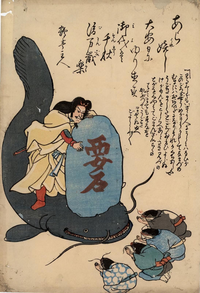
安政2年(1855年)10月、江戸で大地震が発生し、その直後、「鯰絵」が多くの版元から版行された。ナマズが地震を起こすという言い伝えは、江戸時代中期からあった。ナマズは日本列島を下から支え、その頭部が鹿島神宮にあたり、神宮境内に鎮座する「要石(かなめいし)」でナマズを押さえていたと考えられたが、地震当日は神無月だった為、鹿島明神が出雲大社 での神々の会議で出払っていたせいで、地震を抑えられなかったと江戸の人々は考えた。
その為、鹿島明神がナマズを要石で押さえつける鯰絵が緊急版行された。それ以外にも多くの図柄があり、ナマズが町人に地震を起こしたことを謝ったり、家屋の普請を手伝ったりする絵もある。緊急版行なので、改印および版元・絵師印は皆無だが、画風から歌川派作品が多いと推測される。前向きに生きていこうとする町人の勢いが垣間見える[104][105][106]。

嘉永7年(1854年)3月、 日米和親条約により、200年以上に渡る「鎖国」は終焉した。安政5年(1858年)には 日米修好通商条約及びオランダ・ ロシア・フランス・イギリスと、同等の条約が結ばれ、和親条約で定められた 下田・ 函館2港に加え、4港開港とそこでの居住が許された。その内、江戸から最も近い横浜は、翌安政6年(1859年)に開放され、江戸・神奈川[注釈 21]の人々は、これまでに見たこともない、外国人の顔貌や服装、建造物に興味を引かれた。その結果生まれたのが「横浜絵」である。1860年(安政7・万延元年)から1872年(明治5年)にかけて、大部分が江戸の版元から版行された。絵師は 歌川芳虎 ・ 芳員ら、国芳門下が多い[107][108]。また、五姓田芳柳らによる、居留者の似顔を、絹地に在来顔料で陰影を付けて描き、それに和装姿をモンタージュした「絹こすり絵」(絹本肉筆画)も、横浜絵に含まれる[109] 。
慶応2-3年(1866年-67年)に、国芳の門人である月岡芳年と、芳年の弟子である落合芳幾による「英名二十八衆句」が版行された。これらの28点は、鶴屋南北作『東海道四谷怪談』の歌舞伎ものや、史実から取られ、全点が殺戮を描く「血みどろ絵」である[110][111]。同時期に、土佐国の町絵師絵金が、芝居の題材を元に、「血みどろ絵」二双屏風(二つ折りの屏風)を残した[112][113]。これらの作品が生まれたのは、その時代、実際に切り捨てられた屍骸を見たためではと指摘される[111]。
明治以降
[編集]
慶応3年(1867年)、徳川慶喜の大政奉還により、徳川幕府260年余の歴史は終わる。その後、反幕府側の薩摩藩が、慶喜に圧力を掛けたため、翌慶応4年(1868年)に、鳥羽・伏見の戦い、後の戊辰戦争 に至る[114]。それらを版行したのが「戦争画」であり、江戸期の「武者絵」とは区別する。特に江戸が戦場となった、上野山での、彰義隊と新政府軍との戦いが多く版行された。旧幕府側には、旧来の「改め」をする力は無く[注釈 22]、新政府側にとっては、自派の宣伝になるのだから、版行を黙認した。それ以降も、佐賀の乱、台湾出兵(ともに明治7年・1874年)、西南戦争(明治10年・1877年)、日清戦争(明治27年-28年・1894年-95年)、日露戦争(明治37年-38年・1904年-05年)が版行された[116][117][118]。

1868年(慶応4年)7月、江戸は「東京」に改められ、9月に明治に改元、翌明治2年(1869年)2月に天皇が旧江戸城に入り、名実ともに日本の首都となる。明治5年(1872年)には、新橋-横浜間に鉄道が開通し[注釈 23]、日本橋周辺に、木造に石材を併用し、2階建て以上、バルコニー付きの「擬洋風建築」が建てられてゆく[119]。それに人力車・馬車やガス燈など、東京の変遷ぶりを描いたのが「開化絵」である。三代広重や、国輝らの歌川派が代表例で、「洋紅」を多用した、どぎつい色調のものが多い[120][121][122][123]。

小林清親は、下級武士として、将軍家茂・慶喜に従い、鳥羽・伏見の戦いに加わり、旧幕府敗北後、謹慎する慶喜に従い、静岡へ。明治7年(1874年)、東京に戻り、絵師として立つ。光を意識した東京名所図を描き、「光線画」と呼ばれる。都市を描く点では「開化絵」の要素もあるが、絵師ごとの個性が乏しいそれとは、物の見方や色使いが異なる[124][125]。

幕末に血みどろ絵を描いた月岡(大蘇)芳年は、明治10年代半ばになると、「歴史画」に注力する。
開国・新政府成立により、欧化政策が勧められ、明治9年(1876年)には、工部省が「工部美術学校」を設立し、イタリア人画家・彫刻家・建築家を招聘する。しかし政府は、輸出品として、ヨーロッパの真似ではなく、在来の工芸品の方が売れることを認識する。そして、国内体制を強固にするには、天皇の権威を高め、「国史」の重要性を認識し、歴史画が尊ばれることとなる。また、欧化政策によって冷や飯を食わされていた狩野芳崖・橋本雅邦らは、文部官僚の岡倉天心と、政治学・哲学のお雇い教師 として来日したが、その後日本美術に開眼し、天心と行動を共にするアーネスト・フェノロサの、洋画と南画を排斥した、新しい絵画[注釈 24]を生み出す主張に同調する[129]。
その時代に注目されたのが、菊池容斎の『前賢故実』(全10冊。天保14年-明治元年・1843年-68年)である。神武天皇から南朝時代の後亀山天皇時代までの公家・貴族・僧・武士・女房ら571人の故実と、彼らに見合う装束と顔貌を見開き一丁(2ページ)に描いたもので、明治10年代以降、画家の「粉本」[注釈 25]として盛んに引用される。浮世絵師を含む在来画家に限らず、洋画家も『前賢故実』を参照して描くことになる[130][131]。
日清・日露戦争後、新聞や雑誌、石版画・写真に絵葉書が普及し、浮世絵師は、挿絵画家などへの転向を余儀なくされる[132]。明治40年(1907年)10月4日朝刊の朝日新聞「錦絵問屋の昨今」には、「江戸名物の一に数へられし錦絵は近年見る影もなく衰微し(略)写真術行はれ、コロタイプ版起り殊に近来は絵葉書流行し錦絵の似顔絵は見る能はず昨今は書く者も無ければ彫る人もなし」とある[133]。鏑木清方は、かろうじて大正時代まで絵草紙屋があったと語る[134]。

逆風のなか渡辺庄三郎は、1905年(明治38年)に摺師と彫師を雇用して、版元を興す。当初は古版木摺り、及び良質な摺り物からの版木起こしと、復刻品だけだったが、大正に入り、絵師と交渉して、新版画を制作するようになる。橋口五葉・伊東深水・川瀬巴水・山村耕花らを起用し、また彼らも木版画による表現に刺激を受けた。
1923年(大正12年)、関東大震災 によって、渡辺も壊滅的な被害を負い、多くの版元が廃業に追い込まれた。しかし彼は再起し、渡米経験のある吉田博を起用、欧米で売れる作品を版行した。渡辺は昭和37年(1962年)に亡くなる[135][136][出典無効]が、彼の版元は21世紀でも健在である[137]。また、アダチ版画研究所も同様の制作・営業を行っている[138]。
浮世絵の画題
[編集]大久保(1994)[139]を参考に、区分する。そこに記載されていない「死絵」「長崎絵」「歴史画」「おもちゃ絵」を追加した。大久保(1994)以外の文献を用いた場合は、注を付す。

- 美人画
- 成人女性を描いたもので、遊女や茶屋の看板娘が多く描かれた。
- 見立絵
- 和漢の故事や謡曲の場面を当世装束に当てはめて描いたもの。和歌や漢詩は記されても、細かな説明はない。
- 春画
- 枕絵とも呼ぶ。男女(同性同士もある)の営みを描いたもの。非合法であり、絵草紙屋(書店)に並ぶことはなく、富裕層が肉筆画を注文したりした。
- 役者絵
- 歌舞伎の人気役者や上演場面を公演ごとに描いたもの。
- 死絵
- 人気役者が亡くなった時、報道を兼ねて出されたもの。歌川広重・歌川国貞のものもある[141][142]。
- 名所絵
- 明治以降の、画家が良いと思った所ではなく、人々に広く知られたところを描いた。絵師は取材せずに、既にある絵から写したものが多い。
- 浮絵
- 蘭書の挿絵を見た絵師が、そこでの線遠近法を誇張して建造物等を描いたもの。

- 花鳥画
- 主要画題ではなかったが、喜多川歌麿・葛飾北斎・歌川広重・小林清親らが質の高い作品を残した。
- 武者絵
- 故実だけでなく、当世事情を織豊期以前の武将に当てはめ(直接表現はご法度だった)、ひそかに幕府批判をする例があった。
- 戯画
- 葛飾北斎『北斎漫画』の他に、歌川国芳が得意とした。浮世絵#江戸後期参照。
- 相撲絵
- 力士や土俵入り、取り組みを描いたもの。役者絵同様、興行ごとに新作が出る。
- 長崎絵
- 蘭船や出島でのカピタンや唐人、彼らの風習を描いた。一枚絵は合羽摺が多く、長崎の版元から売り出された[143]。

- 鯰絵
- 1855年(安政2年)の大震直後に出た絵。浮世絵#江戸後期参照。
- 横浜絵
- 開国後、横浜を舞台にした外国人の風俗を描いたもの。浮世絵#江戸後期参照。
- 開化絵
- 維新後の東京での、洋館・鉄道・馬車・人力車・ガス燈などを描いたもの。浮世絵#明治以降参照。
- 戦争絵
- 戊辰戦争から日露戦争までの戦争を描いたもの。浮世絵#明治以降参照。
- 新聞錦絵
- 1874(明治7年)、東京日日新聞別刷りに落合芳幾が描き、商業的成功を得、郵便報知新聞は月岡芳年を起用、追随する。純粋な新聞には速報性で劣るので、殺人など、過激な題材をどぎつい色を用いて描写した[144][145]。
- 歴史画
- 明治10-20年代に、国民意識を高めることを意識した、歴代天皇やその血族、忠君を描いたもの。浮世絵#明治以降参照。
- おもちゃ絵
- 上方で組み立て模型「立板古」(たてばんこ)が流行し、江戸でも18世紀末に受け入れられる。明治期には歌川芳藤がおもちゃ絵専門絵師として活躍[146][147][148]。
主な版元
[編集]
娯楽出版物を扱う地本問屋(じほんといや・とんや)が浮世絵の版元となっている。「地本」とは、上方から齎されたものではなく、江戸独自のものであることを示す[149]。
- 松会三四郎 - 江戸最古の版元といわれる。菱川師宣の絵本などを出版。
- 鱗形屋三左衛門 - 菱川師宣の絵本、浄瑠璃本を出版。
- 伊賀屋勘右衛門 - 懐月堂度繁などの作品を出版。
- 鶴屋喜右衛門(鶴屋) - 老舗の一つ。『東海道五十三次』を途中まで出版。
- 奥村屋政信(鶴寿堂) - 自らの作品などを出版。
- 和泉屋市兵衛(甘泉堂・泉市) - 天明-明治初期の代表的版元。喜多川歌麿、歌川広重、歌川国貞などの作品を手がける。
- 西村屋与八 - 『冨嶽三十六景』など葛飾北斎の作品を多く手掛ける。
- 蔦屋重三郎 - 喜多川歌麿、東洲斎写楽らを輩出。
- 三平 ‐ 歌川広重の団扇絵を出版している。
- 伊場屋仙三郎 / 伊場屋久兵衛(伊場仙 / 伊場久) - 東海道張交図絵(歌川広重)。元は幕府御用の和紙・竹製品店。それにもかかわらず、風刺絵や役者絵禁止令が出された後にも「落書き」と称して役者絵を出版している。団扇絵を多く手掛け、現在は日本橋で団扇、扇子、カレンダー業を営み、新宿伊勢丹、日本橋三越、銀座伊東屋などに出店している。
- 有田屋清右衛門 - 「東海道五十三次・有田屋版」(歌川広重)
- 伊勢屋利兵衛 - 「東海道五十三次 絵本駅路鈴」(葛飾北斎)
- 魚屋栄吉(魚栄) - 歌川広重、歌川国貞らの作品を手がける。
- 上村与兵衛(上ヨ / 上村) - 後発の新興版元。22歳の歌川国政を抜擢し、鮮烈なデビューを飾らせた。
- 川口屋正蔵 ‐ 歌川広重、歌川国芳の錦絵を出版。
- 蔦屋吉蔵 - 「東海道五十三驛之図」、「東海道・蔦屋版」(歌川広重)
- 西村屋祐蔵 - 「富嶽百景」(葛飾北斎)
- 藤岡屋彦太郎 / 藤岡屋慶次郎 - 「東海道風景図会」(歌川広重・文:柳下亭種員)
浮世絵版画の制作法
[編集]

この章は、安達・小林(1994年)[150]池田(1997年)[151]を基に記述する。
企画を立てる人を版元、版元からの注文で描く人を絵師と呼ぶ。絵師が描いた下絵を版に彫るのが彫師、版木に色具を付け、紙に摺るのが摺師である。版元と絵師の名だけが作品に記されることが多いが、彫師・摺師の名が入ることもある。
- 版元が企画を立案し、絵師に作画を依頼する。
- 絵師が版下絵を描く。
- 絵師は墨線だけを用いて主版(おもはん)の版下を描く。
- 版元は版下絵を、絵草子掛りの名主に提出、出版許可の印を捺してもらい、彫師に渡す。
- 彫師が主版を彫る。
- 摺師は主版の墨摺り(校合摺り)を10数枚摺って絵師に渡す。
- 絵師は校合摺りに各色版別に朱で色指定をする。また、着物の模様などの細かい個所を描き込む。
- 指示に従い、彫師は色版を作る。
- 色指定された校合摺りを裏返して版木に貼り、刀入れを行う。まず三角刀で各版に模様を彫り込むが、墨版については各色版の部分も含めて彫りを加える(無駄彫りという)。この無駄彫り版で摺った紙を版木に貼り付けて色数に応じた色版を彫る。無駄彫り版と色版とを絵合わせし、調整後、無駄彫り版の墨以外の部分を削り取る。
- 次に各版の不要な部分をのみと木槌で大まかに削り、さらに細いのみで仕上げ彫りを行う。
- 仕上げ彫りの工程で見当合わせ用の「鍵」と「引き付け」を残しておく。多色刷りの際に色がずれないように紙の位置を示す「見当」(トンボ)を作る。
- 摺師は絵師の指示通りに試し摺りを作る。
- 絵師の同意が得られれば、初摺り200枚を馬楝で摺る。
- 絵草子屋から作品を販売する。
値段
[編集]浮世絵の値段は、しばしば「そば一杯」と同じとされる。実際の価格を調べると、浮世絵の形式や年代などによってバラつきがあるが、19世紀前後の大判錦絵の実勢価格は約20文前後で、19世紀半ばになっても総じて20文台で推移した事が、当時の史料や日記、紀行類などで裏付けられる。そば代は幕末で16文だったことから、ほぼ同等と見なせる[152]。
山東京伝の黄表紙『荏土自慢名産杖』(文化2年〈1805年〉刊)には、「二八十六文でやくしやゑ二まい 二九の十八文でさうしが二さつ 四五の廿なら大にしき一まい」というくだりがあり、しばしば諸書で引用される。なお、2枚で16文の役者絵とは、用紙もやや劣る細版の事だと考えられる。時代が遡った宝暦頃(1751-61年)の細判紅摺絵の役者絵は、1枚4文だったと記されている(随筆『塵塚談』文化11年〈1814年〉刊)が、これは紅摺絵が僅か2,3色摺りで、紙質も薄い分安価だったからだと考えられる。
寛政7年(1795年)の町触では、20文以上の錦絵は在庫限りは売ってよいが、新たに制作するものは16文から18文に制限されている(『類聚撰要』)。天保の改革では、色摺りは7,8回まで、値段は1枚16文以下に規制を受けている。この数字は採算割れすら招きかねない厳しい数字だったらしく、『藤岡屋日記』天保14年〈1843年〉春の記事には、紅を多用した極彩色の神田祭の錦絵は売れはしたが、16文の値段では売れば売るほど赤字になったという話が記されている。
鈴木春信の中版は、65文程度で売られ、代表作である「座舗八景」は8枚揃いで桐箱に入れられ、金1分(=銭1000文)もした[注釈 26]。他にも、天保の改革の風刺との風評が立った歌川国芳の大判三枚続『源頼光公館土蜘作妖怪図』は、商品回収のうえ、版木は削られる憂き目を見たが、歌川貞秀の模刻は、密かに100文で売られた(『藤岡屋日記』)り、同じく国芳の大判三枚続『八犬伝之内芳流閣』(1840・天保11年)は、1枚38文、3枚揃いで118文で売られ、曲亭馬琴は割高だと感じつつも、色版を多く使い通常より手間がかかっているからと聞き及んで、それを買い求めている(馬琴日記)[154]。
北斎研究家の永田生慈が、『北斎漫画』の版元であった名古屋の永楽屋東四郎に、値段を聞いたところ、「当時(幕末明初)の出版物は猛烈に高くて、普通の人が簡単に本を買いましょうという値段ではなかった」と証言している[155]。
明治になると出版条例改正によって定価表示が義務付けられ、浮世絵の値段がわかる。総じて1枚2銭、2枚続・3枚続でもこれに準じ、手間がかかるものはこの基準価格に5厘から1銭程度割増価格で売られている[156]。
展示と保存法
[編集]現代の美術館では、中性紙の厚紙(マット)の中央をくりぬき、もう一枚のマットと挟み込んで、保存する。展示時はそれを額装する[157]。紫外線による褪色を防ぐため、直射日光を避け、紫外線カットの照明下で展示すべきである。通年展示してはならない[158][159]。
展示しないときの保存方法としては、額から外し、水平に置くことが望ましく、変色を防ぐため、防虫剤の入っていない桐箪笥など、湿度調整が効く箱に仕舞うことが良い[160]。
絵具
[編集]

浮世絵版画に用いられたのは、植物由来の染料や鉱物由来の顔料であるが、19世紀になると、化学染料が輸入、使用される[161][162][163]。
黒は墨が用いられ、多色刷り版画では以下の顔料・染料が用いられる。
- 赤色系
- 黄色系
- 青色系
などがあり、中間色はこれらを混ぜ合わせて表現した。
その他、版画の表現に以下のものが用いられた。
- 雲母:ケイ酸化合物(背景に用いたものは雲母刷(きらずり)と呼ばれる[164]。
- 金属:金、銀、銅を粉や箔として。高価な為、商業用ではなく、パトロン対象の「摺物」で使用。
- 白色顔料は、「摺物」を除き、和紙の地の色を生かし、ほとんど用いられなかった。
後世の評価・収集
[編集]

(右)ゴッホによる模写(油彩画)
19世紀以降、多量の作品が国外に渡り、ヨーロッパの芸術家たちに影響を与えた。ボストン美術館には約5万点[165]、ヴィクトリア&アルバート博物館には約3万8000点[166]、大英博物館には2万点[166]、プーシキン美術館には約3万点[要出典]、その他ドイツ、イタリア等、欧米美術館[166]、大学等教育機関収蔵品、個人コレクションなど、海外にはおよそ50万の浮世絵が収蔵されており、これは国内の30万を超えるとされる[167]。
版木を所蔵している美術館や博物館、図書館などもある。版木は使用後に破棄されることが多かったため、貴重な文化遺産であり、版木の調査・修復、さらに所蔵施設との許可を得て、摺りを再現する版画家もいる[168]。
日本の主要な個人コレクション
[編集]国内では、大名家や実業家のコレクションがある。
- 津島コレクション:房総浮世絵美術館
- 浦上コレクション:山口県立萩美術館・浦上記念館
- 小針コレクション:光記念館
- 酒井コレクション:日本浮世絵博物館
- 高橋コレクション:慶應義塾図書館
- 松方コレクション:東京国立博物館
- 青木コレクション:那珂川町馬頭広重美術館
- 氏家武雄コレクション:鎌倉国宝館
- 出光コレクション:出光美術館
- 大谷コレクション:旧ニューオータニ美術館[注釈 27]
- 太田コレクション:浮世絵 太田記念美術館
- 今西コレクション:熊本県立美術館
- 平木コレクション:平木浮世絵美術館 UKIYO-e TOKYO
- 松井コレクション:礫川浮世絵美術館
日本国外への影響
[編集]
浮世絵がヨーロッパに最も早く渡った例として、1798年(寛政10年)に、カピタンらが葛飾北斎に日本人男女の一生を図した巻子を注文し、故国に持ち帰ったことが挙げられる。またシーボルトは多量の日本資料を持ち帰り、1832-52年に『Japonica』20分冊を刊行するが、そこには『北斎漫画』が掲載されている[169]。
1856年、ブラックモンが、日本から輸入された陶磁器の包み紙に使われていた『北斎漫画』を見せ回ったことで、美術家に知られるようになったとの「逸話」は、1990年以降では、疑問視されている[169][170]。
ゴッホが『タンギー爺さん』の背景に浮世絵を描き込んだり、歌川広重の作品を模写した。エドゥアール・マネ、エドガー・ドガ、メアリー・カサット、ピエール・ボナール、エドゥアール・ヴュイヤール、ロートレック、ゴーギャンらにも影響を与えた(ジャポニスム)[171]。
日本美術を取り扱っていたビングは、自身の工芸作品に浮世絵表現を取り入れた[172]。
クロード・ドビュッシーは、葛飾北斎の神奈川沖波裏を所蔵し、同図の波の形状を、『交響詩“海”』の楽譜表紙に採用した[173][174][注釈 28]。
脚注
[編集]注釈
[編集]- ^ 岩佐又兵衛を浮世絵の父と評することもある[3]
- ^ 肉筆浮世絵ともいう
- ^ 歌舞伎や芝居町、遊里遊郭は風俗を乱す場所とされ「悪所」と呼ばれた[11]。
- ^ 頴原退蔵(1947)『江戸時代語の研究』臼井書房[17]より孫引き。
- ^ 『伊勢物語』八二(10世紀前半) 「散ればこそいとど桜はめでたけれうき世になにか久しかるべき」
- ^ 『荘子』刻意篇第十五』「聖人之生也天行、其死也物化、靜而與陰同德、動而與陽同波(略)其生若浮、其死若休。」「聖人が生きている時は自然のままにふるまい、死んで行くときは万物の変化のままに従い、静かにしているときは陰の気にその徳(もちまえ)を合わせ、動くときは陽の気に変化を合わせる、と(略)その生きているときは流れのままに浮かぶかのように、その死んでいくときは休息するかのようである」[23]。
- ^ 『隆達節歌謡』(1593-1611・文禄2-慶長16年)の「花よ月よと暮らせただ、ほどはないものうき世は」 はかなく定めないのだから、深刻に考えないで、うきうきと享楽的にすごすべき世の中の意
- ^ 『隆達節歌謡』(1593-1611・文禄2-慶長16年)の「後生を願ひ、うき世も召され、朝顔の花の露より徒な身を」 享楽的欲望をみたしてくれる世界。遊里。また、遊里の遊びに夢中になること。浮世遊び。の意
- ^ 『仮名草子・恨の介』(1609‐1617)の「『心の慰みはうき世ばかり』とうちしげる」 男女間の恋愛。いろごと。情事。また、恋、好色、情事などの対象となる人の意
- ^ 東京国立博物館画像検索より引用“洛中風俗図屏風(舟木本)”. 2020年5月3日閲覧。
- ^ 4期以外に、石田ほか(1987)[26]の3期、稲垣(2011)[27]の5期区分もある。
- ^ 松浦氏旧蔵なので、「まつら」と読む[29]。
- ^ 宝暦年間(1751-64年)の細判(約33×15センチ)紅摺絵が1枚四文程度だったのに対し、春信の中判(約29×22センチ)錦絵は百六十文だった[54][55]。
- ^ 春信と交流のあった太田南畝の『半日閑話』明和七年六月の項に「この人一生役者の絵をかかずして云、我は大和絵師なり。何ぞ河原者の形を画くにたへんやと」とある。実際は、宝暦10年(1760年)以降に、複数の役者絵が残されている[54]。
- ^ 20世紀の終盤、立原位貫(たちはら・いぬき)は、春信らが用いた染料を復元し、摸刻摸摺をした[58][59]。
- ^ 約33×15センチ[52]役者絵は、興行を見てから下絵を描き、彫摺するので、小さい判の方が早く版行出来て、有利である[60]。
- ^ こえ。室町時代後期の、幅17センチ程度の小ぶりな絵巻物[67]。
- ^ 浮世絵版画に対し、幕府批判等、問題がないか調べ、問題なければ捺印した制度[73]。
- ^ 1813年(文化10年)に版行され、(大正12年)1923年の関東大震災で、版木が焼失するまで、100年以上摺り続けらけた、『 都風俗化粧伝(みやこふうぞくけわいでん)』には、「紅を口に染むるは、下唇には濃くぬり、上唇には淡く付けべし。上下ともに濃きは賤し(略)紅を濃く光らさんとするには、まず下地に墨をぬり、その上へ紅を濃く付けべし。濃く見え、紅の色青みて光る也(略)又法。紅を濃く光らさんとするに、下地に行燈 にたまりたる油煙をとりて、筆の先切れたるにつけてぬり、その上に紅を付けるもよしといえり」とある[81]。
- ^ 先述した、歌麿・豊国の『絵本太閤記』摘発、国芳の「源頼光公館土蜘作妖怪図」回収例を参照。
- ^ 県名の神奈川ではなく、東海道五十三次に含まれる地名。当初は横浜ではなく、神奈川が開港される予定だった。
- ^ 実際の改めは、地本問屋同士の自主検閲だったので、混乱下での版行も可能だった[115]。
- ^ 先述の「横浜絵」の下限を1872年としたのは、鉄道開通によって、時代の最先端が、横浜から東京に移ったことを意味している。
- ^ 山下は『狩野派復古主義』と呼ぶ[127]。なお「日本画」という用語は、「洋画」に対する対立概念であり、明治20年代に登場し、30年代に一般にも定着する[128]。
- ^ ふんぽん。狩野派で用いられた、見習い用の絵手本。これを写して絵を学んだ。
- ^ 高橋誠一郎(1932)「商品としての浮世絵版画」『三田学会雑誌』32(1)。[153]より孫引き。
- ^ 2014年に閉館し、コレクションの行方は公表されていない。
- ^ 国立音楽大学付属図書館のレファレンス調査では、神奈川沖波裏が「海」の楽曲自体に影響を与えたと述べる資料は無いとの回答が得られた“レファレンス協同データベース レファレンス事例詳細”. 国立国会図書館. 2022年9月25日閲覧。
出典
[編集]- ^ 吉田 1962, pp. 25–26.
- ^ 吉田 1962, pp. 51–57.
- ^ 吉田 1962, pp. 57–59.
- ^ 山口 1995, p. 21.
- ^ 田辺 2011, p. 108.
- ^ 小林 1998, pp. 24–29.
- ^ 大久保 2013, p. 8.
- ^ "浮世絵". コトバンク. ブリタニカ国際大百科事典. 2020年3月30日閲覧。
- ^ 小林忠. "浮世絵". コトバンク. 日本大百科全書(ニッポニカ). 2020年3月30日閲覧。
- ^ 国際浮世絵学会 2008, pp. 120–121長友千代治「貸本屋」
- ^ 日本生活史辞典 2016, p. 6.
- ^ 山口 1995, pp. 18–20.
- ^ 吉田 1962, pp. 26–31.
- ^ 稲垣 1990, p. 7.
- ^ 田辺 2011, p. 90.
- ^ 神谷 2014, p. 18.
- ^ 田辺 2016, p. 10.
- ^ a b c d e f g “精選版 日本国語大辞典” 2020年6月1日閲覧。
- ^ a b “デジタル大辞泉” 2020年6月2日閲覧。
- ^ “語源由来辞典” 2020年6月1日閲覧。
- ^ a b “学研全訳古語辞典” 2020年6月2日閲覧。
- ^ 大津 1964, p. 56.
- ^ 金谷 1975, pp. 222–224.
- ^ 小学館国語辞典編集部 2001, p. 150.
- ^ 国際浮世絵学会 2008, pp. 44–45諏訪春雄「浮世絵」
- ^ 石田ほか 1987, pp. 61–62.
- ^ 稲垣 2011, pp. 8-13、14-15、32-33、78、114-115.
- ^ 辻 2008, pp. 229–230.
- ^ 成瀬 2006, p. 1.
- ^ “婦女遊楽図屏風(松浦屏風)”. 2020年3月30日閲覧。
- ^ 辻 2005, pp. 293–294.
- ^ 国際浮世絵学会 2008, pp. 429–431河野元昭「風俗画」
- ^ 国際浮世絵学会 2008, pp. 178–179河野「近世初期風俗画」
- ^ 狩野 2014, pp. 243–257.
- ^ 佐藤 1993, p. 51.
- ^ 国際浮世絵学会 2008, p. 431河野元昭「風俗画」
- ^ 田辺 2016, pp. 8–11.
- ^ 国際浮世絵学会 2008, pp. 300–301武藤純子「丹絵」
- ^ 千葉市美術館 2016, p. 78田辺昌子「杉村治兵衛 女三宮とかしわぎのゑもん 」(東京国立博物館蔵。重要美術品。 )など
- ^ 藤澤 1996, p. 129.
- ^ 日野原 2014, pp. 189–190.
- ^ 千葉市美術館 2016, p. 187.
- ^ 国際浮世絵学会 2008, pp. 137–138諏訪春雄「歌舞伎」
- ^ 国際浮世絵学会 2008, p. 422武藤純子「瓢箪足蚯蚓描」
- ^ 国際浮世絵学会 2008, pp. 409–410田辺昌子「判型」
- ^ 武藤 2016, pp. 12–15.
- ^ 千葉市美術館 2016, p. 167.
- ^ 岸 1994, pp. 1–289.
- ^ a b “国立国会図書館 名所絵の誕生” 2020年3月30日閲覧。
- ^ a b 大久保 2014, pp. 172–173.
- ^ 千葉市美術館 2016, pp. 229、268-271.
- ^ a b 国際浮世絵学会 2008, pp. 409–411岩崎均史「判型」
- ^ 国際浮世絵学会 2008, p. 444田辺昌子「奉書紙」
- ^ a b 国際浮世絵学会 2008, p. 260藤澤紫「鈴木晴信」
- ^ 国際浮世絵学会 2008, p. 409岩崎均史「判型」
- ^ 国際浮世絵学会 2008, pp. 266–269浅野秀剛「摺物」
- ^ 国際浮世絵学会 2008, p. 463田辺昌子「水絵」
- ^ 目黒区美術館 2016, pp. 126-129、156-157.
- ^ “立原位貫オフィシャルホームページ”. 2020年4月1日閲覧。
- ^ 大久保 2014, pp. 173–174.
- ^ 国際浮世絵学会 2008, pp. 126–127内藤正人「勝川春章」
- ^ “雪月花図 勝川春章筆。MOA美術館所蔵。重要文化財。”. 2020年4月3日閲覧。
- ^ 大久保 2014, pp. 226–227田辺昌子「二代目市川門之助の曽我五郎 勝川春好」
- ^ 国際浮世絵学会 2008, pp. 349–350鈴木浩平「鳥居清長」
- ^ 大久保 2014, p. 175.
- ^ 大久保 2014, pp. 228–229田辺昌子「飛鳥山の花見・三代目沢村宗十郎の治兵衛と四代目岩井半四郎の小春」
- ^ サントリー美術館 2017, p. 222土屋真紀「地蔵堂草紙絵巻」
- ^ 永青文庫・春画展日本開催実行委員会 2015, pp. 322–330.
- ^ 小林・大久保 1994, pp. 205–208森山悦乃「版元の役割と蔦屋重三郎の活躍」
- ^ 浅野・クラーク 1995, pp. 47-54、65-66.
- ^ 国際浮世絵学会 2008, pp. 167–169浅野秀剛「喜多川歌麿」
- ^ 日野原 2014, pp. 187–188.
- ^ 国際浮世絵学会 2008, p. 14佐藤悟「改印」
- ^ 国際浮世絵学会 2008, pp. 15–16佐藤悟「改印」
- ^ a b 大久保 2014, p. 176.
- ^ 国際浮世絵学会 2008, p. 333浅野秀剛「東洲斎写楽」
- ^ 国際浮世絵学会 2008, pp. 62–63大久保純一「歌川豊国」
- ^ 国際浮世絵学会 2008, p. 11諏訪春雄「あだ」
- ^ 大久保 2014, p. 246田辺昌子「美艶仙女香といふ 潮くさき… 渓斎英泉」
- ^ 国際浮世絵学会 2008, pp. 186–187鈴木浩平「渓斎英泉」
- ^ 高橋 1982, p. 179.
- ^ 国際浮世絵学会 2008, p. 169太壽堂素子「祇園井特」
- ^ 鈴木 1999, pp. 13–409.
- ^ 国際浮世絵学会 2008, pp. 129–131伊藤めぐみ「葛飾北斎」
- ^ 大久保 2014, pp. 178–179.
- ^ 鈴木 1999, pp. 217-218、308-313.
- ^ 日野原 2014, p. 191.
- ^ 国際浮世絵学会 2008, pp. 212市川信也「魚屋栄吉」
- ^ 国際浮世絵学会 2008, pp. 67–68市川信也「歌川広重」
- ^ 国際浮世絵学会 2008, pp. 476–478原信田実「名所江戸百景」
- ^ 大久保 2014, pp. 179–181.
- ^ 画帖は、東洋文庫に収蔵されている“財団法人 東洋文庫 所蔵・岩崎文庫江戸百景 歌川廣重 一世画・二世補”. 2020年4月4日閲覧。
- ^ 小林・大久保 1994, pp. 64–65大久保「役者絵製作の舞台裏」
- ^ 国際浮世絵学会 2008, pp. 53–54藤澤茜「歌川国貞」
- ^ 大久保 2014, pp. 178、255-256.
- ^ a b 国際浮世絵学会 2008, pp. 59–60稲垣進一「歌川国芳」
- ^ 大久保 2014, pp. 257–258.
- ^ 小林・大久保 1994, pp. 98–103大久保「武者絵・物語絵」
- ^ 国際浮世絵学会 2008, pp. 471–472岩切友里子「武者絵」
- ^ 菊地ほか 1982, p. 36「釘絵」
- ^ 小林・大久保 1994, pp. 104–105大久保「戯画」
- ^ 国際浮世絵学会 2008, pp. 159–160及川茂「戯画」
- ^ 藤澤 2008, pp. 42–44.
- ^ アウエハント 1986, pp. 24–334.
- ^ 宮田・高田 1995, pp. 5-147、182-189、221-363.
- ^ 国際浮世絵学会 2008, p. 364及川茂「鯰絵」
- ^ 小林・大久保 1994, pp. 109–110大久保「横浜絵」
- ^ 国際浮世絵学会 2008, pp. 504–505横田洋一「横浜浮世絵」
- ^ 鍵岡 2008, pp. 12–16.
- ^ 国際浮世絵学会 2008, pp. 283–284菅原真弓「大蘇芳年」
- ^ a b 山下 2013, p. 234菅原真弓「英名二十八衆句 直助権兵衛 稲田久兵衛新助」
- ^ 高知県立美術館 2012, pp. 1–238.
- ^ “絵金蔵”. 2020年4月24日閲覧。
- ^ 松戸市戸定歴史館・静岡市美術館 2013, pp. 4-7、44-46、171.
- ^ 国際浮世絵学会 2008, pp. 14–16佐藤悟「改印」
- ^ 兵庫県立近代美術館・神奈川県立近代美術館 1993, pp. 24-30、103-144.
- ^ 小林・大久保 1994, p. 110a大久保「戦争絵」
- ^ 国際浮世絵学会 2008, p. 276菅原真弓「戦争絵」
- ^ 清水 2013, p. 212.
- ^ 小林・大久保 1994, p. 110b大久保「開化絵」
- ^ 国際浮世絵学会 2008, p. 55藤澤茜「(二代)歌川国輝」
- ^ 国際浮世絵学会 2008, p. 68市川信也「(三代)歌川広重」
- ^ “ガスミュージアム・明治浮世絵の世界・ガス燈”. 2020年4月18日閲覧。
- ^ 国際浮世絵学会 2008, pp. 203–204岡本祐美「小林清親」
- ^ 練馬区立美術館・静岡市美術館 2015, pp. 194–202.
- ^ 菊池容斎『前賢故実卷六』1868年。doi:10.11501/778242。
- ^ 山下 2013, p. 176.
- ^ 古田 2018, p. 85-108.
- ^ 辻 2005, pp. 346–350.
- ^ 兵庫県立近代美術館・神奈川県立近代美術館 1993, pp. 11-23、33-102.
- ^ 塩谷 2013, pp. 185–190.
- ^ 鈴木 2010, pp. 243-24 7.
- ^ “国立国会図書館 明治の錦絵”. 2020年3月30日閲覧。
- ^ 鈴木 2010, p. 248.
- ^ 国際浮世絵学会 2008, pp. 522–523岩切信一郎「渡辺庄三郎」
- ^ 山梨 1997, pp. 71–80.
- ^ “株式会社渡邊木版美術画舗”. 2020年5月1日閲覧。
- ^ “株式会社アダチ版画研究所”. 2020年5月1日閲覧。
- ^ 小林・大久保 1994, pp. 27–110大久保「主題を知るための基礎知識」
- ^ “大学共同利用機関法人 人間文化研究機構 国立歴史民俗博物館 画像データベース”. 2020年5月17日閲覧。
- ^ 国際浮世絵学会 2008, pp. 227–228藤澤茜「死絵」
- ^ 藤澤茜 2022, pp. 90–91.
- ^ 植松・印田 2017, pp. 6–171.
- ^ 国際浮世絵学会 2008, pp. 330–331菅原真弓「東京日日新聞」
- ^ 国際浮世絵学会 2008, pp. 371–372菅原真弓「錦絵新聞」
- ^ 中村 1990, pp. 11–134.
- ^ 国際浮世絵学会 2008, pp. 109–110稲垣進一「おもちゃ絵」
- ^ 国際浮世絵学会 2008, pp. 184–185岩崎均史「組上燈籠家」
- ^ 国際浮世絵学会 2008, pp. 232–233金井圭太郎「地本問屋」
- ^ 小林・大久保 1994, pp. 177–204大久保純一「制作の現場から」安達以乍牟・小林忠「浮世絵と共に50年」
- ^ 池田 1997, pp. 148–150.
- ^ 浮世絵図鑑 2014, p. 180.
- ^ 小林・大久保 1994, p. 216大久保「錦絵の値段」
- ^ 国際浮世絵学会 2008, p. 48大久保純一「浮世絵の価格」
- ^ 根本・永田 1990, p. 146.
- ^ 岩切 1998, pp. 89–118.
- ^ “世界堂オンラインショップ-額の種類と用途”. 2020年3月30日閲覧。
- ^ 田邊・登石 1994, pp. 291-294、317-318.
- ^ “平成8年7月12日文化庁長官裁定平成30年1月29日改訂国宝・重要文化財の公開に関する取扱要項” (PDF). 2020年3月30日閲覧。
- ^ 田邊・登石 1994, pp. 317–318.
- ^ 国際浮世絵学会 2008, pp. 86–87田辺昌子「絵具」
- ^ 松井 2012, pp. 181–183.
- ^ 目黒区美術館 2016, pp. 156–157.
- ^ 藤澤 2008, p. 85.
- ^ “2008年10月07日(火)〜11月30日(日)ボストン美術館 浮世絵名品展” 2020年3月29日閲覧。
- ^ a b c “在欧州絵入版本・浮世絵のカタロギング” 2020年4月26日閲覧。
- ^ “立命館大学校友会報 p22 デジタルアーカイブで 世界に散らばる日本の美術品の共有化を実現” 2020年6月2日閲覧。
- ^ “竹中健司「甦れ世界の浮世絵版木◇各地の図書館や美術館調査海を渡って再び摺る◇」”. 『日本経済新聞』朝刊(文化面). (2017年7月25日)
- ^ a b 永田 1990, p. 150.
- ^ 国際浮世絵学会 2008, p. 445津田卓子「北斎漫画」
- ^ Ives, Colta Feller (1974年). “The Great Wave The Influence of Japanese Woodcuts on French Prints The Great Wave:The Influence of Japanese Woodcuts on French Prints”. Metropolitan Museum of Art. 2020年4月20日閲覧。
- ^ 国際浮世絵学会 2008, p. 426及川茂「ビング、ジークフリート」
- ^ 神谷 2014, pp. 19–20.
- ^ 袴田 2017, pp. 248–249.
参考文献
[編集]- 井上和雄「錦繪の版元」『浮世絵』第20号、浮世絵社、1917年11月、5-8頁。
- 樋口弘『幕末明治の浮世絵集成』味灯書屋、1955年。
- 大津有一校注『伊勢物語』岩波書店〈岩波文庫〉、1964年12月16日。ISBN 4-00-300081-1。
- Ouwehand, Cornelius (1964). Namazu‐E AND THEIR THEMES:An Interpretative Approach to Some Aspects ofJapanese Fork Religion. Leiden: E.J.Brill
- アウエハント, コルネリウス 著、小松和彦ほか 訳『鯰絵-民俗的想像力の世界』せりか書房、1986年6月15日。
- 渡辺規編『渡辺庄三郎』渡辺木版美術画舗、1974年1月。
- 金谷治訳注『荘子 第二冊外篇』岩波書店〈岩波文庫〉、1975年5月16日。ISBN 4-00-332062-X。
- 菊地貞夫、ほか『原色浮世絵大百科事典3 様式・彫摺・版元』大修館書店、1982年4月15日。
- 高橋雅夫校注、佐山半七丸著、速水春暁斎図画『都風俗化粧伝』平凡社〈東洋文庫〉、1982年10月8日。
- 石田尚豊ほか監修『日本美術史事典』平凡社、1987年5月。
- 早稲田大学図書館 編『幕末・明治のメディア展―新聞・錦絵・引札』早稲田大学出版部、1987年10月。ISBN 978-4-6578-7024-7。
- 中村光夫編著『よし藤・子ども浮世絵』富士出版、1990年6月。ISBN 4-938607-30-1。
- 稲垣進一編『図説 浮世絵入門』河出書房新社、1990年9月。ISBN 978-4-3097-2476-8。
- 永田生慈監修『北斎美術館4 名所絵』集英社、1990年。ISBN 4-08-597004-6。
- 根本進、永田生慈対談「近代漫画のルーツは北斎」『北斎美術館4 名所絵』1990年、141-148頁。
- 永田生慈「西欧に影響を与えた北斎作品」『北斎美術館4 名所絵』1990年、149-154頁。
- 兵庫県立近代美術館 著、神奈川県立近代美術館 編『描かれた歴史-近代日本美術にみる伝説と神話』1993年9月18日。
- 佐藤康宏『絵は語る11 湯女図』平凡社、1993年11月20日。ISBN 4-582-29521-5。
- 田邊三郎助、登石健三監修『美術工芸品の保存と保管』フジ・テクノシステム、1994年3月10日。ISBN 4-938555-40-9。
- 小林忠、大久保純一、ほか『浮世絵の鑑賞基礎知識』至文堂、1994年5月20日。ISBN 978-4-7843-0150-8。
- 岸文和『江戸の遠近法』勁草書房、1994年11月10日。ISBN 4-326-80031-3。
- 山梨絵美子『明治の洋画-高橋由一と明治前期の洋画』至文堂〈日本の美術349〉、1995年6月15日。
- 宮田, 登、高田, 衛監修『鯰絵-震災と日本文』里文出版、1995年9月25日。ISBN 4-947546-84-0。
- 浅野, 秀剛、クラーク, ティモシー編著『喜多川歌麿・解説編』朝日新聞社、1995年11月3日。
- 浅野秀剛「歌麿版画の編年について」『喜多川歌麿・解説編』1995年11月3日、47-54頁。
- 浅野秀剛「喜多川歌麿の伝統的事項と画業の概要」『喜多川歌麿・解説編』1995年11月3日、65-66頁。
- 藤澤紫 著「面を持つ遊女と禿・簾の下で酒を飲む二人の遊女」、東京都江戸東京博物館・日本経済新聞社 編『錦絵の誕生-江戸庶民文化の開花』1996年2月20日、129頁。
- 京都国立近代美術館ほか 編『甲斐庄楠音展』日本経済新聞社、1997年2月4日。
- 池田一郎『新・特殊印刷への招待デジタル時代に活かせる拡印刷』日本印刷新聞社、1997年。
- 小林忠 編『カラー版 浮世絵の歴史』美術出版社、1998年5月10日。ISBN 978-4-568-40044-1。
- 岩切信一郎「明治期木版画の盛衰」『近代日本版画の諸相』青木茂監修、町田市立国際版画美術館編、1998年12月、89-118頁。
- 鈴木重三校注、飯島虚心著『葛飾北斎伝』岩波書店〈岩波文庫〉、1999年8月。ISBN 4-00-335621-7。
- 小学館国語辞典編集部編『日本国語大辞典第2版 2巻』小学館、2001年2月。ISBN 4-09-521002-8。
- 小林忠『江戸浮世絵を読む』筑摩書房〈ちくま新書〉、2002年4月20日。ISBN 978-4-4800-5943-7。
- 武藤純子『初期浮世絵と歌舞伎-役者絵に注目して』笠間書院、2005年2月。ISBN 4-305-70287-8。
- 小林忠監修『浮世絵師列伝』平凡社〈別冊太陽〉、2005年12月1日。ISBN 978-4-5829-4493-8。
- 辻惟雄『日本美術の歴史』東京大学出版会、2005年12月9日。ISBN 4-13-082086-9。
- 大久保純一 著「浮世絵の制作と流通」、長岡龍作 編『講座日本美術史4 造形の場』東京大学出版会、2005年。ISBN 978-4-13-084084-2。
- 成瀬不二雄「国宝松浦屏風の制作年代とその制作の指導者について」『美術史論集』第6号、神戸大学美術史研究会、2006年2月、1-23頁、doi:10.24546/81010376。
- 辻惟雄『岩佐又兵衛-浮世絵をつくった男の謎』文藝春秋、2008年4月20日。ISBN 978-4-16-660629-0。
- 国際浮世絵学会 編『浮世絵大事典』東京堂出版、2008年6月30日。ISBN 978-4-4901-0720-3。
- 鍵岡正謹 著「五姓田芳柳の洋風画」、神奈川県立歴史博物館、岡山県立美術館 編『五姓田のすべて』2008年8月8日、12-16頁。
- 藤澤紫『遊べる浮世絵 体験版・江戸文化入門』東京書籍、2008年9月10日。ISBN 978-4-487-80262-3。
- 大久保純一『カラー版 浮世絵』岩波書店〈岩波新書 新赤版 1163〉、2008年11月20日。ISBN 978-4-0043-1163-8。
- 鈴木俊幸『絵草紙屋 江戸の浮世絵ショップ』平凡社、2010年12月15日。ISBN 978-4-582-84230-2。
- 稲垣進一編『図説浮世絵入門』河出書房新社、2011年2月。ISBN 978-4-309-76160-2。
- 神奈川県立歴史博物館 編『ワーグマンが見た海 ―洋の東西を結んだ画家』2011年6月11日。
- 田辺昌子 編『徹底図解 浮世絵』新星出版社、2011年12月15日。ISBN 978-4-405-10701-4。
- 松井英男『浮世絵の見方 芸術性・資料性を正しく理解する』誠文堂新光社、2012年8月30日。ISBN 978-4-8087-1044-6。
- 高知県立美術館監修『絵金 極彩の闇』brambooks、2012年10月28日。ISBN 978-4-903341-16-3。
- 大久保純一『浮世絵出版論』吉川弘文館、2013年4月10日。ISBN 978-4-642-07915-0。
- 松戸市戸定歴史館 著、静岡市美術館 編『没後100年 徳川慶喜』2013年10月5日。
- 山下裕二 編『日本美術全集16 激動期の美術』小学館、2013年10月30日。ISBN 978-4-09-601116-4。
- 山下裕二「日本美術史の裂け目を修復する-幕末明治期の豊饒な表現について」『日本美術全集16 激動期の美術』2013年、170-178頁。
- 古田亮「19世紀日本美術の地殻変動」『日本美術全集16 激動期の美術』2013年、179-184頁。
- 塩谷純「歴史を学ぶ・楽しむ-幕末明治期の視覚表現から」『日本美術全集16 激動期の美術』2013年、185-193頁。
- 清水重敦「伝統から解放された建築」『日本美術全集16 激動期の美術』2013年、212-213頁。
- 公益財団法人東京都歴史文化財団ほか編『大浮世絵展-国際浮世絵学会創立50周年記念・東京都江戸東京博物館開館20周年記念特別展』2014年1月2日。
- 国際浮世絵学会ほか 編『大浮世絵展』読売新聞社、2014年1月2日。
- 安村敏信監修『浮世絵図鑑 江戸文化の万華鏡』平凡社〈別冊太陽〉、2014年1月11日。ISBN 978-4-582-92214-1。
- 狩野博幸編『日本美術全集12 狩野派と遊楽図』小学館、2014年4月30日。ISBN 978-4-09-601112-6。
- 北澤憲昭 編『日本美術全集17 前衛とモダン』小学館、2014年6月30日。ISBN 978-4-09-601112-6。
- 北澤憲昭「「表現」の絵画」『日本美術全集17 前衛とモダン』2014年、174-187頁。
- 大久保, 純一編『日本美術全集15 浮世絵と江戸の美術』小学館、2014年8月30日。ISBN 978-4-09-601115-7。
- 大久保純一「浮世絵の興隆」『日本美術全集15 浮世絵と江戸の美術』2014年、170-181頁。
- 北川博子「上方の浮世絵」『日本美術全集15 浮世絵と江戸の美術』2014年、182-184頁。
- 日野原健司「版元-浮世絵のプロデューサーたち」『日本美術全集15 浮世絵と江戸の美術』2014年、185-191頁。
- 丸山信彦「雛形本にみる江戸時代のモード」『日本美術全集15 浮世絵と江戸の美術』2014年、192-199頁。
- 練馬区立美術館、静岡市美術館編『小林清親 文明開化の光と影をみつめて』青幻舎、2015年2月。ISBN 978-4-86152-480-6。
- 加藤陽介「小林清親の画業」『小林清親 文明開化の光と影をみつめて』2015年2月、194-197頁。
- 山本香瑞子「浮世絵版画の死と再生-清親の評価の変遷」『小林清親 文明開化の光と影をみつめて』2015年2月、198-202頁。
- 吉田洋子監修『小林清親“光線画”に描かれた郷愁の東京』平凡社〈別冊太陽229〉、2015年6月。ISBN 978-4-582-92229-5。
- 永青文庫、春画展日本開催実行委員会編『春画展』2015年。
- 千葉市美術館 編『初期浮世絵展-版の力・筆の力』2016年1月9日。
- 田辺昌子「浮世絵はいかに生まれ、なぜ続いたのか-房州に生まれた浮世絵の祖 菱川師宣」『初期浮世絵展-版の力・筆の力』、8-11頁。
- 武藤純子「鳥居派の役者絵と奥村政信のやつし絵」『初期浮世絵展-版の力・筆の力』2016年、12-15頁。
- 東京国立近代美術館ほか 編『恩地孝四郎展』2016年1月13日。
- 松本透「抽象への方途-恩地孝四郎の版画」『恩地孝四郎展』2016年1月13日、13-21頁。
- 目黒区美術館 編『色の博物誌-江戸の色材を視る・読む』2016年10月22日。
- 別冊太陽編集部編『岩佐又兵衛:浮世絵の開祖が描いた奇想』平凡社〈別冊太陽〉、2017年1月27日。
- 植松有希、印田由貴子編『長崎版画と異国の面影 Nagasaki Prints and Visions of Foreign Lands』板橋区立美術館・読売新聞社・美術館連絡協議会、2017年2月25日。
- サントリー美術館編『絵巻マニア列伝』2017年3月29日。
- 内藤正人『うき世と浮世絵』東京大学出版会、2017年4月28日。ISBN 978-4-13-083071-3。
- 浅野秀剛『浮世絵細見』講談社〈講談社選書メチエ〉、2017年8月10日。ISBN 978-4-06-258660-3。
- 袴田紘代 著「波と富士」、馬渕明子監修 編『北斎とジャポニスム』読売新聞東京本社・国立西洋美術館、2017年10月21日、234-273頁。
- 京都国立近代美術館編『岡本神草の時代展』2017年11月1日。
- 小倉実子「「岡本神草の時代」展」『岡本神草の時代展』2017年11月1日、6-11頁。
- 古田亮『日本画とは何だったのか』角川書店〈角川選書596〉、2018年1月26日。ISBN 978-4-04-703625-3。
- 藤澤茜『歌舞伎江戸百景』小学館、2022年2月21日。ISBN 978-4-09-682361-3。。
- 吉田暎二『浮世絵入門』緑園書房、1962年9月20日。
- 山口桂三郎『浮世絵の歴史』三一書房、1995年1月31日。ISBN 4-380-95206-1。
- 木村茂光、安田常雄、白川部達夫、宮瀧交二『日本生活史辞典』吉川弘文館、2016年11月10日。ISBN 978-4-642-01476-2。
関連項目
[編集]- 関連作品
- 夢の浮世に咲いてみな - ミュージックビデオが、歌川国芳による浮世絵をアニメーションで表現したものとなっている。ももいろクローバーZの楽曲。
- 磯部磯兵衛物語 - 作者の「浮世絵に台詞を書いてみたい」という思いを具現化させた漫画。
外部リンク
[編集]- 渋沢栄一記念財団 実業史錦絵・絵引
- 日本浮世絵博物館
- 上方浮世絵館 役者絵を中心とする浮世絵専門美術館
- 国際浮世絵学会
- 東京伝統木版画工芸協同組合
- TOKYO DIGITAL MUSEUM
- 江戸東京博物館
- 東京大学史料編纂所
- 東京都立図書館
- 国立歴史民俗博物館
- 独立行政法人 日本芸術文化振興会
- 山口県立萩美術館・浦上記念館
- 静岡県立中央図書館
- 神戸市立博物館
- 奈良県立美術館
- 米国議会図書館所蔵浮世絵データベース 大学共同利用機関法人 人間文化研究機構 国際日本文化研究センターのデータベースで、米国議会図書館のP&P(Prints and Photographs Division)が保有する日本の浮世絵コレクションである。
- ブルックリン美術館 楊洲周延「時代かがみ」の版木が収蔵されている。
- 浮世絵プロジェクト
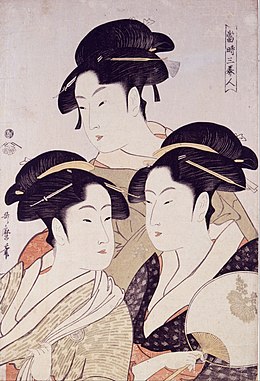
L'ukiyo-e (浮世絵, terme japonais signifiant « image du monde flottant ») est un mouvement artistique japonais de l'époque d'Edo (1603-1868) comprenant non seulement une peinture populaire et narrative originale, mais aussi et surtout les estampes japonaises gravées sur bois.
Après des siècles de déliquescence du pouvoir central suivis de guerres civiles, le Japon connaît à cette époque, avec l'autorité désormais incontestée du shogunat Tokugawa, une ère de paix et de prospérité qui se traduit par la perte d'influence de l'aristocratie militaire des daimyos, et l'émergence d'une bourgeoisie urbaine et marchande. Cette évolution sociale et économique s'accompagne d'un changement des formes artistiques, avec la naissance de l’ukiyo-e et des techniques d'estampe permettant une reproduction sur papier peu coûteuse, bien loin des peintures de l'aristocratique école Kanō.
Les thèmes de l’ukiyo-e sont également tout à fait nouveaux, car ils correspondent aux centres d'intérêt de la bourgeoisie : les jolies femmes et les oiran (courtisanes) célèbres, les shunga (scènes érotiques), le théâtre kabuki et les lutteurs de sumo, les yōkai (créatures fantastiques), les egoyomi (calendriers) et les surimono (cartes de vœux), le spectacle de la nature et des meisho-e (lieux célèbres).
Alors qu'il passe au Japon pour vulgaire, parce qu'il valorise des sujets issus du quotidien et se voit publié massivement grâce à la technique d'impression de l'estampe, ce genre connaît à la fin du XIXe siècle un grand succès auprès des Occidentaux. Après l’ouverture forcée par l'attaque des Navires noirs américains et la signature du traité inégal de la Convention de Kanagawa, le pays est forcé d'accepter le commerce avec le monde occidental (États-Unis, Royaume-Uni, France, Pays-Bas et Russie) à partir de 1858. L'arrivée en grande quantité de ces estampes japonaises en Europe et la naissance du japonisme influencent alors fortement la peinture européenne et, en particulier, l'école de Pont-Aven avec Camille Pissarro, Paul Cézanne, Émile Bernard puis Paul Gauguin[2], et les impressionnistes.
Interprétation de l'expression « monde flottant »
[modifier | modifier le code]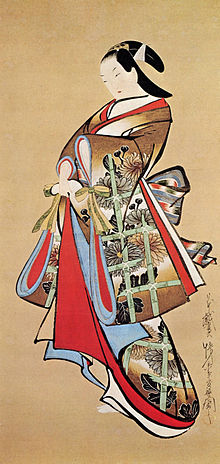
Ukiyo (浮世, « monde flottant »), dans son sens ancien, est lourdement chargé de notions bouddhiques, avec des connotations mettant l'accent sur la réalité d'un monde où la seule chose certaine, c'est l'impermanence de toutes choses[3]. C'est là pour les Japonais un très vieux concept qu'ils connaissent depuis l'époque de Heian (794-1185)[N 1].
Ce mot empreint de résignation, les habitants d'Edo (et, avec eux, ceux d'Ōsaka et de Kyōto) le reprennent au XVIIe siècle en le détournant de son sens à une époque où leur ville connaît une remarquable expansion due à son statut nouveau de capitale ainsi qu'à la paix qui règne désormais.
Le terme ukiyo apparaît pour la première fois dans son sens actuel dans Les Contes du monde flottant (Ukiyo Monogatari), œuvre de Asai Ryōi parue vers 1665, où il écrit dans la préface[1] :
Vivre uniquement le moment présent,
se livrer tout entier à la contemplation
de la lune, de la neige, de la fleur de cerisier
et de la feuille d'érable... ne pas se laisser abattre
par la pauvreté et ne pas la laisser transparaître
sur son visage, mais dériver comme une calebasse
sur la rivière, c'est ce qui s'appelle ukiyo[3].
L'utilisation du mot ukiyo (« monde impermanent ») pour qualifier les « images » (e) — estampes et peintures — de l'époque est difficile à interpréter pour les Occidentaux qui découvrent l’ukiyo-e dans la seconde moitié du XIXe siècle : ses connotations, son ironie latente — il est chargé de religiosité alors qu'il désigne la vie bouillonnante qui tourne notamment autour des « maisons vertes » et du « quartier réservé » du Yoshiwara — suscitent quelques interrogations. Edmond de Goncourt, amateur d'art japonais[4], s'efforce de les lever en posant la question à Hayashi, l'interprète japonais de l'Exposition universelle de 1878, qui deviendra l'un des grands pourvoyeurs de l'Occident en estampes. Celui-ci lui répond que « votre traduction de ukiyo-e par l'école du monde vivant […] ou de la vie telle qu'elle se passe sous nos yeux […] rend exactement le sens[3] ».
La transposition qui figure dans certains ouvrages français, « Image de ce monde éphémère[5] », paraît pertinente car rendant compte tout à la fois de la notion d'impermanence bouddhique et de l'insouciance d'une société en pleine mutation, attachée à décrire les plaisirs de la vie quotidienne telle qu'elle est.
L'estampe ukiyo-e, un art à la portée de tous
[modifier | modifier le code]Cette forme d’art connaît une grande popularité dans la culture métropolitaine d'Edo durant la seconde moitié du XVIIe siècle, naissant dans les années 1670 avec les travaux monochromes de Moronobu qui en fut le premier chef de file[N 2].
Aspects économiques
[modifier | modifier le code]Initialement, les estampes étaient exclusivement imprimées à l’encre de Chine sumi ; plus tard, certaines estampes sont rehaussées de couleurs apposées à la main[6] — ce qui restait coûteux — puis par impression à partir de blocs de bois portant les couleurs à imprimer, encore très peu nombreuses. Enfin, dans la dernière moitié du XVIIIe siècle, Harunobu met au point la technique d’impression polychrome pour produire des nishiki-e (« estampes de brocart »).
Les ukiyo-e sont abordables financièrement car ils peuvent être reproduits en grande série (de l'ordre de quelques centaines, car après trois cents exemplaires environ, le bois s'émousse et les traits deviennent moins précis[7]). Ils sont principalement destinés aux citadins qui ne sont généralement pas assez riches pour s’offrir une peinture. Ce développement de l’ukiyo-e s'accompagne de celui d'une littérature populaire, avec les ventes importantes des kibyōshi et des sharebon[1]. Le sujet initial des ukiyo-e était la vie urbaine[1], en particulier les scènes du quotidien dans le quartier des divertissements. De belles courtisanes, des sumotoris massifs, ainsi que des acteurs de kabuki populaires sont ainsi dépeints se livrant à des activités plaisantes pour l'œil. Par la suite, les paysages connaissent également le succès.
Censure
[modifier | modifier le code]La démocratisation de l'art apportée par l'estampe ne va cependant pas sans quelques contreparties.
Les sujets politiques et les personnages dépassant les strates les plus humbles de la société n'y sont pas tolérés et n'apparaissent que très rarement. Bien que la sexualité n'y soit pas autorisée non plus, elle n'en est pas moins présente de façon récurrente. Les artistes et les éditeurs sont parfois punis pour la création de ces shunga au caractère sexuel explicite.
On peut citer à cet égard le cas d'Utamaro[8], qui fut menotté pendant 50 jours pour avoir produit des estampes représentant la femme et les cinq concubines d'un célèbre personnage de l'histoire récente, Hideyoshi. Il est vrai qu'il avait par ce biais associé à un sujet libertin le monde politique de son temps[N 3].
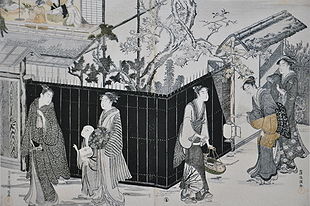
On voit ici la façon dont Shunman utilise les nuances de gris pour produire un de ses chefs-d'œuvre, malgré les limitations imposées par la censure.
Aussi les estampes doivent-elles être approuvées par la censure du bakufu, le gouvernement militaire, et porter le cachet du censeur qui en autorise l'impression[9]. Le rôle du censeur ne se limite d'ailleurs pas aux aspects de politique ou de mœurs, mais aussi, selon les époques, à la limitation des couleurs ; ainsi, les réformes de l'ère Kansei visent à lutter contre l'inflation et le luxe ostentatoire, en interdisant entre autres mesures l'emploi d'un trop grand nombre de couleurs dans les estampes, contrainte que certains artistes ukiyo-e tels que Kubo Shunman détournent de son but premier en concevant alors d'exceptionnelles estampes en subtils dégradés de gris[10].
De façon plus anecdotique, mais très révélatrice de l'attitude des autorités envers le monde de l’ukiyo-e, les édits de censure allèrent, à partir de 1793, jusqu'à interdire de faire figurer le nom des femmes sur les estampes qui les représentaient, à la seule exception des courtisanes du Yoshiwara. Ce qui donna lieu à un nouveau jeu intellectuel pour des artistes tels qu'Utamaro, qui continua à faire figurer le nom de l'intéressée… mais sous forme de rébus[11]. Cependant, la censure réagit dès le 8e mois de 1796, en interdisant dès lors de tels rébus[1].
Histoire
[modifier | modifier le code]Les ukiyo-e appartiennent à deux époques majeures de l'histoire du Japon : la période Edo, qui comprend les ukiyo-e des origines à environ 1867, puis (de façon beaucoup moins significative) l'ère Meiji qui se poursuit jusqu’en 1912. Dans son ensemble, la période Edo est plutôt calme, offrant ainsi un environnement idéal pour le développement de l’art sous une forme commerciale. L’ère Meiji, elle, se singularise par l'ouverture du Japon à l'Occident et le déclin de l’ukiyo-e traditionnel, dans son style, ses sujets et ses techniques (arrivée de couleurs chimiques, par exemple).
Naissance de la gravure sur bois au Japon
[modifier | modifier le code]
Fudō, un des douze deva, au milieu des flammes.
Bien avant l'estampe japonaise telle que nous la connaissons au travers de l’ukiyo-e, existaient au Japon des gravures sur bois, réalisées selon une technique importée de Chine[12] :
- Ce furent d'abord des gravures sur bois d'origine bouddhiste, comportant des images sacrées et des textes. La toute première estampe imprimée au Japon fut donc le Sutra du Lotus, réalisé par Koei et daté de 1225, pour le temple Kōfuku-ji à Nara, l'ancienne capitale du Japon[13] ;
- Puis l'impression d'estampes, toujours de nature religieuse, se développe à Kyōto, la nouvelle capitale, du XIIIe siècle au XIVe siècle[14]. Au XVIIe siècle, dans cette même région se développe l'art Ōtsu-e, des gravures sur bois repeintes destinées aux voyageurs et aux classes populaires[15],[16].
Origines de l’ukiyo-e
[modifier | modifier le code]Les racines de l’ukiyo-e, elles, remontent à l’urbanisation de la fin du XVIe siècle qui favorise le développement d’une classe de marchands et d’artisans. Ces derniers commencent à écrire des fictions et à peindre des images rassemblées dans des e-hon (絵本, « livres d’images » présentant des récits illustrés) (aussi ehon) ou des romans, tels que les Contes d’Ise (Ise monogatari, 1608) de Honami Koetsu[17].
Au début, les ukiyo-e sont souvent utilisés pour illustrer ces livres, mais progressivement, ils s’en affranchissent grâce aux épreuves réalisées sur une feuille volante ichimai-e[1] ou aux affiches gravées pour le théâtre kabuki. Les sources d’inspiration sont à l’origine les contes et les œuvres d’art chinois. Mais les plaisirs offerts par la capitale sont de plus en plus présents, et les guides touristiques, ceux du Yoshiwara par exemple, sont eux aussi populaires et largement répandus, puisque Moronobu édite son Guide de l'amour au Yoshiwara (吉原恋の道引, Yoshiwara koi no michibiki) dès 1678[1]. Les principes de représentation mis au point par Monorobu sont repris par tous les artistes de l'ukiyo-e : la primauté de la ligne aux dépens de l'expression des volumes, ainsi que l'extrême attention accordée aux détails décoratifs, notamment aux motifs des kimonos[18].
Puis, au XVIIIe siècle, cette image de la jolie fille (bijin) donne l'occasion, comme à Nishikawa Sukenobu, de figures à la beauté subtilement stylisée, produisant avec des kimonos splendidement ouvragés des compositions raffinées. Ces livres illustrés proposent ainsi des « catalogues » pour teinturiers. On voit aussi apparaître à la fin du XVIIIe siècle une véritable encyclopédie du monde des plaisirs, Le Grand Miroir de la voie de l'amour (色道大鏡, Shikidō ōkagami), de Kizan Fujimoto (藤本箕山, Fujimoto Kizan)[19].
Essor de l’ukiyo-e
[modifier | modifier le code]L'ukiyo-e s'est développé peu à peu, au fur et à mesure que se révélaient de grands artistes. Le « découper » en périodes serait arbitraire ; en revanche, il est possible de « regrouper » les principaux artistes ayant permis les grandes étapes, chacune correspondant à un tournant : la création des « estampes de brocart » par Harunobu, par exemple, ou encore, l'apparition, dans un laps de temps finalement très bref, des trois artistes « phares » que furent Kiyonaga, Utamaro et Sharaku.
De même, isoler l'œuvre de Hiroshige, Hokusai et leurs successeurs permet de mieux comprendre l'apparition de nouveaux sujets (les paysages), en relation avec l'influence de l'Occident.
Ces regroupements, cependant, doivent être considérés comme des courants, pouvant se chevaucher à un moment donné[20].
Les « primitifs », de 1670 à 1765 environ
[modifier | modifier le code]
À partir de 1670 environ, et après quelques balbutiements, avec Iwasa Matabei[21], l’ukiyo-e commence véritablement son envol avec Moronobu, ainsi que Sugimura Jihei, que l'on confondra d'ailleurs avec lui très longtemps[22]. Moronobu, tout particulièrement, a un rôle essentiel puisqu'on le considère généralement comme le fondateur de l'ukiyo-e, et, en tout cas, comme celui qui a su fédérer les premiers efforts pour en faire un nouveau genre abouti.
Viennent ensuite d'autres grands artistes, parmi lesquels on doit citer Kiyonobu (1664-1729), qui réalise de nombreux portraits d'acteurs de kabuki (son père Kiyomoto était lui-même acteur de kabuki[1]). Si le genre de l’ukiyo-e s'est alors déjà bien imposé, subsistent encore quelques artistes en dehors de ce style. Le plus important, le plus intéressant surtout, est sans doute Hanabusa Itchō, par sa touche vivante, brillante et originale[23].
Masanobu (1686-1764), autre grand artiste de cette période, va introduire de nombreuses innovations techniques (treize, dit-on) qui permettront à l’ukiyo-e d'évoluer, telles que la perspective occidentale, le fond micacé, ou les estampes « laquées » pour leur donner du brillant urushi-e[24]. On le crédite même de l'idée fondamentale de ne plus apposer les couleurs à la main, mais de les imprimer au moyen de blocs de bois spécifiques, en faisant appel en particulier à deux couleurs complémentaires, le rose et le vert (les benizuri-e sont imprimées en rose beni, auquel le vert vient parfois s'ajouter pour produire l'illusion d'un spectre de couleur complet)[25]. Il aurait aussi, le premier, utilisé de nouveaux formats, ōban et hashira-e[1]. Sur le plan stylistique, il fait d'autre part de nombreux portraits en pied de courtisanes, d'un style malgré tout différent de ceux que font les Kaigetsudō sur le même sujet.
L'école Kaigetsudō et leur maître, Kaigetsudō Ando, ont recours à un style dépouillé et somptueux à la fois, qui se caractérise par la peinture de grands kakemonos sur papier, mais aussi sur soie, mettant en scène des femmes hiératiques et mystérieuses. Car les Kaigetsudō, qui comptent parmi les grands noms de l’ukiyo-e, sont d'abord et avant tout des peintres, au point qu'on ne connaît de Kaigetsudō Ando aucune estampe, mais uniquement des peintures[1]. Cependant, les estampes issues de l'atelier des Kaigetsudō que l'on connaît comptent au nombre des plus précieuses de l’ukiyo-e[26].
Sukenobu, peintre de bijin (« jolies femmes ») vêtues de somptueux kimonos, amorce une évolution vers des femmes moins majestueuses, plus menues. Ainsi s'amorce un changement important de l’ukiyo-e, puisque Sukenobu est probablement l'artiste qui a eu la plus grosse influence sur Harunobu[27]. Dès cette époque, les « portraits de jolies femmes » (bijin-ga) sont le sujet majeur de l'estampe ukiyo-e, qu'il s'agisse ou non de courtisanes.
Les « estampes de brocart » (seconde moitié du XVIIIe siècle)
[modifier | modifier le code]
Vers le milieu du XVIIIe siècle, Harunobu fournit, à leur demande, des « calendriers estampes » (egoyomi) à ses riches clients. Leur goût des belles choses l'incite à mettre en œuvre les techniques les plus raffinées, débouchant, aux alentours de 1765, sur les nishiki-e, ou « estampes de brocart »[28]. Outre les bijin-ga, les portraits d'acteurs de kabuki constituent un sujet majeur, ce théâtre devenant la distraction phare de l'époque. Apparaissent également dans les estampes de Harunobu des scènes de la vie quotidienne.
Koryusai, ancien samouraï d'abord formé au style de l'école Kanō[29], continue dans la veine de Harunobu, avant d'évoluer peu à peu vers un style plus personnel[30]. De son côté, Bunchō réalise lui aussi de fort belles estampes, mais dans un style encore trop proche de celui de Harunobu pour pouvoir être considéré comme novateur. Il est cependant l'un des plus talentueux parmi les héritiers directs de Harunobu[31].
Shunshō (1726-1793), lui, sait à la fois prolonger l'œuvre de Harunobu, tout en faisant rapidement évoluer de l'ukiyo-e grâce à ses scènes de kabuki et à ses portraits d'acteurs, dans un style bien différent de celui de Kiyonobu, qui avait ouvert la voie au début du XVIIIe siècle. Ce style annonce celui de Shun'ei, et par conséquent, préfigure celui de Sharaku lui-même[32].
« L'âge d'or » (1780-1810 environ)
[modifier | modifier le code]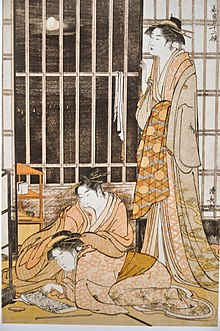

Très vite, dès 1780 environ, l'arrivée de Kiyonaga marque le début de « l'âge d'or » de l’ukiyo-e[20], qui se poursuit avec Utamaro et Sharaku, dont la maturité éclatante, presque baroque parfois[33], constitue un apogée, déjà peut-être aussi porteur des premiers signes d'une décadence[33].
L'entrée en scène de Kiyonaga ouvre une période de classicisme épanoui, d'équilibre[34], qui voit se multiplier des scènes très vivantes, que peignent aussi Utamaro, ou encore Shunchō. Elles montrent l'arrivée d'une civilisation des loisirs pour les Japonais les plus fortunés :
- Promenades en bateau sur la Sumida (pentaptyque d'Eishi[35], par exemple, ou encore Promenade nocturne sur la Sumida, d'Utamaro[36]) ;
- Embarquement pour une croisière nocturne, avec emport d'un panier-repas préparé par un restaurant (Shunchō)[37] ;
- Excursions champêtres ;
- Diptyques de Kiyonaga montrant des groupes de courtisanes avec leurs clients prenant l'air sur la terrasse des maisons vertes, surplombant d'admirables paysages[38], etc. ;
- Chasse nocturne aux lucioles (Chōki).
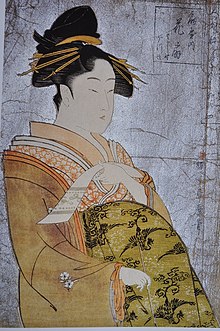
Kiyonaga innove de plusieurs points de vue : tout d'abord, il délaisse le petit format chuban, favori de Harunobu[39], au profit du grand format ōban, conduisant à des estampes d'un aspect moins intimiste. Plus encore, il introduit de grandes compositions assemblant plusieurs feuilles de format ōban, pour créer des diptyques et même des triptyques[40] ; l'idée sera reprise plus tard par Utamaro, ainsi que par Hiroshige. Ces formats plus importants permettent à Kiyonaga d'y faire évoluer ces grandes femmes sveltes, souvent en groupe, si caractéristiques de son style[40].
Utamaro, de son côté, édite des séries de portraits « en gros plan » de jolies femmes et de courtisanes (okubi-e). Dans sa lignée s'inscrivent de nombreux artistes doués, tels que Eishi, issu d'une famille de samouraïs, et ses disciples Eisho, Eisui, ou Eiri. Formé à la peinture classique avant de s'orienter vers l’ukiyo-e, Eishi illustre le genre tant par ses peintures que par ses estampes, qui mettent en scène de minces jeunes femmes d'une grâce patricienne[41].
Tant Utamaro que Sharaku ont recours à des formes d'estampe élaborées et luxueuses, faisant appel à de spectaculaires fonds micacés (kira-e), des fonds enrichis de paillettes métalliques (kiri, ou akegane, poudre de laiton, pour imiter l'or, ou de cuivre)[42], par exemple dans les Douze Heures des maisons vertes (青楼十二時, Seirōjyūnitoki), d'Utamaro, ainsi qu'à des techniques de gaufrage (kara-zuri, ou « impression à vide »), ou encore de lustrage par frottage sans encre du papier placé à l'envers sur la planche gravée (shōmen zuri)[42].
Dans le domaine de la représentation d'acteurs de kabuki, le sommet de l'ukiyo-e sera atteint avec Sharaku. Mais déjà, le caractère spectaculaire et excessif de ces estampes montre qu'il sera difficile d'aller plus loin[43].
De nouveaux thèmes (1810 à 1868 environ)
[modifier | modifier le code]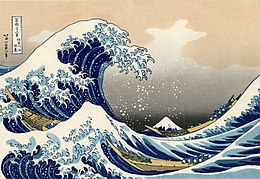
Hokusai, et Hiroshige sont les artistes dominants de l’époque[44]. À la suite de l’étude de l’art européen, la perspective fait son apparition, Toyoharu s'attachant dès 1750 à en comprendre les principes, avant de les appliquer à l'estampe japonaise[45]. D’autres idées se voient également reprises et assimilées et la représentation des paysages du Japon devient un sujet majeur.
Les œuvres de Katsushika Hokusai représentent surtout la nature et des paysages. Ses Trente-six vues du mont Fuji (富嶽三十六景, Fugaku sanjurokkei) sont publiées à partir d’environ 1831.
La représentation de la vie quotidienne, croquée sur le vif, prend aussi une grande importance, comme en témoignent les carnets des Hokusai Manga où fleurissent les petites scènes en tous genres (acrobates et contorsionnistes, scènes de bain, petits métiers, animaux divers, etc.).
De son côté, Hiroshige multiplie lui aussi les croquis pris sur le vif dans ses carnets d'esquisses, où il fige les instants et les lieux dont la contemplation l'inspire particulièrement : on voit ainsi de petits personnages s'activer dans des paysages enchanteurs, souvent le long des rives d'un fleuve[46].
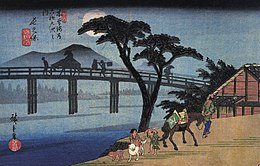
Lui et quelques autres créent de nombreuses estampes dont les motifs sont inspirés par la nature. Hiroshige, surtout, devient véritablement le chantre des paysages japonais[47], avec en particulier ses différentes « routes du Tōkaidō », hymne aux plus belles vues de la campagne sur la route reliant Tokyo et Kyoto[48].
En 1842, dans le cadre de la réforme Tenpo, les images représentant des courtisanes, des geishas ou des acteurs (par exemple : onnagata) sont interdites[49]. Ces thèmes renouent néanmoins avec le succès dès qu’ils sont de nouveau autorisés.
Pendant l’ère Kaei (1848-1854), de nombreux navires étrangers arrivent au Japon[50]. Les ukiyo-e de l’époque reflètent les changements culturels.
Ouverture du Japon et déclin de l’ukiyo-e
[modifier | modifier le code]
À la suite de la restauration Meiji en 1868, le Japon s'ouvre aux importations de l’Occident, notamment la photographie et les techniques d’imprimerie. Les couleurs naturelles issues de plantes utilisées dans les ukiyo-e sont remplacées par des teintes chimiques à l'aniline importées d’Allemagne.
La figure dominante de l'estampe japonaise pendant l'ère Meiji est sans doute Yoshitoshi, élève de Kuniyoshi, et considéré par beaucoup comme le dernier grand artiste d'estampe ukiyo-e[51]. Son style bien reconnaissable, à la fois fin, précis et empreint d'une atmosphère fantastique, n'est pas indigne de ses grands prédécesseurs. Ses estampes recourent pour leur impression à des techniques raffinées telles que le shōmen zuri (impression à l'envers, à sec), qui produit un effet de lustrage du papier et permet par exemple d'imiter la texture de la soie[52].
Au XXe siècle, durant les périodes Taishō et Shōwa, l’ukiyo-e connaît une renaissance sous la forme des mouvements shin-hanga et sōsaku hanga[53] qui cherchent tous deux à se distinguer de la tradition d’un art commercial de masse. Ironiquement, le courant shin hanga, littéralement « nouvelles épreuves », est largement encouragé par les exportations vers les États-Unis d’Amérique. S’inspirant de l’impressionnisme européen[54], les artistes intègrent des éléments occidentaux tels que les jeux de lumière et l’expression de l’humeur personnelle, mais se concentrent sur des thèmes strictement traditionnels. Le principal éditeur est alors Watanabe Shozaburo à qui l’on attribue la création du mouvement. Parmi les artistes principaux, on peut citer Itō Shinsui[N 4] et Kawase Hasui[N 5] qui sont élevés au rang de « Trésors nationaux vivants » par le gouvernement japonais.
Le mouvement sōsaku hanga (littéralement « estampe créative »), moins réputé, adopte une conception occidentale de l’art : l'estampe ne doit pas être le résultat du travail de plusieurs « artisans » (le dessinateur, le graveur, l'imprimeur), mais l'œuvre d'un « artiste » unique, à la fois peintre, graveur et imprimeur, maîtrisant l'ensemble du processus[55]. Ce mouvement s'oppose donc à l’ukiyo-e traditionnel, où les différentes étapes — le dessin, la gravure, l’impression — sont séparées et exécutées par des personnes différentes et hautement spécialisées, dont l'éditeur est souvent le chef d'orchestre. Le mouvement est établi formellement avec la formation de la Société japonaise d’épreuves créatives en 1918 mais connaît cependant un succès commercial moindre que celui du shin hanga dont les collectionneurs occidentaux préfèrent l’aspect plus traditionnellement japonais. Produisant essentiellement des estampes produites à partir de gravure sur bois (comme pour l’ukiyo-e traditionnel), le sōsaku hanga s'intéresse peu à peu de plus en plus aux procédés occidentaux que sont la lithographie, l'eau-forte, ou la sérigraphie, à partir de la fin des années 1950[56].
Des ukiyo-e sont toujours produits au XXIe siècle et demeurent une forme d’art influente, inspirant notamment les mangas et les anime[57].
Principaux artistes
[modifier | modifier le code]


Moronobu et les débuts de l’ukiyo-e
[modifier | modifier le code]- Moronobu (1618-1694), fondateur de l’ukiyo-e
- Sugimura Jihei (actif de 1681 à 1698), au style proche de Moronobu, avec qui il a longtemps été confondu
- Kiyonobu (1664-1729), fondateur de l'école Torii
- Masanobu (1686-1764), grand innovateur, et l'un des tout premiers à travailler sur la perspective occidentale
- Toshinobu (actif de 1716 à 1751), d'un style proche de Masanobu
- Toyonobu (1711-1785), d'un style proche de Masanobu
- Kaigetsudō Ando (actif de 1700 à 1714), maître de l'école Kaigetsudō
- Kaigetsudō Anchi (actif de 1704 à 1736), son élève, et peut-être son fils
- Kaigetsudō Dohan (actif de 1704 à 1716), élève d'Ando
- Kaigetsudō Doshin (actif au début du XVIIIe siècle), élève d'Ando
- Matsuno Chikanobu (actif de 1704 à 1716), au style proche des Kaigetsudo
- Baiōken Eishun (actif de 1710 à 1755 environ), au style proche des Kaigetsudo
- Miyagawa Chōshun (1683-1753), artiste de grande qualité, mais mal connu
- Sukenobu (1671-1751), artiste de Kyoto, inspirateur de Harunobu
Harunobu et ses héritiers
[modifier | modifier le code]- Harunobu (1725-1770 environ), créateur de l'« estampe de brocart »
- Suzuki Harushige (1747-1818), imitateur de Harunobu et de l'Occident, et auteur d'un livre sur Copernic
- Koryusai (1735-1790), dont le style initial est très proche de celui de Harunobu
- Shunshō (1726-1792), chef de file de l'école Katsukawa
- Bunchō (actif de 1756 à 1790), dont le style est proche de celui de Harunobu
- Katsukawa Shun'ei (1762-1819), élève de Shunshō, connu pour la qualité de ses portraits d'acteurs de kabuki
L'âge d'or de l’ukiyo-e : Kiyonaga, Utamaro, Sharaku et les autres
[modifier | modifier le code]- Kiyonaga (1752-1815), un des plus grands artistes ukiyo-e, novateur tant par le style que par la technique
- Shunchō (actif de 1770 à la fin du XVIIIe siècle), au style proche de celui de Kiyonaga
- Shunman (1757-1820), dont le style raffiné s'inspire de celui de Kiyonaga
- Katsukawa Shunzan (actif entre 1782 et 1798), au style proche de celui de Kiyonaga
- Utamaro (1753-1806), dont les estampes d’okubi-e sur fond micacé sont un des sommets de l’ukiyo-e
- Sharaku (actif en 1794 et 1795), une fulgurante carrière de quelques mois dans l'estampe de kabuki
- Eishi (1756-1829), un ancien samouraï, dont l'art élégant prolonge celui d'Utamaro
- Eisho (actif entre 1790 et 1799), élève de Eishi, proche d'Utamaro par ses okubi-e
- Eisui (actif entre 1790 et 1823), élève de Eishi, proche d'Utamaro par ses okubi-e
- Toyokuni (1769-1825), surtout connu pour ses portraits d'acteurs de kabuki
- Chōki (fin du XVIIIe-début du XIXe siècle), un talent original qui évoque un peu le style de Kiyonaga
Hokusai, Hiroshige et la fin de l’ukiyo-e traditionnel
[modifier | modifier le code]- Ryūsai Shigeharu (1803-1853)
- Toyoharu (1735-1814), dont l'étude de la perspective occidentale ouvre la voie à Hiroshige
- Hokusai (1760-1849), l'un des deux grands artistes ukiyo-e du XIXe siècle
- Hiroshige (1797-1858), son rival et son égal
- Keisai Eisen (1790-1848), travaille avec Hiroshige à la série Les Soixante-neuf Stations du Kiso Kaidō
- Kuniyoshi (1797 ou 1798-1861), dont Yoshitoshi est l'élève
- Kunisada (1786-1865), contemporain de Hiroshige
Yoshitoshi, puis le shin hanga et le sōsaku hanga
[modifier | modifier le code]- Yoshitoshi (1839-1892), le dernier grand artiste ukiyo-e
- Kunichika (1835-1900), élève de Kunisada
- Kawase Hasui (1883-1957), chef de file d'une nouvelle approche de l'estampe japonaise, le shin hanga
- Itō Shinsui (1898-1972), artiste shin hanga
Principaux thèmes
[modifier | modifier le code]Bijinga
[modifier | modifier le code]
Les bijin-ga (美人画, peintures de bijin, « peintures de jolies femmes ») constituent l'un des grands genres de la peinture et de l'estampe japonaise, au centre de l'intérêt des artistes ukiyo-e[20],[58]. Il s'agit bien souvent du portrait de courtisanes célèbres nommément identifiées et célébrées pour leur beauté.
Le bijin-ga et la représentation de courtisanes — élément essentiel de la vie sociale de l'ancien Japon[59] — est sans doute le genre qui a le plus marqué l'estampe japonaise, plus que le kabuki, et plus que la représentation des paysages, qui ne s'est véritablement développée qu'au XIXe siècle[60]. À la beauté de la femme, le bijinga associe celle de son kimono, dont la splendeur et le raffinement sont indissociables de l'attrait qu'elle exerce[61].
Le bijinga a été le sujet favori de l'estampe japonaise du début à la fin, du XVIIe siècle au XXe siècle sans discontinuer. Tous les grands noms de l’ukiyo-e ou à peu près ont fait des portraits de bijin, à des degrés divers, même si des artistes comme les Kaigetsudo, Harunobu, Sukenobu, Kiyonaga, Eishi et Utamaro s'y sont particulièrement illustrés.
Shunga
[modifier | modifier le code]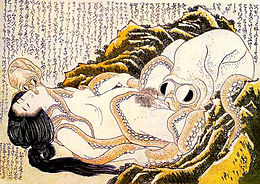
Les shunga (春画) sont des estampes japonaises érotiques, de style ukiyo-e. Shunga signifie littéralement « image du printemps ». Ce mot serait en effet dérivé de l'expression chinoise chungonghua (japonais : shunkyūga), signifiant « image du palais du printemps », en évocation de la vie joyeuse menée au palais du prince héritier[62], euphémisme poétique choisi afin d'évoquer leur caractère sexuel.
L'âge d'or des shunga se situe dans l'Époque d'Edo, entre 1600 et 1868. Si ces estampes sont clandestines, elles n'en bénéficient pas moins d'une certaine complaisance de la part du pouvoir, puisque les estampes libertines shunga ne seront saisies qu'une seule fois, en 1841[63].
Les shunga constituent très tôt une catégorie majeure au sein de l’ukiyo-e, jusqu'à en représenter une part essentielle les premiers temps, puisque, aux alentours de 1680, Sugimura Jihei, contemporain de Moronobu, leur consacre près des deux tiers de son œuvre[64].
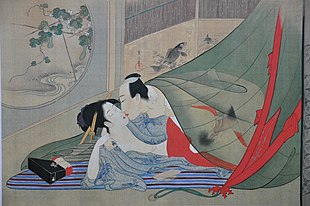
Les plus grands artistes de l'ukiyo-e s'y sont essayés : Harunobu, Shunshō, Kiyonaga, Utamaro, Eishi, Hokusai, et même Hiroshige, en ont tous produit, parfois en abondance, sous forme d'estampes, permettant une large diffusion, mais aussi, quoique plus rarement, sous forme de peintures[1].
Quant au célèbre Almanach illustré des maisons vertes (吉原青楼年中行事, Yoshiwara seirō nenjū gyōji) que publient Utamaro et Jippensha Ikku en 1804, il ne s'agit pas d'un livre de shunga, mais plutôt d'un guide sur les us et coutumes des maisons de courtisanes. Il va cependant largement contribuer à la réputation d'Utamaro en France, puisque l'artiste japonais sera surnommé en 1891, par Edmond de Goncourt, « le peintre des maisons vertes » (les maisons closes), bien qu'un tiers seulement des très nombreuses estampes connues de lui soit en réalité consacré au quartier des plaisirs, le Yoshiwara d'Edo[65].
E-goyomi, surimono
[modifier | modifier le code]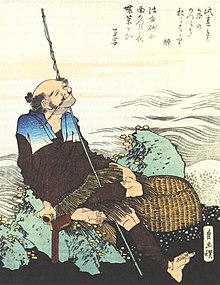
Les e-goyomi, et plus tard, les surimono qui leur succéderont[N 6], sont de luxueuses estampes de petit format faisant l'objet d'une commande privée de la part de riches particuliers. L'aisance des commanditaires permet de mettre en œuvre les techniques les plus coûteuses, ce qui conduit Harunobu à mettre au point et à populariser les « estampes de brocart », les nishiki-e, à partir des e-goyomi dont il est le plus grand artiste. Les premières estampes nishiki-e seront d'ailleurs publiées en réutilisant simplement les planches d’e-goyomi dont on a seulement retiré le nom du commanditaire et les chiffres correspondant aux mois longs[66].
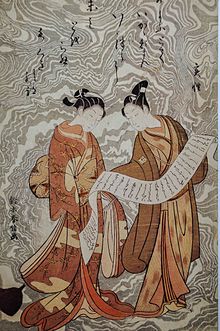
Ces e-goyomi (絵暦, littéralement « images de calendrier ») sont en effet des calendriers japonais sous forme d'estampes. Leur raison d'être se trouve dans la complexité du calendrier lunaire japonais, qui se traduit par le fait qu'à l'époque, les mois longs et les mois courts changent chaque année, sans aucune règle logique. Ces e-goyomi ont donc pour but de contourner le monopole d'état sur les calendriers, en cachant dans de luxueuses estampes, échangées lors de réunions entre amis, la liste des mois longs de l'année à venir[53].
À leur aspect purement utilitaire se mêlent des jeux de l'esprit : l'artiste doit dissimuler avec adresse les nombres indiquant les mois longs dans la composition de l'estampe. On les cache fréquemment dans les motifs géométriques de l'obi, la large ceinture, ou encore du kimono d'un des personnages féminins. Ensuite, l'artiste intègre également dans la composition des références cachées à la culture classique ou à des légendes extrême-orientales, dissimulées sous des parodies (mitate[53]) de la légende d'origine. Percer le double sens de ces calendriers constituait ainsi de plaisants défis pour les cercles littéraires[1].
Ces parodies, ces mitate, apparaissent fréquemment dans l'estampe japonaise, en dehors même des e-goyomi : on les retrouve ainsi chez Utamaro avec une parodie du « chariot brisé » (évocation d'un épisode de la lutte opposant Michizane au clan Fujiwara), ou encore une parodie des « vassaux fidèles », reprenant l'histoire des 47 ronin qui, pour l'occasion, sont remplacés par des courtisanes, ou enfin une scène d'« ivresse à trois », où l'on peut découvrir, derrière les trois courtisanes, une parodie des trois sages Confucius, Bouddha et Lao-tseu[67]
Kabuki et yakusha-e
[modifier | modifier le code]
À Edo, la capitale, après le « quartier réservé » du Yoshiwara et ses courtisanes, le théâtre de kabuki est l'autre grand pôle d'attirance pour les artistes de l'ukiyo-e.
Leur intérêt pour le kabuki est d'autant plus grand qu'ils contribuent à la publicité des théâtres et à la notoriété des acteurs que représentent les yakusha-e (役者絵)[53]. Ces « images d'acteurs de kabuki » jouent un peu le rôle des « programmes » de théâtre ou d'opéra que l'on rencontre aujourd'hui, et certains d'entre eux commémorent non seulement un acteur, mais parfois une représentation précise de la pièce dans laquelle il jouait.
Parallèlement aux portraits d'acteurs, les lutteurs de sumo sont également représentés : dès le XVIIe siècle, Moronobu illustre des livres sur le sumo, puis, plus tard, Buncho et Koryusai font les premiers portraits de lutteurs.
Enfin, l'école Katsukawa, en particulier avec Shunsho et Shun'ei, profite de son expérience des portraits d'acteurs de kabuki pour s'investir dans ceux des sumotoris. Plus tard, Utamaro, Sharaku et Hokusai s'intéresseront également aux portraits de lutteurs de sumo[68].
Faune et flore, « insectes » (kachō-ga)
[modifier | modifier le code]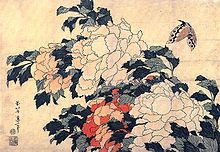
Les maîtres de l'estampe de la fin du XVIIIe siècle, et surtout du XIXe, trouvent souvent leur inspiration dans des sujets tirés de l'observation de la nature (kachō-ga[53]).
C'est le cas d'Utamaro, avec, en particulier, trois œuvres majeures : Les Insectes choisis (画本虫撰, Ehon mushi erabi), de 1788, le Livre des oiseaux (百千鳥狂歌合, Momo chidori kyōka awase), de 1791, ainsi que le célèbre livre intitulé Souvenirs de la marée basse (潮干のつと, Shiohi no tsuto), de 1790 environ, sur les coquillages et les algues abandonnés par la mer[69].

Un grand nombre de ces sujets sont regroupés sous le terme général d'« insectes » (ou mushi, 虫, en japonais), qui inclut non seulement les insectes proprement dits, mais aussi les coquillages, les escargots, et autres grenouilles et bestioles des champs.
Un mushi tout particulier se retrouve dans les estampes appelées hotaru-gari (蛍狩), les lucioles (hotaru, 蛍). Divertissements emblématiques de la période estivale japonaise, la contemplation et la chasse aux lucioles sont pratiquées par toutes les strates de la société japonaise. Plus généralement les hotaru-gari sont un mélange entre le style des bijin-ga (美人画) avec ses représentations de belles femmes en pleine chasse aux lucioles et le style de contemplation de la nature.
Après Utamaro, Hokusai et Hiroshige consacrent tous deux une part importante de leur œuvre à la représentation des fleurs et des « insectes ».
Fantastique
[modifier | modifier le code]
Le thème du fantastique est très présent dans l'ukiyo-e[70] : on le trouve chez Utamaro, ainsi que chez Hokusai, dans plusieurs estampes, mais aussi dans ses carnets de croquis, les Hokusai Manga. On le rencontre également chez Hiroshige, avec par exemple une réunion nocturne de renards surnaturels, accompagnés de feux follets sous un arbre à Ōji (près du sanctuaire shinto d'Inari), dans les Cent Vues d'Edo.
En effet, le fantastique japonais qui apparaît dans l’ukiyo-e s'appuie sur une riche tradition, au point que, selon celle-ci, lors des chaudes journées d'été, il convient de toujours placer une image de fantôme dans le tokonoma (la petite alcôve où l'on expose le kakemono), de façon à éprouver malgré la chaleur ambiante un plaisant frisson glacé[70].
Dans le monde littéraire de l'époque, Ueda Akinari écrit son ukiyo-zōshi (浮世草子) qui désigne littéralement « les romans du monde flottant », puis, en 1776, ses Contes de pluie et de lune (雨月物語, Ugetsu monogatari), recueil de neuf contes fantastiques qui inspireront en 1953 le film Les Contes de la lune vague après la pluie, de Kenji Mizoguchi.

Lafcadio Hearn, écrivain écossais, arrive au Japon en 1890, y épouse Koizumi Setsu, la fille d'un samouraï ruiné et prend la nationalité japonaise en 1896[71] ; il recueille auprès de sa femme un certain nombre des contes fantastiques qui alimentent l'inconscient japonais, pour en tirer en 1904 le livre Kwaidan (dont Masaki Kobayashi tirera plus tard le film du même nom).
Ces histoires de femmes bafouées qui reviennent hanter leur mari après leur mort, leur longue chevelure noire serpentant comme animée d'une vie propre, se retrouvent dans de nombreuses estampes. Kuniyoshi, un peu plus tard, peuple les siennes de créatures et de thèmes fantastiques[72]. Enfin, son élève Yoshitoshi, le dernier grand artiste ukiyo-e, multiplie les séries sur des thèmes fantastiques, avec ses Cent Histoires de Fantôme du Japon et de la Chine (1865-1866), et surtout avec son œuvre la plus connue, Cent Aspects de la Lune (1885-1892)[73].
Paysages (fūkei-ga) et « vues célèbres » (meisho-e)
[modifier | modifier le code]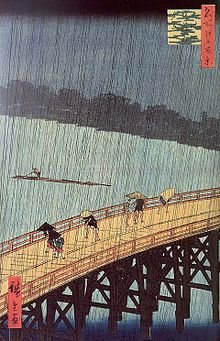
Avec l'assimilation progressive de la perspective de la peinture occidentale par les artistes japonais, à la fin du XVIIIe siècle d'abord, puis surtout au XIXe siècle, avec Hokusai et Hiroshige, l'ukiyo-e se dote de la technique nécessaire à la représentation des vues célèbres du Japon, le fūkei-ga[N 7],[74].
Appuyés sur le concept des meisho-e, l'un et l'autre se lancent alors dans la réalisation de longues séries décrivant les plus beaux sites japonais. Les plus connues de ces séries sont :
- Trente-six vues du mont Fuji, de Hokusai ;
- Vues célèbres de la capitale de l'est, de Hokusai ;
- Huit vues de Edo, de Hokusai ;
- Cent vues du mont Fuji, de Hokusai ;
- Trente-six vues du mont Fuji, de Hiroshige cette fois ;
- Huit vues d'Ōmi, de Hiroshige ;
- Cent Vues d'Edo, de Hiroshige ;
- Vues des sites célèbres des soixante et quelques provinces du Japon, de Hiroshige ;
- Les Cinquante-trois Stations du Tōkaidō, de Hiroshige,
- Les Soixante-neuf Stations du Kiso Kaidō, de Hiroshige.
Le monde réel entourant l’ukiyo-e
[modifier | modifier le code]Après une longue période de guerres civiles, Tokugawa Ieyasu écrase en 1600 une coalition de rivaux dans l'ouest du Japon au cours de la bataille de Sekigahara et devient, de facto, le dirigeant du pays. En 1603, après s'être fait attribuer le titre de shogun, il fit du village d'Edo (江戸, « porte de la rivière »), où il avait établi ses quartiers généraux, la nouvelle capitale du Japon. C'est le futur Tokyo et le début de l'ère Edo.
Changements économiques et sociaux pendant l'ère Edo
[modifier | modifier le code]Paix civile retrouvée, expansion démographique et économique
[modifier | modifier le code]
Obsédé par le souci d'éviter à son pays les secousses et les guerres civiles que le Japon connaît depuis quarante ans, guerres d'ailleurs précédées par la désagrégation du pouvoir central au cours des siècles précédents, le shogun Tokugawa Ieyasu, le nouveau maître du Japon, s'engage en 1603 dans la longue période d'immobilisme politique et technologique qui caractérise l'ère Edo. Cet immobilisme délibéré s'accompagne d'une paix enfin retrouvée, d'une prospérité économique remarquable, sur fond de très forte croissance démographique : en 120 ans en effet, soit de 1600 à 1720, la population du Japon fait sans doute beaucoup plus que doubler, passant de 12 à 31 millions d'habitants[75].
Cela s'accompagne d'un isolationnisme de plus en plus marqué, jusqu'au point culminant de 1638, après la rébellion de Shimabara en 1637-1638, au cours de laquelle 37 000 chrétiens japonais révoltés sont massacrés dans la région de Nagasaki. À partir de cette date, les relations avec le reste du monde cessent presque totalement, Tokugawa Ieyasu prenant quand même la précaution de laisser Nagasaki jouer le rôle de fenêtre ouverte sur l'Occident, par le truchement des commerçants hollandais[76].
Neutralisation des samouraïs
[modifier | modifier le code]Sur le plan intérieur, le problème essentiel est de neutraliser la forte population de samouraïs, devenue inutile à la suite de la pacification du pays. Tokugawa Ieyasu s'appuie pour cela sur le système de la « résidence alternée », le sankin kotai, qui oblige les daimyos à passer une année sur deux à Edo, en y laissant à demeure leur famille en otage. Cette double résidence a non seulement l'avantage d'offrir un moyen de pression sur les daimyos par la prise d'otages, mais aussi celui de peser lourdement sur leurs finances personnelles, obligés qu'ils sont de se déplacer avec leur suite entre deux résidences dont ils doivent assurer l'entretien[77].
En revanche, ce système conduit à la présence constante à Edo d'une population très importante de samouraïs oisifs. Cette gent turbulente, inoccupée, constitue une bonne partie de la clientèle du quartier des plaisirs d'Edo, le Yoshiwara.
Ascension sociale de la bourgeoisie et des marchands
[modifier | modifier le code]
Simultanément, les marchands, qui occupaient jusque-là la position la plus basse dans la hiérarchie sociale, s'assurent, dès la fin du XVIIe siècle, un rôle dominant dans la vie économique. Certains acquièrent une fortune considérable, telle la famille des Mitsui, qui fonde au XXe siècle un empire économique, alors que dans le même temps, la caste militaire, daimyos et samouraïs, connaît de graves difficultés financières[78].
Signe révélateur de cette évolution, certaines estampes peuvent en réalité être considérées comme des annonces publicitaires : ainsi, Utamaro en publie plusieurs séries, telle que la série de neuf intitulée Dans le goût des motifs d'Izugura, réalisée pour promouvoir de grandes enseignes de magasins de textile (Matsuzakaya, Daimaru, Matsuya, etc.), dont le logo apparaît de façon ostensible ; plusieurs de ces magasins existent encore de nos jours[79]. De même, il publie une série de six estampes (Six sélections de courtisanes et de sakés), où il associe courtisanes célèbres et marques de saké fameuse[1].

C'est cette bourgeoisie urbaine de marchands qui marque de son empreinte l'évolution de l'art : l'aristocratie militaire appauvrie cesse d'orienter la demande artistique, qui devient d'inspiration populaire sous l'impulsion première des bourgeois, suivis par les samouraïs oisifs qui ne tardent pas à les rejoindre[80]. Cette société nouvelle et composite recherche la compagnie des geishas, dîne en charmante compagnie à la terrasse de restaurants raffinés comme le Shikian[81], organise des excursions sur la Sumida[36],[82] ou dans la campagne environnante, lit des livres licencieux ou amusants, achète les guides du quartier des plaisirs et les portraits de jolies femmes publiés par Tsutaya Juzaburo. Cette même clientèle préfère les joyeux spectacles de kabuki au nô hiératique, et achète les portraits de ses plus célèbres acteurs, peints par Sharaku.
L’ukiyo-e est donc un art éminemment populaire. Plus que tout autre, il est imprégné du monde dans lequel baignaient ses artistes. Apprécier l’ukiyo-e, c'est donc s'efforcer de connaître et de comprendre les éléments qui composent ce monde, les distractions et les loisirs de la population urbaine aisée qui se développe à cette époque.
Courtisanes et quartiers réservés
[modifier | modifier le code]
Le Yoshiwara est un quartier réservé (kuruwa), créé à Edo dès 1617[83], fermé d'une enceinte, dont les accès sont alors gardés. Les samouraïs doivent y laisser leurs armes à l'entrée. Une fois à l'intérieur, la hiérarchie sociale traditionnelle s'efface : un client avec de l'argent est le bienvenu, qu'il soit roturier ou samouraï. Toutes sortes de catégories sociales, hommes d'affaires, samouraïs, dandys, écrivains et peintres s'y côtoient. On se croise dans les « maisons vertes », mais aussi dans les maisons de thé, les restaurants, les boutiques de luxe ou les établissements de bains[84].
Si, à l'intérieur des quartiers réservés, la hiérarchie extérieure n'a plus cours, une autre hiérarchie se dessine, avec ses rituels et son étiquette. Par exemple, les courtisanes sont divisées en plusieurs échelons, jusqu'à huit[19].
Les peintres de l'ukiyo-e sont en même temps les peintres du Yoshiwara. Ils en assurent dans les faits la promotion par la vente, pour des sommes modiques, du portrait des plus célèbres courtisanes du moment.
La notoriété et le rôle des plus grandes courtisanes sont à cette époque souvent fondés sur bien autre chose que l'aspect purement sexuel : les talents musicaux, l'esprit de repartie, la culture des tayu (l'élite des courtisanes) et des oiran les distinguent des simples prostituées.
D'autre part, les tayu et les oiran, vêtues de leurs vêtements complexes et chatoyants, et chaussées de leurs hautes geta, contribuent à déterminer la nouvelle mode au cours de leur grande parade[85], l'oiran dōchū.
Le monde du théâtre
[modifier | modifier le code]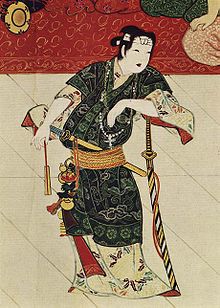
Fondé selon la tradition en 1603, à l'orée de l'ère Edo, par Izumo no Okuni[86], une ancienne « gardienne de sanctuaire » shinto devenue danseuse[87], le kabuki est ensuite, dans un premier temps, un art très populaire joué par des prostituées (yūjo kabuki)[87]. Alors qu'elles se trouvent confinées dans les quartiers réservés, se développe aussi une forme de kabuki (wakashu) joué par des éphèbes. Les représentations en sont souvent l'occasion de désordres, ce qui conduit à son interdiction en 1652. Cet art cède alors la place au yarō kabuki[88], joué uniquement par des hommes adultes, forme de kabuki plus scénique et plus artistique, qui a perduré jusqu'à aujourd'hui[89].
À la différence du nô, qui a recours à des masques pour dépeindre les personnages, le kabuki, lui, montre les acteurs à visage découvert, leur expression étant cependant amplifiée par le maquillage[90] ; les acteurs ont coutume de marquer les moments clés de la représentation par un mie, instants pendant lesquels ils s'immobilisent et figent leur expression, pour que le public puisse en apprécier toute l'intensité, pendant qu'une phrase musicale discordante en souligne l'effet, déchaînant l'enthousiasme des spectateurs[91].
Si, à Kyoto, le style yatsushi raconte souvent l'histoire d'un jeune seigneur tombant follement amoureux d'une prostituée, le public d'Edo va préférer des histoires de héros, dotés de pouvoirs surhumains qu'ils mettent à profit pour punir les méchants[86]. Ce type de pièce sera illustré par Ichikawa Danjuro I, qui appartient à une longue et fameuse lignée d'artistes de kabuki[86]. La pièce épique Chushingura, narrant l'histoire des 47 ronin, les 47 samouraïs « sans maître » vengeant leur maître mort injustement, est également très populaire, et sera mise en scène par Hokusai dans plusieurs estampes[92], ou encore, avant lui, sous forme de mitate (parodie), par Utamaro[93].
Le kabuki est d'autre part le cadre d'une crise impliquant le monde de l'ukiyo-e, lors du scandale Ejima, qui met fin à la carrière de Kaigetsudo Ando[94].
Les liens entre l'ukiyo-e et le kabuki sont en effet très étroits : le kabuki devient rapidement l'un des principaux sujets des estampes ukiyo-e qui en assurent la promotion, par les estampes qui marquent les représentations mémorables (telles que celles qui marquaient la prise de rôle par un nouveau titulaire), ou encore par les affiches publicitaires peintes par des artistes comme Kiyonobu ou Kiyomasu, dont quelques très rares exemplaires sont parvenus jusqu'à nous[95]. Car le kabuki est au cœur du monde des plaisirs auxquels se livre la nouvelle bourgeoisie et les samouraïs oisifs et dont l’ukiyo-e est le chantre.
Le sumo
[modifier | modifier le code]
L'histoire du sumo remonte aux temps les plus reculés du Japon, puisque le Kojiki, le Récit des temps anciens, paru en 712[96], fait mention d'un combat qui se serait déroulé dans les temps légendaires devant l'empereur Suinin[97]. Le sumo est par ailleurs lourdement chargé de symbolique shinto, et les premiers combats sont peut-être apparus en tant que rituels dédiés aux dieux. Pendant toute la période Muromachi, et au XVIe siècle encore, le sumo continue à exister en tant que manifestation religieuse[98].
Puis, au début de l'ère Edo, le sumo prend le caractère d'un spectacle, tenu au seul bénéfice des daimyos et à titre purement privé, car le shogun craint les troubles que ces combats pourraient engendrer et en interdit la tenue publique[99].
Ce n'est qu'en 1684 que ces interdictions sont levées[99] ; dès lors, le sumo devient un sport de professionnels, très populaire à Edo. Les lutteurs sponsorisés par les daimyos bénéficient du statut de samouraï[68].
Les « Cinq Routes » et les paysages du Japon
[modifier | modifier le code]

Parmi les vues célèbres, les meisho, qui inspirent les artistes, les routes du Tōkaidō et du Kiso Kaidō méritent une attention particulière par leur importance dans le monde du Japon de l'ère Edo.
La première est le Tōkaidō, la route qui relie Tokyo à Kyōto. Cette artère, jalonnée de 53 « stations » ou relais, est la plus importante et la plus fréquentée, et longe par endroits le littoral, représentant une distance totale d'environ 500 kilomètres ; les voyageurs mettent à peu près deux semaines à la parcourir, la plupart du temps à pied, mais aussi à cheval, en chaise à porteurs ou en palanquin, selon leur aisance financière[100].
La seconde s'appelle le Kiso Kaidō. Appelée aussi route du Nakasendō (c'est son nom officiel), et dotée de 69 « stations », elle relie également Tokyo à Kyōto, mais par un parcours alternatif, passant par le centre de Honshū, d'où son nom, qui signifie « route de la montagne du centre ».

Ce sont les plus connues des « Cinq Routes » du shogunat Tokugawa. Cela explique pourquoi Hiroshige a si souvent représenté le Tōkaidō, et pourquoi il a ensuite réalisé une série d'estampes sur le Kiso Kaidō, collaborant pour l'occasion avec Eisen.
Ces « Cinq Routes » (五街道, Gokaidō) sont les cinq voies majeures (kaidō) qui partaient d'Edo (aujourd'hui Tokyo) pendant la période Edo, dont la plus importante est donc la route du Tōkaidō. C'est le shogun Tokugawa Ieyasu qui commence leur construction en 1601, de façon à renforcer son contrôle sur le pays. De nombreuses stations (shukuba) sont installés tout au long pour permettre aux voyageurs de se reposer et de se ravitailler.
Les trois autres routes sont :
- Le Kōshū Kaidō, qui relie Edo à la province de Kai, préfecture de Yamanashi, à l'ouest d'Edo, avant de rejoindre la route du Kiso Kaidō[101] ;
- Le Ōshū Kaidō, reliant Edo à la province de Mutsu, préfecture de Fukushima[102], au nord d'Edo ;
- Enfin, le Nikkō Kaidō, qui relie Edo à Nikkō Tōshō-gū, dans l'actuelle préfecture de Tochigi[103], vers le nord-nord-ouest d'Edo.
Plus que les autres séries d'estampes, peut-être, celles d'Hiroshige, qui décrivent le Japon tout au long du Tōkaidō[N 8] (formats ōban et chūban) et du Kiso Kaidō (format ōban), permettent de se représenter un monde aujourd'hui disparu : paysans, portefaix, tenanciers d'auberge, bateliers et passeurs, pèlerins et religieux, daimyos accompagnés de leur suite[100], peuplent de magnifiques paysages encore sauvages.
Ce sont ces paysages qu'il faut imaginer en toile de fond du roman picaresque de Jippensha Ikku, le Tōkaidōchū Hizakurige (À pied sur le Tōkaidō), son chef-d'œuvre, publié en douze parties entre 1802 et 1822 ; cette œuvre, qui narre les aventures de deux hommes insouciants sur le grand chemin du Tōkaidō, est souvent considérée comme le livre de gesaku le plus réussi[104].
Technique de l'estampe ukiyo-e
[modifier | modifier le code]Fabrication d'une estampe
[modifier | modifier le code]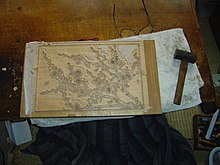

Pour éviter toute confusion :
- Il existe des œuvres ukiyo-e qui ne sont pas des estampes : c'est le cas des peintures telles que celles des Kaigetsudo et de la plupart des artistes ukiyo-e ;
- En sens inverse, il existe des estampes sur bois qui ne sont pas de l'ukiyo-e : c'est le cas par exemple des estampes bouddhistes.
Mais c'est bien dans le cadre de l'ukiyo-e que l'estampe japonaise, gravée sur bois, a connu son plein développement. Et, en sens inverse, c'est grâce aux nombreux tirages autorisés par l'estampe que l'ukiyo-e a pu devenir aussi populaire.
Les épreuves d’estampes ukiyo-e sont produites de la manière suivante[44],[105],[106],[107] :
- L’artiste réalise un dessin-maître à l’encre, le shita-e ;
- L’artisan graveur colle ce dessin contre une planche de bois (cerisier ou catalpa), puis évide à l'aide de gouges (marunomi) les zones où le papier est blanc, créant ainsi le dessin en relief sur la planche, mais détruisant l’œuvre originale au cours de ce processus ;
- La planche ainsi gravée (« planche de trait ») est encrée et imprimée de manière à produire des copies quasiment parfaites du dessin original ;
- Ces épreuves sont à leur tour collées à de nouvelles planches de bois, et les zones du dessin à colorer d’une couleur particulière sont laissées en relief. Chacune des planches imprimera au moins une couleur dans l’image finale. Ce sont les « planches de couleurs » ;
- Le jeu de planches de bois résultant est encré dans les différentes couleurs et appliqué successivement sur le papier. Le parfait ajustement de chaque planche par rapport au reste de l'image est obtenu par des marques de calage appelées kento. L'encrage est obtenu en frottant le papier contre la planche encrée à l'aide d'un tampon (baren) en corde de bambou[108].
L’impression finale porte les motifs de chacune des planches, certaines pouvant être appliquées plus d’une fois afin d’obtenir la profondeur de teinte souhaitée.
Qu'est-ce qu'une « estampe originale » ?
[modifier | modifier le code]La fabrication d'une estampe japonaise ne fait pas seulement intervenir l'artiste ; le dessin qu'il a réalisé n'est que la première étape d'un processus complexe, faisant appel à plusieurs intervenants (l'artiste, l'éditeur, le(s) graveur(s), le ou les imprimeurs).
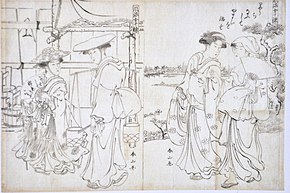

La connaissance de quelques points de cette fabrication est indispensable pour bien comprendre ce qu'est une « estampe japonaise originale » :
- Chaque estampe imprimée à partir des plaques de bois gravées originales est un original, et il n'y a pas d'autre œuvre originale : le dessin préparatoire d'origine (le shita-e, « l'image de dessous »), réalisé par l'artiste lui-même est généralement « totalement détruit » par le processus de gravure de la planche portant les traits de contours[109]. Qui plus est, même lorsque le dessin original est conservé (en général parce que l'artiste a fait graver une autre version du dessin), il est fréquent qu'il ne paraisse pas « terminé », et qu'en particulier, il ne porte aucune couleur ; on trouve aussi des dessins originaux comportant des empiècements de morceaux de papier découpés, puis collés sur les parties à corriger, qui sont les repentirs de l'artiste[109] ;
- Ce n'est pas l'artiste lui-même qui grave les plaques de bois originales, mais un graveur très expérimenté[N 9], qui peut être connu de l'artiste, qui supervise personnellement l'édition en tout état de cause. Toute regravure ultérieure de l'œuvre, effectuée sans la supervision de l'artiste, ne sera donc pas un original, quelle que soit sa qualité d'exécution. En revanche, le succès de certaines estampes (telles que la série du Tōkaidō d'Hiroshige) a pu être tel qu'il a nécessité plusieurs regravures voulues par l'artiste[110], d'ailleurs pas toujours identiques ;
- Ce n'est pas le graveur qui va imprimer les estampes finales, aboutissement du processus, mais des artisans spécialisés, utilisant le baren (tampon de bambou servant à frotter le papier sur la planche encrée) et le kento (pour s'assurer que chaque planche vient exactement s'imprimer à sa place, sans mordre sur les autres) ; l'impression des différentes couleurs se fait dans un ordre précis, pouvant impliquer jusqu'à une dizaine d'impressions successives[N 10], en commençant par le noir[111] ;
- Il peut exister plusieurs versions originales d'une même estampe ; l'un des exemples les plus connus est un portrait de Naniwaya Okita tenant une tasse de thé, fait par Utamaro : la première version comporte un rébus pour transcrire le nom de la belle Okita en dépit de la censure ; lorsque même les rébus furent interdits pour désigner les modèles, Utamaro le remplace par le portrait d'un poète. Sans aller jusqu'à cet exemple extrême, les variantes de l'arrière-plan d'une estampe sont fréquentes[N 11].
Le premier tirage de l'estampe se poursuit jusqu'à ce que l'usure du bois commence à donner des traits moins nets et des repères de couleurs moins exacts ; l'édition originale est alors en principe terminée, ce qui peut représenter un total de l'ordre de trois cents estampes environ[7]. Cependant, la résistance du bois permet des tirages beaucoup plus importants dans des conditions acceptables de qualité (comme on le voit sur des regravures modernes) et, dans la mesure où les estampes de la toute première série n'étaient pas physiquement identifiées, on ne peut pas aujourd'hui connaître, ni le rang d'édition d'une estampe, ni l'importance réelle du tirage[7].
Types d'estampe et couleurs
[modifier | modifier le code]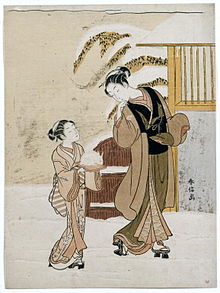
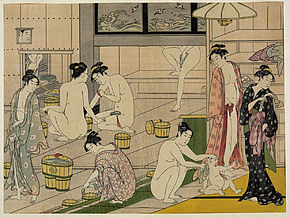
Différenciation des estampes
[modifier | modifier le code]Les Japonais différencient plusieurs types d'estampes[112] :
- Selon le format du papier utilisé
- Chūban (中判, 25 à 26 cm × 17 à 19 cm) ;
- Ōban (大判, 37 à 38 × 25,5 cm) ;
- Hashira-e (柱絵, 70 à 75 cm × 12 à 14,5 cm) ;
- Hosoban (細判, 33 × 15 cm) ;
- Nagaban (長判, approximativement 20 × 50 cm) ;
- Aiban, approximativement 34 cm × 22 cm ;
- Ō-ōban, ou grand ôban, approximativement 58 cm × 32 cm.
- Selon l'orientation[113]
- Tate-e : orientation « portrait » ;
- Yoko-e : orientation « paysage ».
- Selon les couleurs appliquées et surtout leur nombre[114]
- Sumizuri-e (墨摺り絵), sans aucune couleur, donc en noir et blanc ;
- Tan-e (丹絵), sumizuri-e rehaussée à la main de la couleur orange tan ;
- Urushi-e (漆絵), utilisant une encre épaissie avec de la colle pour la rendre brillante ;
- Beni-e (紅絵), sumizuri-e rehaussée à la main de la couleur beni ;
- Benizuri-e (紅摺り絵), colorée par impression avec la couleur beni (le vert étant parfois ajouté) ;
- Nishiki-e (錦絵), la plus « riche », car faisant appel potentiellement à toutes les couleurs.
Pigments utilisés
[modifier | modifier le code]Les couleurs utilisées sont nombreuses, faisant appel à des pigments d'origine naturelle (végétale ou minérale), et d'une rare délicatesse de nuance, avant que l'arrivée de colorants chimiques occidentaux ne vienne modifier la donne[115] :
- Sumi : encre de Chine, pour reproduire le dessin lui-même ;
- Tan : rouge d'oxyde de plomb ;
- Beni : rose tiré du safran ;
- Ai : bleu foncé à base d'indigo ;
- Shoenji : rouge extrait du millepertuis ;
- Murasaki : violet (mélange de rouge de millepertuis et de bleu indigo ;
- Gofun : blanc lumineux à base de poudre d'huître[108]. Uniquement apposé à la main, donc sur des peintures ou, parfois, sur des sumizuri-e rehaussées à la main.
Influences artistiques entre Japon et Occident
[modifier | modifier le code]Découverte de la peinture occidentale par les Japonais
[modifier | modifier le code]De façon surprenante, les artistes japonais découvrent la peinture occidentale bien avant que l'Occident lui-même ne découvre l'art japonais. En effet, dès 1739, Okumura Masanobu entreprend pour la toute première fois l'étude de la perspective utilisée dans les images (uki-e, « image flottante ») venant d'Occident. Il a pour cela le soutien du shogun, du fait de l'intérêt que celui-ci porte aux sciences occidentales.

Puis, dès 1750 environ, Toyoharu s'attache à comprendre de façon approfondie les règles de la perspective utilisée dans la peinture occidentale depuis Paolo Uccello. Il s'essaie tout d'abord à copier librement certaines gravures sur cuivre (reproduisant des œuvres de Guardi et de Canaletto, par exemple), ce qui conduit à d'étonnantes estampes montrant les gondoles sur le Grand Canal à Venise, sur fond d'église de la Salute[45].
Il produit ensuite des estampes qui traitent de sujets japonais en faisant appel à une perspective « occidentale » (utilisation de lignes de fuite). Il publie de telles estampes dès les années 1760, avec, par exemple, une vue du quartier du kabuki la nuit publiée en 1770[116].
Sans l'œuvre de Toyoharu, il est probable que ni l'œuvre de Hiroshige ni celle de Hokusai n'auraient été les mêmes. Plus tard, Kuniyoshi produira aussi quelques estampes influencées fortement par la peinture italienne.
Outre la perspective, une autre découverte occidentale marque profondément l'ukiyo-e, à partir de 1829 : il s'agit du bleu de Prusse, moins fragile que le bleu d'origine naturelle utilisé jusque-là. Il est dès lors utilisé de façon intensive, par Hokusai dès 1830 dans les 10 premières estampes de sa célèbre série Trente-six Vues du mont Fuji (dont la célèbre Grande Vague au large de Kanagawa), puis, entre autres artistes, par Hiroshige.
Découverte de l’ukiyo-e par l'Occident
[modifier | modifier le code]Premiers contacts et influence sur l'art occidental
[modifier | modifier le code]
Quelques pionniers, comme Isaac Titsingh dès 1827, Félix Bracquemond ou encore Théodore Duret, commencent à faire connaître l’ukiyo-e à certains artistes européens[117]. Mais l'Occident ne découvre réellement l'art de l'ukiyo-e et l'art japonais en général qu'assez tardivement, puisque la véritable prise de conscience date de l'Exposition universelle de 1867, tenue à Paris[118]. C'est d'ailleurs en France que cette influence sera la plus marquante.
Cette Exposition universelle, à laquelle, pour la première fois, le Japon participe de manière officielle, est suivie de la vente de quelque treize-cents objets[118]. Dès lors, l'impulsion est donnée, de telles ventes vont se répéter, par exemple en 1878, à l'occasion d'une rétrospective qui met Hayashi en contact avec les collectionneurs français[119].

Les premiers ouvrages historiques et critiques complets sur l'ukiyo-e sont venus d'Occident, d'Ernest Fenollosa, professeur de philosophie à l'Université impériale de Tokyo depuis 1878 et commissaire aux Beaux-Arts du gouvernement japonais depuis 1886.
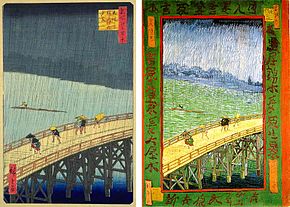
Alors que les ukiyo-e, largement supplantés par la photographie, passent de mode au Japon durant le bunmei-kaika (文明開化, le mouvement d’occidentalisation du pays au début de l’ère Meiji), ces images deviennent une source d’inspiration en Europe pour le cubisme ainsi que pour de nombreux peintres impressionnistes parmi lesquels Van Gogh, Monet, Degas ou encore Klimt. Cette influence est appelée le japonisme[120].
Collections d'estampes
[modifier | modifier le code]Dès lors, Hayashi devient l'un des tout principaux ambassadeurs de l'art japonais en France et en Occident, approvisionnant les collectionneurs en objets d'art importés.
Les artistes français de l'époque sont souvent parmi les premiers à apprécier l'art japonais, tels Claude Monet (qui rassemble une importante collection d'estampes qui est toujours visible), Degas ou encore les Goncourt.
L'engouement pour l'ukiyo-e et l'importance des grandes collections occidentales sont alors tels que les estampes rassemblées à cette époque portent le cachet du collectionneur qui, encore aujourd'hui, en permet la rigoureuse authentification et en augmente la valeur. Parmi les plus grands collectionneurs de cette époque, figurent Helen Bigelow Merriman (en) (États-Unis), Siegfried Bing (France), J. Brickmann[Lequel ?] (Allemagne), Isaac de Camondo (France), Charles Lang Freer (en) (États-Unis), Edmond de Goncourt (France), Raymond Koechlin (France), Henri Vever (France)… sans oublier Hayashi (Japon), qui, on l'a vu, ne se limite pas à son rôle d'importateur, mais sait aussi se constituer une remarquable collection[121],[122]. L'un des plus grands collectionneurs d'estampes, le comte Isaac de Camondo, lègue toute sa collection au musée du Louvre où, enrichie par d'autres apports, elle constitue la base de ce qui est aujourd'hui la grande collection du musée Guimet à Paris. Il faut d'ailleurs rendre hommage à M. Migeon, attaché au musée du Louvre à la fin du XIXe siècle, qui est dès cette époque un amateur passionné de l’ukiyo-e et n'a de cesse que le Louvre puisse se constituer une grande collection d'estampes grâce aux legs de généreux donateurs tels que Camondo[123].
Au Royaume-Uni, le rôle pionnier de Frank Morley Fletcher dans les années 1890 permet de former à cet art de nombreux graveurs tels que William Giles[124].
En , la collection d'art d'Asie de la famille Portier est vendue aux enchères à Paris (hôtel Drouot) pour plus de 1,5 million d'euros par la maison Beaussant-Lefèvre et Christie's, dont 600 000 euros au marteau (745 800 euros avec les frais) pour L'amour caché de la série « anthologie poétique : section de l'amour » d'Utamaro, un record mondial[125].
Le monde de l’ukiyo-e dans la culture populaire
[modifier | modifier le code]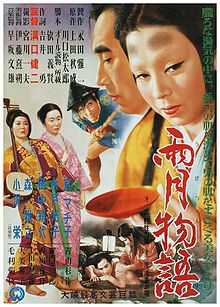
Il existe peu d'œuvres qui évoquent aujourd'hui le souvenir de l’ukiyo-e et de ses artistes.
- Le film le plus connu portant sur ce thème est sans doute Cinq femmes autour d'Utamaro de Kenji Mizoguchi (1946).
- De son côté, le seinen (« manga »), Kyōjin Kankei (Folles Passions, de 1973-1974), de Kazuo Kamimura, évoque l'ère Edo et un autre génie de l’ukiyo-e, Hokusai, et sa fille O-ei[126].
Par ailleurs, le cinéma a repris un certain nombre des thèmes de l’ukiyo-e :
- Harakiri, film de 1962 de Masaki Kobayashi, qui montre la misère des rōnin dans le monde pacifié de l'ère Edo, monde qui n'a désormais plus besoin des samouraïs ;
- Kwaidan, de 1964, de Masaki Kobayashi, qui illustre le fantastique japonais d'après les contes de Lafcadio Hearn ;
- Les Contes de la lune vague après la pluie, film de 1953 de Kenji Mizoguchi, évocation poétique du fantastique japonais ;
- Mémoires d'une geisha, film de 2005 de Rob Marshall ;
- Sakuran, film japonais de 2007, tiré du manga du même nom, qui évolue dans le monde des oiran.
Enfin, même s'il s'agit de genres bien différents, mangas et anime sont les descendants actuels d'une longue tradition qui passe par l’ukiyo-e[57]. En effet, on peut faire remonter l'origine au Japon des histoires en images aux emaki, ces rouleaux illustrés qui apparaissent au XIIe siècle. Un exemple frappant du pouvoir expressif de ces rouleaux est donné par le Chōjū-giga, les Caricatures des animaux raillant la vie des moines bouddhistes à l’époque[127]. C'est dès cette époque que les rouleaux — dont certains peuvent atteindre près de 25 mètres de long — créent l'habitude de raconter une histoire, lue de droite à gauche, sur toutes sortes de sujet. Cette tradition va se poursuivre pendant des centaines d'années, y compris chez des maîtres de l’ukiyo-e tel que Moronobu. C'est à l'apogée de l’ukiyo-e que se mettent en place les codes visuels que l'on retrouve aujourd'hui dans les mangas, de la caricature aux éclaboussures du sang qui jaillit lors des combats, et jusqu'à l'art érotique des ero manga[128].
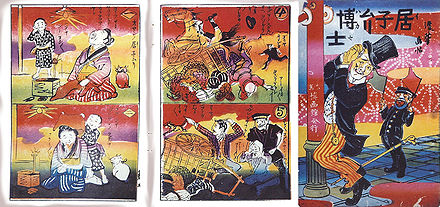
Notes et références
[modifier | modifier le code]Notes
[modifier | modifier le code]- C'est aussi une allusion ironique au terme homophone « monde souffrant » (憂き世, ukiyo), le cycle terrestre de mort et de renaissance duquel les bouddhistes cherchent à s’échapper.
- Même s'il existe des gravures ukiyo-e avant celles de Moronobu, c'est lui qui fut le premier à « consolider » ce courant naissant.
- Le pouvoir était beaucoup plus sensible aux allusions politiques qu'à celles touchant aux bonnes mœurs, et les shunga faisaient l'objet d'une complaisance tacite. Dans le cas d'Utamaro cependant, la mise en scène des concubines de Hideyoshi fut perçue comme une attaque directe contre les mœurs du shogun lui-même, déclenchant ainsi une sanction beaucoup plus lourde que celle que l'aspect léger de l'œuvre aurait entraîné à lui seul.
- En 1952, la « Commission pour la protection des propriétés culturelles » (Bunkazai hōgō tinkai) l'a déclaré « porteur de valeurs culturelles intangibles » (mukei bunkazai), ce qui est l'équivalent d'alors d'un « Trésor vivant ».
- Kawase Hasui fut déclaré « Trésor national vivant » en 1956.
- Les surimono ont une fonction plus vaste que les e-goyomi : comme ceux-ci, ils peuvent servir de calendriers indiquant les mois longs, mais on en utilisent aussi comme cartes de circonstance (Nouvel An, fêtes, anniversaires, etc.), ainsi que pour joindre un poème à une image.
- L'orientation des estampes peut être yoko-e (orientation « paysage ») ou tate-e (orientation « portrait »). C'est l'orientation tate-e qui est la plus fréquente, sauf dans le format ōban (tout au moins dans le cas des estampes de paysage (fūkei-ga) de Hokusai et de Hiroshige, qui font appel la plupart du temps à des estampes ōban d'orientation yoko-e).
- L'édition Hōeidō de 1833-1834 au format ōban est la plus connue, mais il en existe d'autres, aux formats ōban et chūban.
- Tout au moins pour la plaque portant les traits de contours, celle qui nécessite le maximum d'habileté.
- Voire nettement plus dans le cas de certaines éditions luxueuses, impliquant un fond micacé, un gaufrage, une impression sans encre (shomenzuri), ou des rehauts d'or ou d'argent, un double passage des noirs, etc.
- Un exemple célèbre est l'estampe Kambara d'Hiroshige, où la partie la plus sombre du ciel est placée tantôt en haut (la première version), tantôt en bas. Un autre exemple est le mois de septembre de Minami no Juniko, de Kiyonaga, où le fond est plus foncé, presque noir, dans les tirages tardifs.
Références
[modifier | modifier le code]- Hélène Bayou, Images du Monde Flottant - Peintures et estampes japonaises XVIIe – XVIIIe siècles, (ISBN 2-7118-4821-3), p. 20;25;34-35;48-50;160;176;188;194;232;318;352-389.
- « L’Arbre et la Forêt. Du Pays du soleil levant au Bois d’amour »(Archive.org • Wikiwix • Archive.is • Google • Que faire ?), Ville de Quimper (consulté le ).
- Sous la direction de Gisèle Lambert et Jocelyn Bouquillard 2008, p. 17.
- Edmond de Goncourt, La maison d’un artiste, la collection d’art japonais et chinois […], Paris, À Propos, , 320 p. (ISBN 9782915398199).
- Louis Aubert 1930, p. de titre.
- Richard Lane 1962, p. 38.
- Nelly Delay 2004, p. 297.
- Richard Lane 1962, p. 225.
- Nelly Delay 2004, p. 316.
- Nelly Delay 2004, p. 111-113.
- Interview de Hélène Bayou, conservatrice au musée Guimet (visible en bonus 2 du DVD « 5 femmes autour d'Utamaro »).
- Nelly Delay 2004, p. 30-33.
- Nelly Delay 2004, p. 30.
- Nelly Delay 2004, p. 31.
- Iwao Seiichi, Iyanaga Teizō, Yoshida Shōichirō et al., « 186. Ōtsu-e », Dictionnaire historique du Japon, vol. 16, , p. 129 (lire en ligne [PDF], consulté le ).
- (en) James Albert Michener, « In the village of Ōtsu », dans The Floating World, université d'Hawaï, , 453 p. (ISBN 9780824808730, lire en ligne).
- Nelly Delay 2004, p. 38.
- Hélène Prigent, « Images du Monde flottant », Le Petit Journal des grandes expositions, no 369, , p. 9-10 (ISBN 2-7118-4852-3).
- Hélène Bayou 2004, p. 36.
- Richard Lane 1962, p. 200.
- Chris Taylor, Nicko Goncharoff, Japan, Lonely Planet, , 865 p. (ISBN 9780864424938, lire en ligne).
- Howard Hibbett 2001, p. 68.
- Richard Lane 1962, p. 142.
- James Albert Michener 1983, p. 73.
- James Albert Michener 1983, p. 74.
- James Albert Michener 1983, p. 272.
- Richard Lane 1962, p. 149.
- Richard Lane 1962, p. 152.
- Richard Lane 1962, p. 168.
- Richard Lane 1962, p. 169-172.
- Richard Lane 1962, p. 169-172-177.
- Richard Lane 1962, p. 186.
- Richard Lane 1962, p. 220.
- Richard Lane 1962, p. 208.
- Nelly Delay 2004, p. 112.
- Nelly Delay 2004, p. 108.
- Nelly Delay 2004, p. 110-111.
- Tadashi Kobayashi, Mark A. Harbison 1997, p. 85.
- Tadashi Kobayashi, Mark A. Harbison 1997, p. 82-83.
- Tadashi Kobayashi, Mark A. Harbison 1997, p. 86.
- James Albert Michener 1983, p. 280.
- « Woodblock Print Terms (Vocabulaire de l’ukiyo-e) », sur ana.lcs.mit.edu (consulté le ), Printing Effects
- Richard Lane 1962, p. 192.
- Nelly Delay et Dominique Ruspoli, Hiroshige, Invitation au voyage, Paris, À Propos, 64 p. (ISBN 9782915398090), p. 58-62.
- Nelly Delay 2004, p. 172-173.
- Hiroshige : Carnets d'esquisses, Éditions Phébus, Paris, 2001. Dépôt légal : (ISBN 2-85940-768-5).
- Nelly Delay et Dominique Ruspoli, Hiroshige, Invitation au voyage, Paris, éditions A Propos, 64 p. (ISBN 9782915398090).
- Richard Lane 1962, p. 276.
- (en) Gary Leupp, Male Colors: The Construction of Homosexuality in Tokugawa Japan, Los Angeles, UC Press, , 317 p. (ISBN 0-520-20900-1, OCLC 31375972, BNF 47309851, LCCN 94040395), p. 249..
- Louis Cullen, A History of Japan 1582-1941: Internal and External Worlds, Cambridge University Press, (lire en ligne), p. 172.
- Nelly Delay 2004, p. 275.
- Nelly Delay 2004, p. 279.
- « Woodblock Print Terms (Vocabulaire de l’ukiyo-e) », sur ana.lcs.mit.edu (consulté le ), Print Classes
- Présentation du shin hanga sur artelino.com (consulté le )
- James Quandt, Cinematheque Ontario, Kon Ichikawa, Indiana University Press, (lire en ligne), p. 277.
- Helen Merritt, Nanako Yamada 1995, p. 1907.
- Robin E. Brenner, Understanding Manga and Anime, Libraries Unlimited, (ISBN 9781591583325, lire en ligne), p. 1 à 7
- « Woodblock Print Terms (Vocabulaire de l’ukiyo-e) », sur ana.lcs.mit.edu (consulté le ), Print Subjects
- Richard Lane 1962, p. 17.
- Richard Lane 1962, p. 16.
- Richard Lane 1962, p. 27.
- Sous la direction de Gisèle Lambert et Jocelyn Bouquillard 2008, p. 183.
- Sous la direction de Gisèle Lambert et Jocelyn Bouquillard 2008, p. 184.
- Richard Lane 1962, p. 58.
- Voir à ce sujet T. Clark, 1995, page 35.
- Tadashi Kobayashi, Mark A. Harbison 1997, p. 82.
- Notices correspondantes de l'exposition « Estampes japonaises. Images d'un monde éphémère », à la BnF du au .
- Sous la direction de Gisèle Lambert et Jocelyn Bouquillard 2008, p. 35.
- Louis Aubert 1930, p. 137.
- Nelly Delay 2004, p. 271.
- Jan Dodd, Simon Richmond, Japan: the Rough Guide, Rough Guides, , 838 p. (ISBN 9781858283401, lire en ligne), p. 588.
- Georges Bernier, Rosamond Bernier, L'Œil, nos 453-457, 1993, p. 99.
- Tsukioka Yoshitoshi (1839-1892), sur tanakaya.fr (consulté le )
- L’avènement de l’estampe de paysage au XIXe siècle, BnF.
- Carl Mosk, Japanese Economic Development: Markets, Norms, Structures, Routledge, 2007 (ISBN 9780415771580) p. 62.
- Edwin O. Reischauer 1973, p. 95-118.
- Edwin O. Reischauer 1973, p. 103.
- Edwin O. Reischauer 1973, p. 119-128.
- Sous la direction de Gisèle Lambert et Jocelyn Bouquillard 2008, p. 128.
- Edwin O. Reischauer 1973, p. 123.
- d'après Edmond de Goncourt 2008, p. 107.
- Nelly Delay 2004, p. 111.
- Sous la direction de Gisèle Lambert et Jocelyn Bouquillard 2008, p. 18.
- Notice sur les « quartiers réservés », à l'exposition « Estampes japonaises. Images d'un monde éphémère », à la BnF du au .
- Interview de Hélène Bayou, conservatrice au musée Guimet (visible en annexe 2 du DVD Cinq femmes autour d'Utamaro)
- Texte d'Ogita Kiyoshi sur l'histoire du kabuki
- Ronald Cavaye, Paul Griffith, Akihiko Senda, A Guide to the Japanese Stage: From Traditional to Cutting Edge, Kodansha International, (lire en ligne), p. 26.
- Yarō-kabuki. Dictionnaire historique du Japon. Persée.
- Ronald Cavaye, Paul Griffith, Akihiko Senda, A Guide to the Japanese Stage: From Traditional to Cutting Edge, Kodansha International, (lire en ligne), p. 27.
- Notice correspondante de l'exposition « Estampes japonaises. images d'un monde éphémère », à la BnF du au .
- Nelly Delay 2004, p. 146.
- Richard Lane 1962, p. 259.
- d'après Edmond de Goncourt 2008, p. 122.
- Richard Lane 1962, p. 65.
- Nelly Delay 2004, p. 149.
- Tara Magdalinski, Timothy John Lindsay Chandler 2002, p. 144.
- Ruth Kirk, Japan: Crossroads of East and West, Taylor & Francis, (lire en ligne), p. 179.
- Tara Magdalinski, Timothy John Lindsay Chandler 2002, p. 145.
- Tara Magdalinski, Timothy John Lindsay Chandler 2002, p. 149.
- Notice sur les 53 stations du Tōkaidō de l'exposition « Estampes japonaises. Images d'un monde éphémère », à la BnF du 18 novembre 2008 au 15 février 2009
- Carte du Kōshū Kaidō
- Ōshū Kaidō Map
- Nikkōdō
- Dictionnaire historique du Japon, Maison franco-japonaise, Maisonneuve et Larose, page 2699
- Nelly Delay 2004, p. 296-301.
- Présentation détaillée sur gutenberg.org (consulté le )
- Autre analyse détaillée du processus sur gutenberg.org (consulté le )
- « Woodblock Print Terms (Vocabulaire de l’ukiyo-e) », sur ana.lcs.mit.edu (consulté le ), Printing Technical Terms
- Hélène Bayou 2004, p. 298-299.
- Gabriele Fahr-Becker 2006, p. 172.
- Nelly Delay 2004, p. 300.
- « Woodblock Print Terms (Vocabulaire de l’ukiyo-e) », sur ana.lcs.mit.edu (consulté le ), Sizes
- « Woodblock Print Terms (Vocabulaire de l’ukiyo-e) », sur ana.lcs.mit.edu (consulté le ), Format and Orientation
- « Woodblock Print Terms (Vocabulaire de l’ukiyo-e) », sur ana.lcs.mit.edu (consulté le ), Print Types
- Nelly Delay 2004, p. 298.
- Richard Lane 1962, p. 238.
- (en) Louis Frédéric, Japan Encyclopedia, Harvard University Press, (ISBN 9780674017535, lire en ligne), p. 1012.
- Hélène Bayou 2004, p. 62.
- Hélène Bayou 2004, p. 62-63.
- Le japonisme et les artistes influencés par l'art du Japon sur membres.lycos.fr (consulté le )
- Nelly Delay 2004, p. 318.
- Origine des collections japonaises sur membres.lycos.fr (consulté le ).
- Hélène Bayou 2004, p. 65.
- Répertoire d'art et d'archéologie : dépouillement de périodiques français et étrangers, Paris, Champion, , p. 184 — sur Gallica.
- Valérie Sasportas, « Record du monde pour une estampe japonaise à Paris », Le Figaro, le .
- « Kyôjin Kankei »(Archive.org • Wikiwix • Archive.is • Google • Que faire ?), sur animeland.com (consulté le ).
- Robin E. Brenner, Understanding Manga and Anime, Libraries Unlimited, (ISBN 9781591583325, lire en ligne), p. 1 et 2
- Robin E. Brenner, Understanding Manga and Anime, Libraries Unlimited, (ISBN 9781591583325, lire en ligne), p. 2.
Annexes
[modifier | modifier le code]Bibliographie
[modifier | modifier le code]- Louis Aubert, Les Maîtres de l'Estampe japonaise. Image de ce monde éphémère, Paris, Librairie Armand Colin,
- Hélène Bayou, Images du Monde Flottant. Peintures et estampes japonaises XVIIe–XVIIIe siècle, (ISBN 2-7118-4821-3)
- Nelly Delay, L'Estampe japonaise, Éditions Hazan, (ISBN 2-85025-807-5)
- Gabriele Fahr-Becker, L'Estampe japonaise, Taschen, (ISBN 978-3-8228-2057-5)
- d'après Edmond de Goncourt, Utamaro, New York, Parkstone International, (ISBN 978-1-84484-488-3)
- (en) Howard Hibbett, The Floating World in Japanese Fiction, Tuttle Publishing, (ISBN 9780804834643)
- (en) Tadashi Kobayashi, Mark A. Harbison, Ukiyo-e: an Introduction to Japanese Woodblock Prints, Kodansha International, (ISBN 9784770021823)
- Gisèle Lambert et Jocelyn Bouquillard, Estampes japonaises. Images d'un monde éphémère, BnF, (ISBN 978-2-7177-2407-3)
- Richard Lane, L'Estampe japonaise, Paris, Éditions Aimery Somogy,
- (en) Tara Magdalinski, Timothy John Lindsay Chandler, With God on Their Side: Sport in the Service of Religion, Routledge, (ISBN 9780415259606, lire en ligne)
- (en) Helen Merritt, Nanako Yamada, Guide to Modern Japanese Woodblock Prints, 1900-1975, University of Hawaii Press, (ISBN 9780824817329, lire en ligne)
- (en) James Albert Michener, The Floating World, University of Hawaii Press, , 453 p. (ISBN 9780824808730)
- Timon Screech, Donald Jenkins, Michel Maucuer, Taizo Kurōda, Splendeurs des courtisanes : Japon. Peintures ukiyo-e du musée Idemitsu, Paris, Paris Musées, Musée Cernuschi, , 170 p. (ISBN 2020052725).
- Edwin O. Reischauer, Histoire du Japon et des Japonais (tome I), Éditions du Seuil, (ISBN 2-02-000675-8)
- Caroline Larroche et Olivier Morel, Ukiyo-e, Courtes et Longues Editions, coll. « 6-8 ans », , 50 p. (ISBN 978-2352900221)
- Ryūsei Kishida et Michael Lucken (Traduction), La Peinture crue: Réflexions sur l'art et l'ukiyoe, Les Belles Lettres, coll. « Collection Japon », , 210 p. (ISBN 978-2251722085)
- Collectif et Gian Carlo Calza, Ukiyo-e, Phaidon France, coll. « Beaux Arts », , 520 p. (ISBN 978-0714864143)
- Henri-Alexis Baatsch, Hokusai. Le fou de dessin, Hazan, coll. « Monographie », , 224 p. (ISBN 978-2754107839)
- Olaf Mextorf, Estampes japonaises, Place des Victoires, , 320 p. (ISBN 978-2809913590)
- Nelly Delay, L'Estampe japonaise. Edition 2018, Hazan, coll. « Beaux-Arts », , 328 p. (ISBN 978-2754110549)
- Nelly Delay et Dominique Ruspoli, Hiroshige, Invitation au voyage, Paris, Éditions À Propos, 64 pages (ISBN 9782915398090).
Liens externes
[modifier | modifier le code]
- Notices dans des dictionnaires ou encyclopédies généralistes :
- Musée Cernuschi, 2021 : Dans le cadre de l'exposition "Voyage sur la route du Kisokaidō. De Hiroshige à Kuniyoshi" : cycle de trois conférences en ligne : [1]
- (en) « Woodblock Print Terms (Vocabulaire de l’ukiyo-e) », sur ana.lcs.mit.edu (consulté le ).
- « Musée national des Arts asiatiques: Musée Guimet », sur museeguimet.fr.
- (en) « A Guide to the Ukiyo-e Sites of the Internet », sur user.bahnhof.se : page contenant de très nombreux liens, par Hans Olof Johansson.
- (en) « Process of Wood-block Printing », sur baxleystamps.com, Nishinomiya & Hasegawa, Inc (consulté le ), étapes de fabrication d'une estampe par l'exemple ("Shono" from the 53 Stations of the Tokaido by Hiroshige).
- « L'estampe japonaise (exposition) », sur BnF (consulté le ) et : Repères, ainsi que : Toutes les estampes, avec notices et zoom en haute définition.
- (en) « Davidson Art Center (Middletown, Conn.) Wesleyan university (Middletown, Conn.) », sur earningobjects_devel.wesleyan.edu (consulté le ) : le site en Flash présente la technique de l'ukiyo-e à partir de la collection d'estampes japonaises des XVIIIe et XIXe siècles du Davidson Art Center].
- (en) « University of California, San Francisco: Japanese Woodblock Print Collection », sur sian.library.ucsf.edu.
- « Collection numérisée de l'Ukiyo-e dans la Biblioteca Digital Hispánica », sur bne.es.

